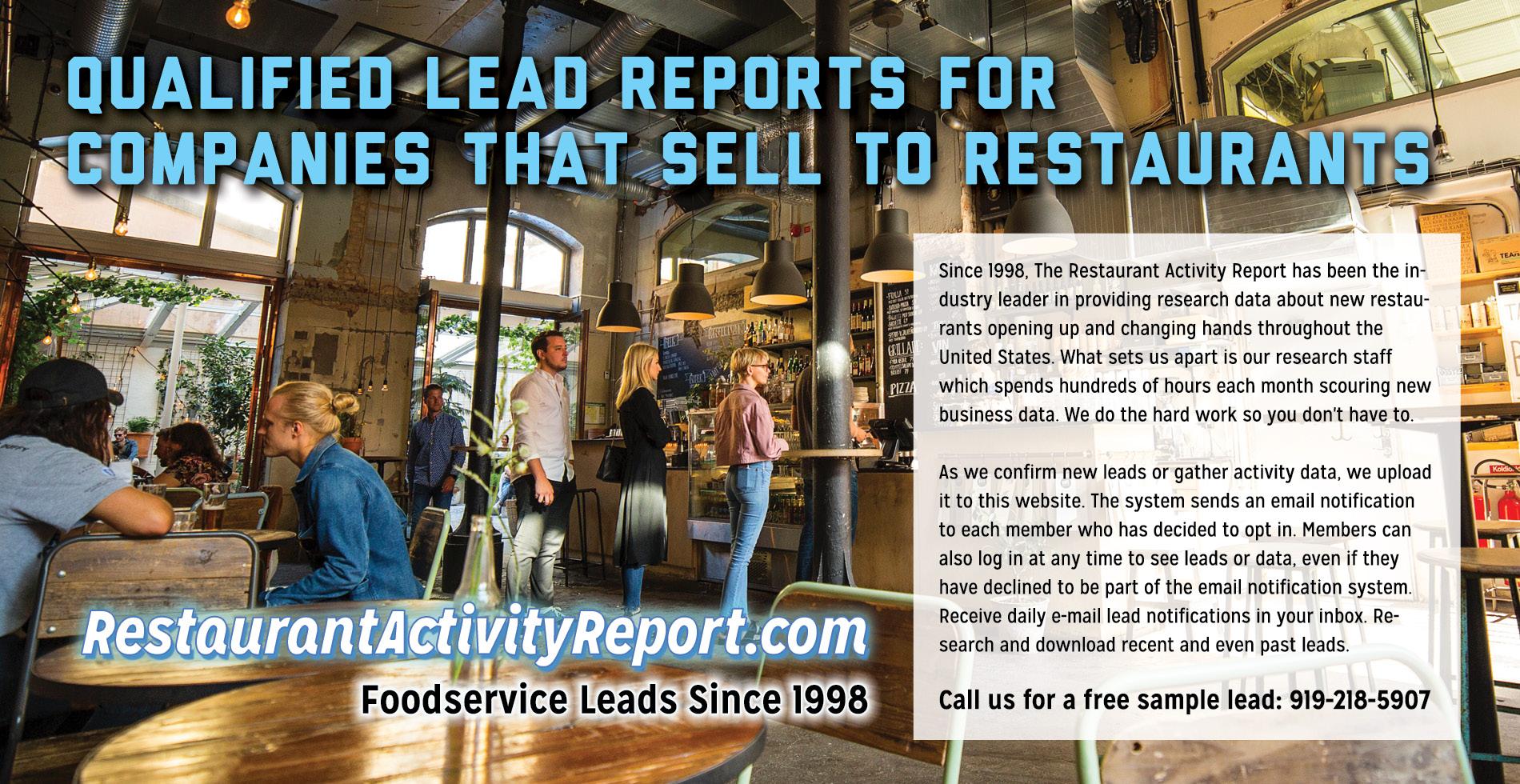








As the spring 2025 outdoor dining season kicks off in New York City, thousands of restaurants are preparing to expand their footprint onto sidewalks and streets. But this year’s rollout is layered with regulatory changes, conditional approvals, and ongoing questions—especially when it comes to serving alcohol.
According to the Department of Transportation (DOT), 600 restaurants have already received the green light to construct roadway dining structures, and another 2,000 are approved for sidewalk setups. “We’re building a more resilient and vibrant city,” said Mayor Eric Adams earlier this month. “Outdoor dining brought life back to our neighborhoods. This new framework gives restaurants the tools to keep serving New Yorkers safely and legally.” But beneath the optimism lies a thicket of bureaucracy that many operators are struggling to navigate.
Gone are the haphazard wooden sheds and enclosed cabins that characterized pandemic-era dining. Under the new rules, which take effect April 1, structures must adhere to strict design guidelines—especially for roadway cafes. Top coverings must now be open-air or retractable, allowing for ventilation and reducing the sense of permanence that drew criticism in earlier versions. No more solid roofs or enclosed fourwalled boxes. Andrew Rigie, Executive Director of the NYC Hospitality Alliance, noted that “restaurant operators have shown an incredible willingness to comply with the city's vision, but the shift in design standards has meant added costs and confusion. These are not ‘shacks’— they’re carefully constructed spaces that comply with evolving rules.” The aim, the city says, is to strike a balance between public use of curb space and restaurant business needs. Still, many
“There’s been a sense of whiplash. We’ve had to decode evolving DOT protocols on the one hand and State Liquor Authority policies on the other. Operators are stuck in the middle.” - Ron Bookman
restaurateurs remain skeptical, noting the tens of thousands of dollars it takes to meet these requirements.
As of late March, only 39 permanent licenses had been issued from the over 4,000 applications submitted. To prevent widespread disruption to the 2025 outdoor season, the DOT announced a stopgap measure: restaurants with “conditional approvals” can begin operations April 1, provided they meet key compliance benchmarks. This “conditional approval” allows operators to legally open while the city finalizes paperwork. It’s a welcome move for many, but doesn’t resolve all issues. “There’s been a sense of whiplash,” said Ron Bookman, legal advisor to the NYC Hospitality Alliance.
“We’ve had to decode evolving DOT protocols on the one hand and State Liquor Authority policies on the other. Operators are stuck in the middle.”
Perhaps the most contentious issue this season is the murky legal status of alcohol service in outdoor spaces. While restaurants may operate their outdoor cafes under DOT’s conditional approval, they must still register those spaces with the State Liquor Authority (SLA) to legally serve alcohol. In August 2024, SLA announced that restaurants must file a Municipal Alteration Application to include outdoor cafes in their licensed premises. Initially, the deadline to comply was January 1, 2025. In December, SLA updated its policy, allowing businesses to file the application within 60 days of receiving their permanent DOT license—not their conditional approval. That small distinction has massive implications. Since the
vast majority of restaurants only have conditional approval, they cannot yet apply to the SLA. That means they cannot serve alcohol legally in those outdoor areas—despite being allowed to operate them otherwise.
“The SLA has been silent on whether conditional approval is enough to proceed with alcohol service,” said Rigie. “We’ve urged them to provide clarity because this ambiguity is costing restaurants real money.” Indeed, without the ability to serve alcohol—often a major revenue stream—some operators may find outdoor dining economically unsustainable.
According to industry insiders, restaurants are already feeling the pinch. Costs for compliant builds can exceed $30,000. Payroll is also surging, with some reporting a 50% jump in labor costs. And with summer fast approaching, the stakes couldn’t be higher. Yet even operators who are ready to comply face roadblocks. Applications must go through community board reviews, DOT approval, and SLA registration. One hiccup in that chain can delay operations by months—right in the heart of peak dining season. Ron Bookman emphasized the urgency: “We believe SLA should treat conditional approvals the same as permanent ones for the purpose of filing and approving alcohol service. Right now, we’re flying blind.”
If you’re a restaurant or foodservice operator in New York City, you may legally operate your outdoor setup under any of the following conditions: if you were approved under the original

COVID-era program and filed a new application before August 3, 2024; if you received a conditional approval from DOT for your sidewalk or roadway café; or if you received a permanent license from DOT. However, for alcohol service, you must submit a Municipal Alteration Application to SLA within 60 days of receiving your permanent DOT license—not your conditional approval. The SLA has not yet confirmed whether they will accept applications based on conditional status, nor have they clarified enforcement timelines. Until the SLA addresses these two critical questions publicly, the industry remains in limbo.
For detailed guidance, operators are encouraged to visit the city’s new interactive platform, DiningOutNYC.info, which provides up-to-date maps, guidelines, and application portals for sidewalk and roadway dining.
Additionally, the NYC Hospitality Alliance continues to provide support, updates, and advocacy on behalf of the restaurant community. “We’re committed to making sure restaurant owners aren’t left in the dark,” said Rigie. For now, the message is clear: build if you’re ready, serve if you’re allowed—but stay tuned. In New York’s ever-evolving outdoor dining landscape, clarity may be the hottest commodity of all.

Awave of massive changes to school food service funding is sending shockwaves through districts across the country. The Trump administration, in collaboration with Elon Musk’s Department of Government Efficiency (DOGE), has announced the termination of critical USDA nutrition programs — moves that school nutrition leaders say will devastate access to healthy meals and local produce for millions of students.
The abrupt elimination of the $660 million Local Food for Schools (LFS) program and the FY25 Patrick Leahy Farm to School Grant Program cuts off a vital lifeline for schools working to feed children amid rising food costs. These cuts have landed just as the School Nutrition Association (SNA) intensifies its lobbying efforts to preserve meal funding on Capitol Hill.
At the forefront of the opposition to proposed federal cuts is the School Nutrition Association (SNA), which repre-
“A
nation vowing to improve the health of America’s children should not cut the very programs that effectively teach students how to make nutritious choices.” — Shannon Gleave, President, School Nutrition Assoc.
sents 50,000 school meal professionals nationwide. The organization continues to press Congress to reject the budget reconciliation measures that threaten to undermine school meal programs. In its 2025 Position Paper, the SNA outlines the far-reaching consequences these cuts would have on student health, local economies, and the long-term sustainability of meal services.
Among the proposals being considered are raising the threshold for the Community Eligibility Provision (CEP) from 25% to 60%, which would eliminate universal free meal access for over 24,000 schools and 12 million students; mandating income verification for every application, a move expected to increase administrative burdens and delay benefits for eligible families; and eliminating Broad-Based Categorical Eligibility (BBCE), which could deny automatic meal access to nearly 1 million students currently eligible through SNAP enrollment. “School meals are a smart

investment in the health and future of America’s children,” said SNA President Shannon Gleave, RDN, SNS. “Cashstrapped programs cannot bear the administrative burdens and financial gaps these cuts would impose.”
On the heels of these proposals came a second blow: the USDA’s decision to cancel FY25 applications for the Patrick Leahy Farm to School Grant Program, eliminating another $5 million in funding that supported school gardens, taste testing events, and local produce sourcing efforts.
“Farm to School grants foster community partnerships that support immersive learning,” Gleave said. “They educate students about where food comes from and encourage them to consume a variety of fresh, local options in school.”
This move was part of a broader USDA strategy to “return to long-term, fiscally responsible initiatives,” according to administration officials. But critics argue that dismantling successful, community-focused programs in the name of austerity does more harm than good.
These developments arrived on the heels of the SNA’s 53rd Annual Legislative Action Conference, held March 9–11 in Washington, DC. There, more than 850 school nutrition professionals gathered to urge lawmakers to increase fund-
continued on page 94

continued on page 102




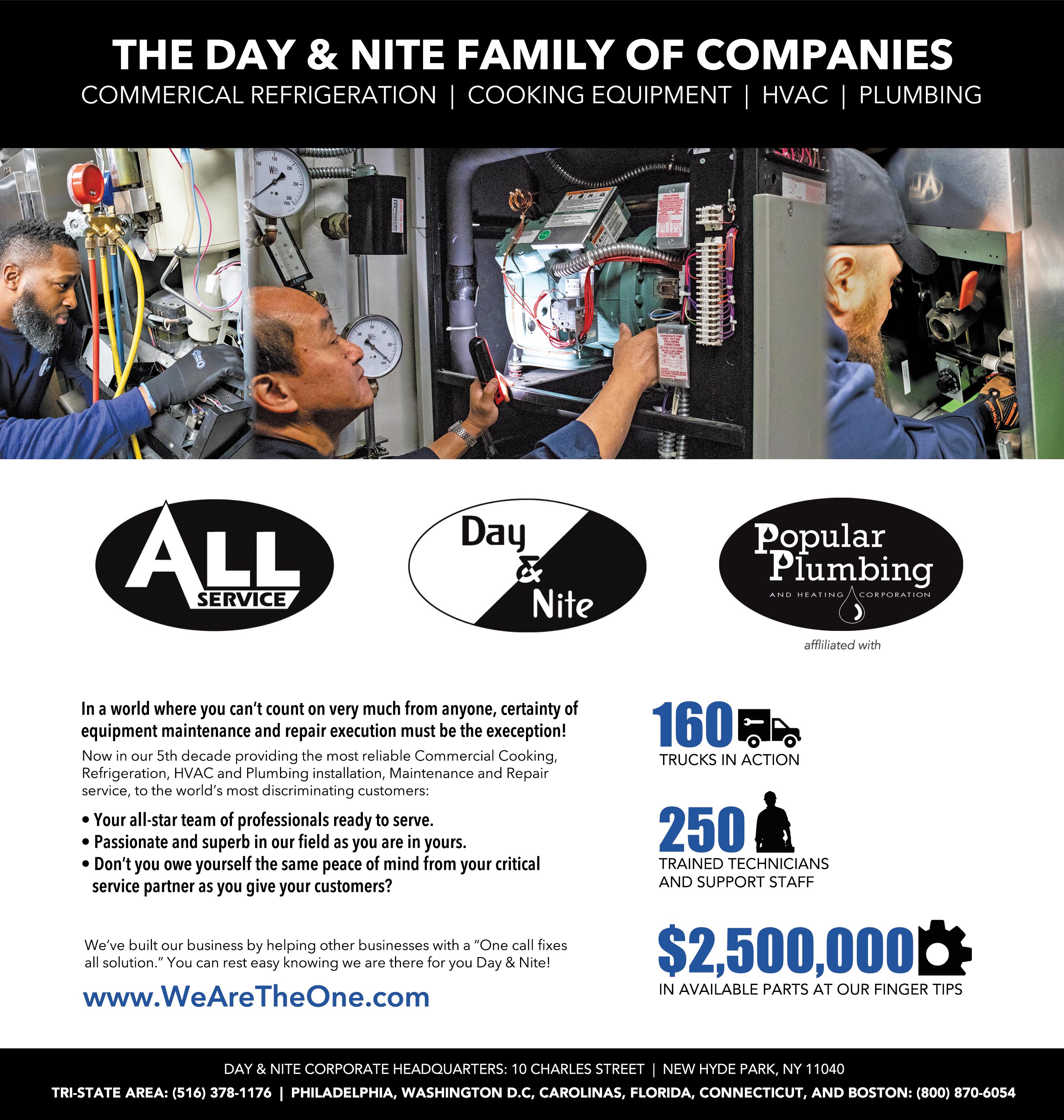
The Specialty Food Association’s Summer Fancy Food Show returns to the Javits Center in New York City, June 29 – July 1, 2025, promising three days of thrilling product discovery, trendspotting, networking and more for its community of manufacturers, buyers, brokers, chefs, investors, and press.
Now in its 69th year, the Summer Fancy Food Show is known for helping to launch small brands with great products into mainstream success. So—what will be the next Mike's Hot Honey, Tate's Cookies, or Stonewall Kitchen, all past Fancy Food Show exhibitors? Get a preview of this year’s Show from a small group that’s already registered to walk the Exhibit Hall in a few short months! Want to join them? Registration is open now for qualified members of the food industry.
What is your favorite thing about the Fancy Food Show?
“Engaging with brands and entrepreneurs in person. There's just nothing like talking to the person behind a brand, understanding their motivations, asking questions about ideas and flavors, and actually getting to taste the product. It brings the ideas and trends to life and makes them more human.” – Mike Kostyo, Vice President, Menu Matters
“What keeps me coming back is the opportunity to discover hidden gem products and new items from brands and meet the passionate producers. Last year, I tried Confetti Snack’s Crunchy Mandarin Oranges and now I can’t live without them. I find something new (or 10 new things) every time I go.” - Laurel Randolph, Associate Editorial Director, Simply Recipes
“My favorite thing is the incubator room where I can explore the booths and see all the hard work, families, and friends that put together a product they are eager to launch.” - Hayley Celentano, Cheese Buyer, Citarella
What hot food trend or trends are you looking forward to seeing in the Exhibit Hall?
Dubai Chocolate:

“I tried two different Dubai bars at the Winter Fancy Food Show and have seen various versions of it since then. I expect to see even more riffs on the chocolate and pistachio combination.” - Amy Sherman, Editorial Director, Professor Media Group
“I expect the Dubai chocolate bar theme to crossover to several categories such as cereal, granola, ice cream, pastries, coffee, and honestly, even cheese!” - Hayley Celentano, Cheese Buyer, Citarella
Less Processed, More Local
“I've been enjoying the shift back to whole, minimally processed foods for their health and sustainability benefits, and I’m excited to see many companies reflecting this trend at the Fancy Food Show.” – Dina DiCenso, Founder, RIND
“Right now, I’m seeing a surge in low-intervention, naturally fermented foods—from craft vinegars to smallbatch pickled products. There’s also a growing demand for luxury snack experiences, such as truffle-infused chips or caviar-topped bites. I expect to see these trends represented in exciting ways at the show.” - Josh Gryvatz, Gourmet Foods Dept Manager, Wine Library
Spice Across Categories
“I’ve been seeing protein everything, so I expect to see some new products that feature high levels of protein for consumers on the go. No added sugar is also nice to see, especially in children’s products. And I expect to try plenty of products with spice, from chile to chai, and in everything from snacks to drinks to mains.” - Laurel Randolph, Associate Editorial Director, Simply Recipes
“Spice is life! I love seeing how brands are interpreting flavor forward spice into products. I do expect to see spice (hot or not) show up in various ways at the show and I’m here for it!” - Claudia Arcuri-Smith, Category Manager, National Co+op Grocers
Tasting the World, Embracing Terroir
continued on page 96




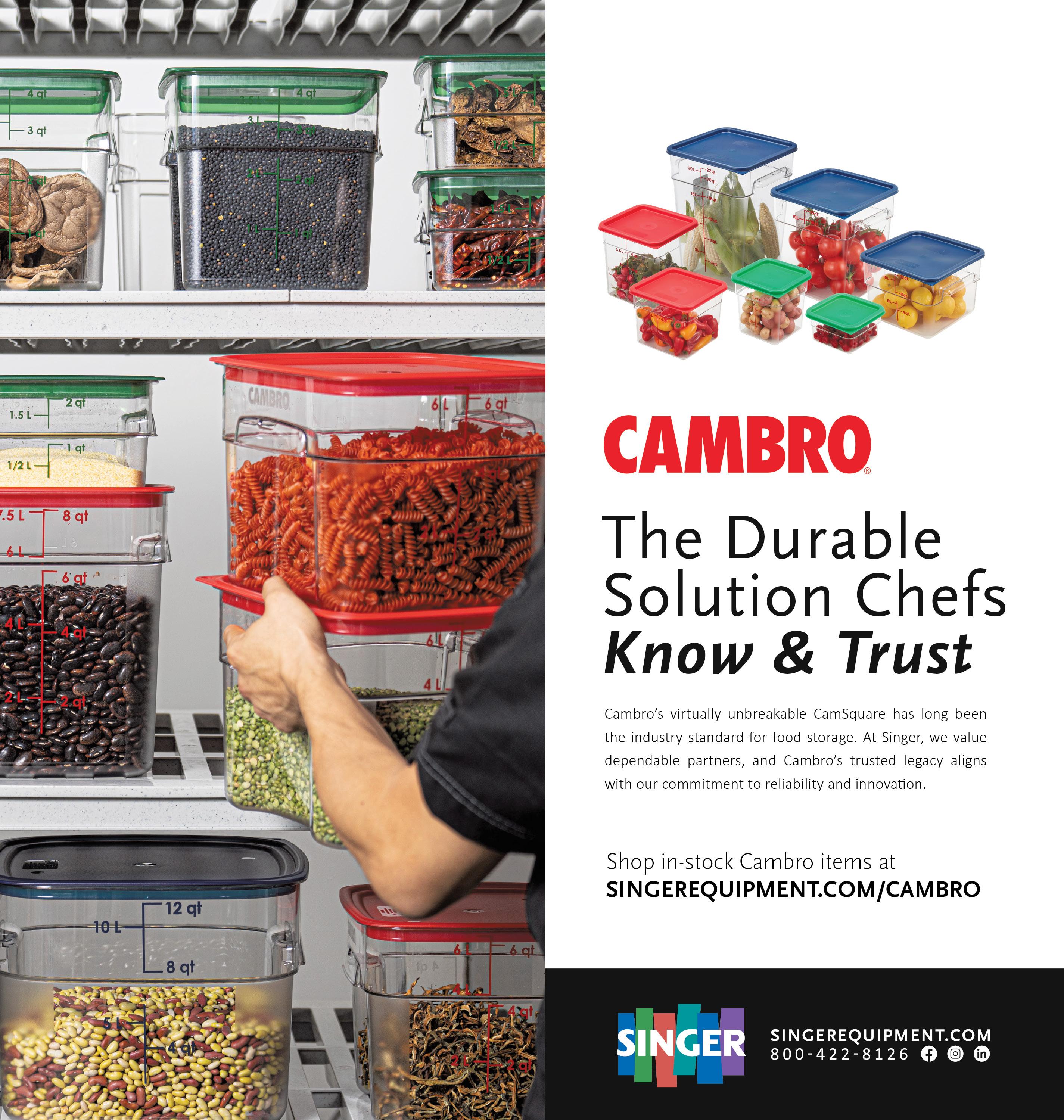
Independent restaurants and small chains face unique challenges in today’s competitive foodservice landscape. These challenges often overlap and exacerbate one another. Rising costs are arguably the biggest concern, as inflation affects everything from food and beverage prices to labor, rent, utilities, and packaging. Maintaining profitability while absorbing these price increases is incredibly difficult, making it inevitable to pass some of these costs on to customers. However, doing so without alienating your customer base presents a significant challenge.
Additionally, the industry is grappling with a labor shortage, making it difficult to find and retain staff in both front-ofhouse and back-of-house roles. Proper employee training is another hurdle. Furthermore, disruptions in the supply chain and the ongoing fragility of global supply systems directly impact local restaurants. To complicate matters, increasing competition makes it even more challenging to maintain a restaurant’s viability.
So, what can be done? Building and effectively communicating your brand is crucial. With so many dining options available, it’s important to be at the forefront of customers' minds. How can you
achieve that? Build your BRAND!
Your brand is shaped by everything you do, everything you say, and everything others say about you. This collective impression creates a perception and belief of who you are. While you can control some aspects of brand building, much of it relies on the opinions and actions of others.
The most important ingredient in the brand-building recipe may seem obvious, but yes, it is YOUR restaurant. You only have one chance to make a first impression, and with new customers visiting every day, that first impression must be outstanding every day. Can you confidently answer yes to these simple questions?
1. Is my restaurant always clean?
2. Are the restrooms consistently clean and functional?
3. Are there no wobbly tables?
4. Do you keep your noise level under control?
5. Do you ensure you are not too hot or cold?
6. Is my food consistently great?
7. Can my staff discuss anything on the menu with a smile?
If you can answer yes to all these questions, you're on the right track! Of
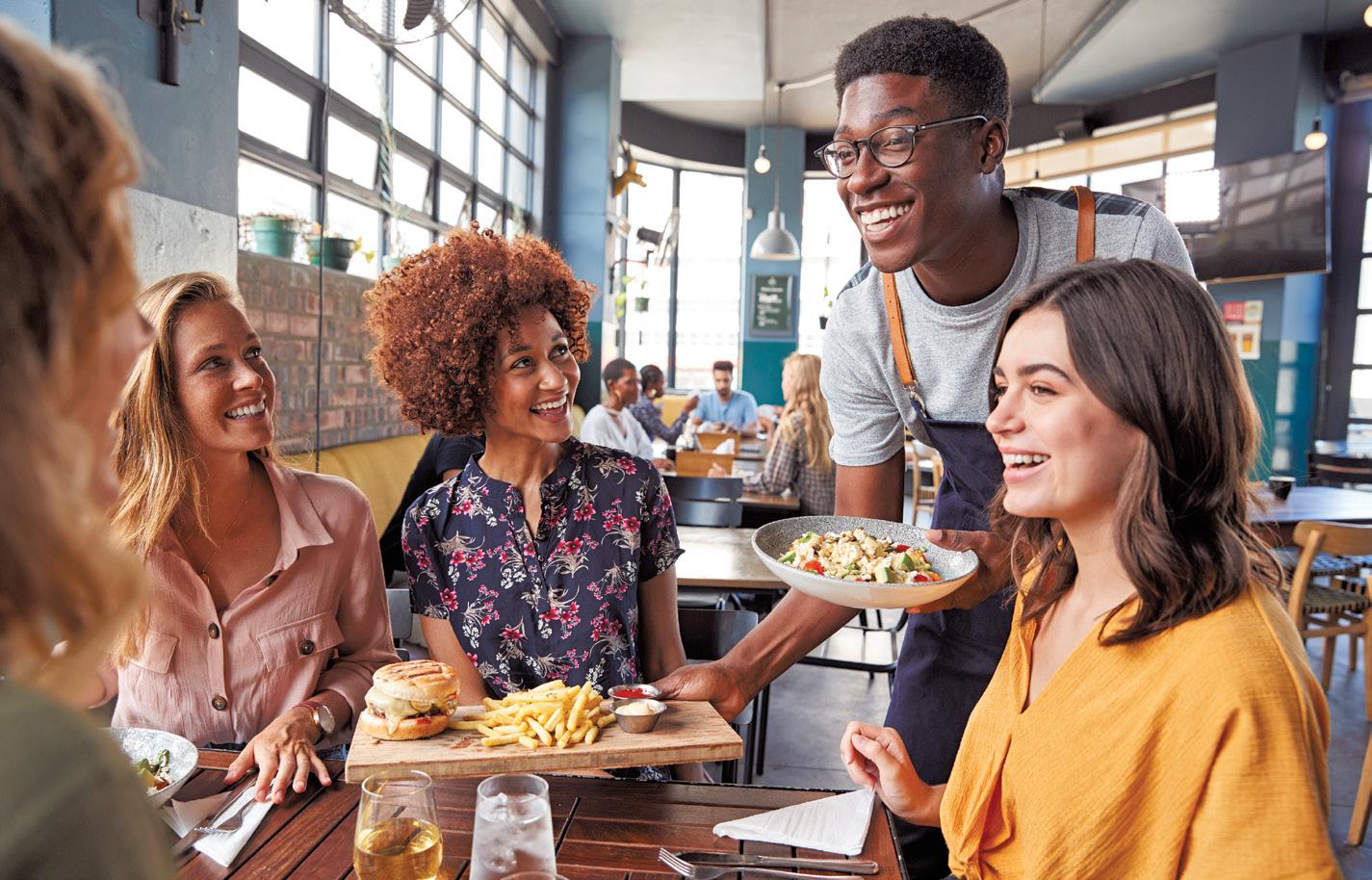
course, a great menu (look, feel, and content) makes a difference. Whatever your menu might be, make it great. Ambiance is also essential. Are you looking for a family-friendly atmosphere? Is your space romantic enough for a date night? Or do you have the sophistication needed for a business dinner? How comfortable will your guests feel? Make it exceptional no matter what ambiance you want to create!
When customers leave your restaurant having a wonderful experience, they will discuss it. When customers leave your restaurant having a terrible experience, they will discuss it. This is the most crucial thing in building your brand.
In today's digital world, the next essential step is to establish an online presence. This means building a website and being active on essential social media platforms. I understand that you might feel overwhelmed with the responsibilities of running a restaurant, and it may seem like there's no time to dedicate to online marketing. However, with a bit of discipline, you can make it happen. Set aside a short period each week to focus on your online presence. If it's in your budget, consider hiring a local free-

Sam Barnett is the Founder of Brand Think Plus LLC, a consulting agency dedicated to helping clients with brand development and everyday marketing challenges. With over 40 years of experience in marketing and brand building across the foodservice industry and other sectors, Sam brings a wealth of knowledge to his clients. Before founding Brand Think Plus LLC, Sam co-founded Creative Energy in 1992, serving as Vice President and Marketing Strategist until 2008. From 2008 to 2024, he established Barnett and Associates, specifically working for Creative Energy. During this time, Sam managed accounts for major clients such as The Coca-Cola Company, Johnsonville Sausages, Hoshizaki, Olé Mexican Foods, Flat Technologies, Winston Industries, and many other companies in the foodservice sector. Brand Think Plus LLC was formed to assist businesses, both large and small, in discovering the right strategies for building strong brands. So, if you're interested in talking about branding or Brunello, feel free to reach out to Sam; he would be happy to chat with you. BrandThinkPlus.com • sam@ brandthinkplus.com
lancer or agency to assist you. The return on investment will be worth it! With the
continued on page 96


The food industry is evolving rapidly, and technology is at the heart of this revolution.
One innovation which has become the talk of the town is SMS automation for food ordering. Gone are the days when customers had to deal with long hold times, misheard orders, and restaurants had to handle frustrated customers. The entry of SMS automation in the food service industry is simplifying the ordering process by making it faster, more efficient, and more convenient for both business owners and customers.
So, what is the problem with traditional ordering?
Tradition Ordering is Slow, Expensive, and Inconsistent. For so many years, restaurants and food service businesses have relied on traditional ordering methods such as phone calls and in-person orders. Undoubtedly, these methods have served their purpose, but it comes with a few challenges. When customers order food via phone calls, it often leads to miscommunication, long
wait times, and incorrect orders. Staff members generally juggle multiple calls and struggle to take orders, especially during peak hours.
Third-party apps come into the picture To fix this gap, but they charge hefty commission fees. It ultimately lowers restaurant profits. Sometimes, these platforms even create an inconsistent customer experience because of mismanaged deliveries and delayed orders. Customers prioritize convenience, but because of the outdated ordering system, they must deal with frustration and lost business revenue.
Here is where SMS ordering comes into the picture.
Picture this – you live in a world where food ordering is quite simple. All you need to do is send a text message. No app downloads, no waiting times, no miscommunication – nothing! SMS automation transforms this dream into

a reality.
Using an automated SMS ordering system, customers can place an order by sending an SMS to the designated number. The system instantly confirms the order, provides the estimated wait time, and even suggests add-ons to improve the customer's meal. As text messages have a 98% open rate, restaurants can ensure that order confirmations and updates are seen almost instantly. This simplified process removes the guesswork, reduces errors, and makes the ordering process a hassle-free experience. Whether it is a busy working professional who orders lunch on the go or a family scheduling a weekend takeout, SMS automation caters to everyone.
The success of restaurants depends on their order-handling efficiency. Their success mantra should be more orders and less chaos; SMS automation helps them achieve this. How? It reduces the phone call overload and frees up staff members to focus on their food preparation and customer service. Employees don't have to answer calls constantly; they can devote their valuable time to ensure food quality and quicker service. When food service businesses/restaurants integrate SMS automation into their ordering system, it offers various benefits to the customers.

Philip Portman is the Founder and CEO of Textdrip, a business texting platform catering to industries such as Restaurant, Hotels & Hospitality, Solar, Travel & Tourism, ECommerce, Real Estate and Healthcare. He has successfully launched several startups including landlineremover.com and argosautomation.com. With expertise in SMS marketing and digital automation, Philip is also an esteemed member of the Forbes Technology Council. Learn more at philportman.com and textdrip.com
Customers can receive instant order confirmations, easy reordering options, and real-time updates on their food status. Fewer mistakes = fewer complaints. It improves customer satisfaction and provides higher retention rates. Besides, restaurants can inform customers when their order is ready for pickup, reduce wait times, and improve overall service efficiency.
The success of restaurants is not only dependent on taking more orders but also on driving repeat business. And SMS automation helps with it. How? SMS automation is a powerful tool for customer engagement and retention. Restaurants can use SMS for various purposes, such as sending personalized promotions and discounts, gathering feedback via quick surveys, offering loyalty rewards for repeat customers, and announcing special menu items or limited-time offers.
Customers appreciate personalized interactions, and SMS is the perfect and direct way to keep them engaged. For example, a restaurant can send a message such as – "Thank you for ordering! Get 15% off your next meal by showing this text on your next visit." This strategy
continued on page 102
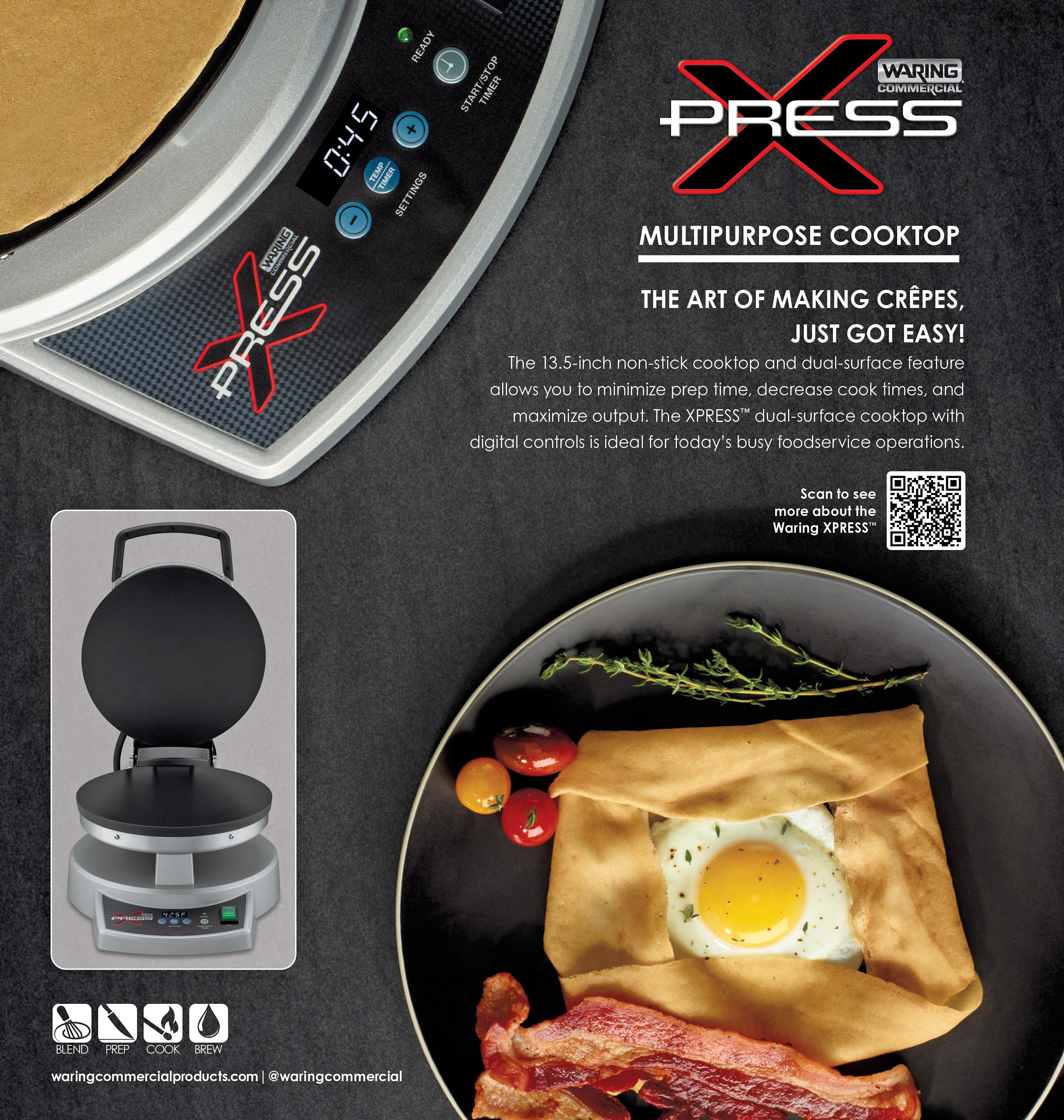
The ability to use a single ingredient in multiple applications is crucial for restaurants looking to optimize inventory and labor costs. Mike’s Hot Honey seamlessly transitions from enhancing pizza crusts to glazing proteins such as chicken, pork, and seafood. “We’ve seen operators get really creative,” said Matt Beaton, CEO of Mike’s Hot Honey. “They use it on pizza one day, then as a finishing touch for roasted Brussels sprouts or a spicy glaze for fried chicken the next. It simplifies the kitchen while adding signature flavors.”
By incorporating one product into several menu categories, restaurants can control their purchasing while maintaining the consistency of highquality, trending flavors. Restaurant and foodservice operators are under increasing pressure to reduce waste, simplify procurement, and manage inventory efficiently. The fewer SKUs a kitchen has to handle, the easier it is to control costs. “One of the biggest challenges in foodservice today is SKU management,” Beaton explained. “Operators want to carry fewer products that do more. That’s where Mike’s Hot Honey fits perfectly—one bottle, endless applications.”
With ongoing labor shortages and rising food costs, every operational efficiency counts. A single bottle of Mike’s Hot Honey can replace the need for multiple sauces and toppings, reducing prep
“They use it on pizza one day, then as a finishing touch for roasted Brussels sprouts or a spicy glaze for fried chicken the next. It simplifies the kitchen while adding signature flavors.” — Matt Beaton
time and increasing speed of service.
The Brooklyn, NY based menu solution is making waves across the restaurant industry, and its return to major trade shows reflects the growing demand for versatile, high-impact ingredients. The brand recently showcased its products at the New York Restaurant Show (NYRS) and the International Pizza Expo in Las Vegas, with another major appearance
set for next month’s National Restaurant Association (NRA) Show in Chicago.
“These trade shows are where we really connect with our customers,” Beaton noted. “We hear firsthand how they’re using our product and what challenges they’re facing. That feedback is invaluable.” At the International Pizza Expo, Mike’s Hot Honey was featured in numerous pizza concepts, reinforcing its role as an essential ingredient for the category. Similarly, at the NYRS, chefs demonstrated how it can be used beyond pizza, from cocktails to barbecue glazes.
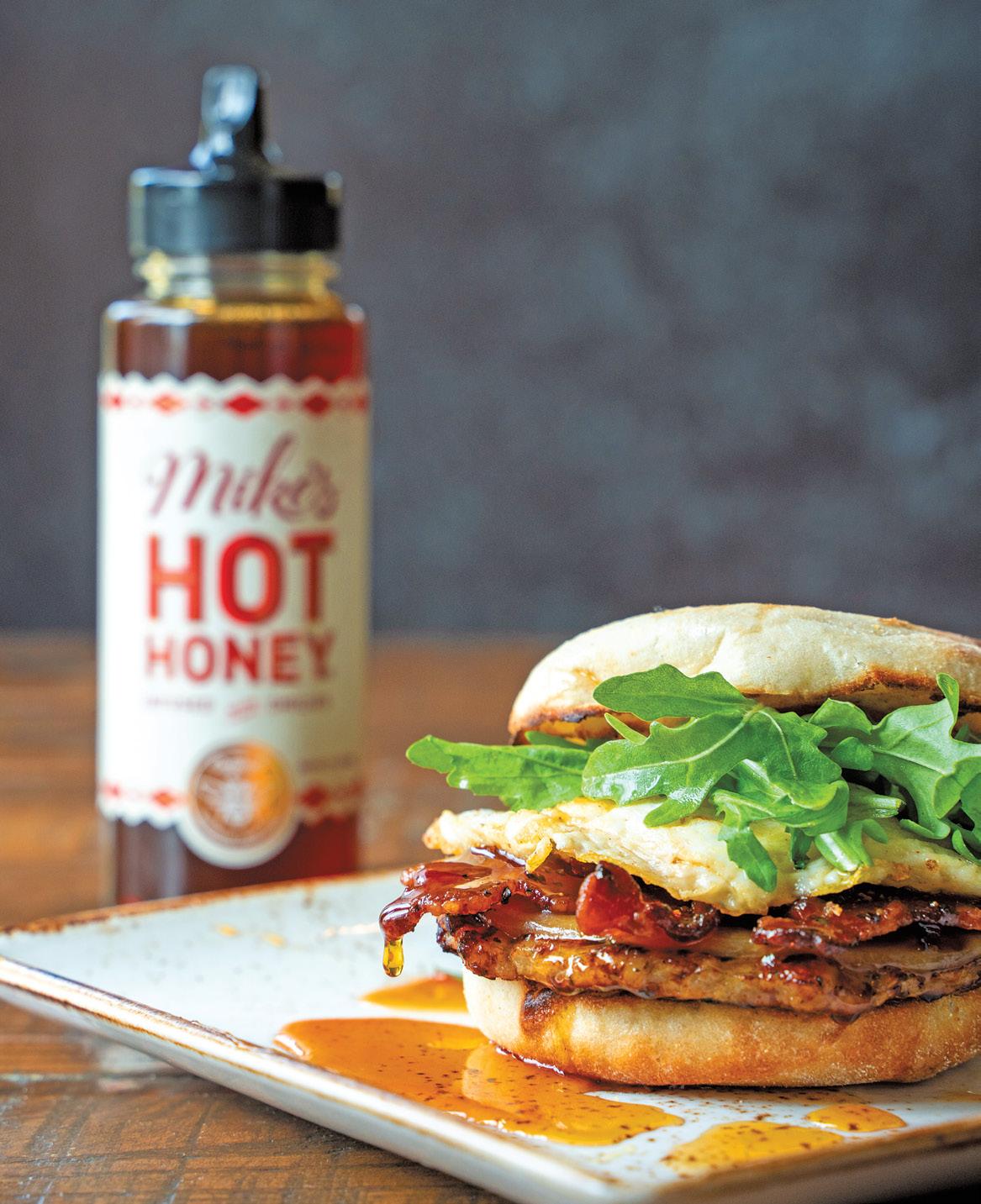
The success of Mike’s Hot Honey is part of a larger trend known as “Swicy”—the combination of sweet and spicy flavors that continue to captivate diners. Consumers are looking for exciting, layered flavors, and this trend has extended from pizza to everything from craft cocktails to fried chicken sandwiches. “The demand for sweet heat is only growing,” Beaton detailed. “We’ve seen operators use Mike’s Hot Honey in margaritas, Old Fashioneds, and even espresso martinis. It’s a simple way to add complexity to drinks and dishes alike.” This versatility allows
chefs to enhance traditional dishes without adding complexity to their kitchen workflow.
For restaurants and foodservice operators looking to add Mike’s Hot Honey to their menus, the brand is widely available through major broadline distributors, regional specialty distributors, and at Restaurant Depot and JETRO locations nationwide. Additionally, operators attending the NRA Show in Chicago next month can visit Mike’s Hot Honey’s booth to explore its latest innovations and speak directly with the team. “We love working with chefs and restaurant owners to find new ways to use our product,” Beaton concluded. “Anyone looking for menu inspiration or sourcing options can reach out to our team— we’re always happy to help.”
To explore how Mike’s Hot Honey can elevate your offerings, visit mikeshothoney.com for recipe inspiration, product details, and ordering information.
For those attending the upcoming NRA Show, be sure to connect with Matt Beaton and his team to experience firsthand how this innovative ingredient is transforming foodservice. From pizzas and sandwiches to cocktails and desserts, its perfect balance of sweetness and heat allows kitchens to create signature items with fewer ingredients while maintaining high-impact flavor. Whether you’re looking to streamline your pantry or add a new dimension to your menu, Mike’s Hot Honey is a simple yet powerful way to enhance flavor and efficiency in any kitchen.

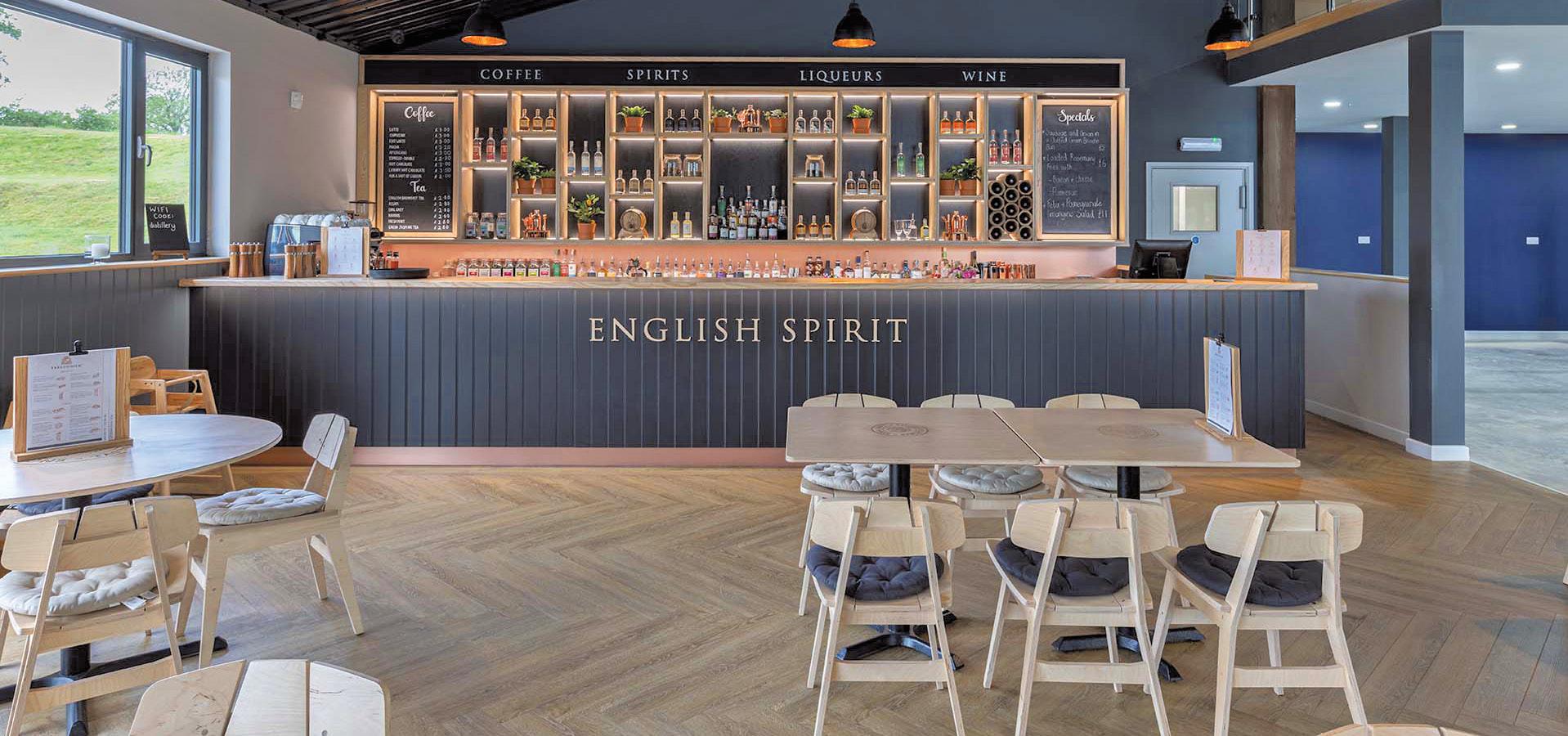
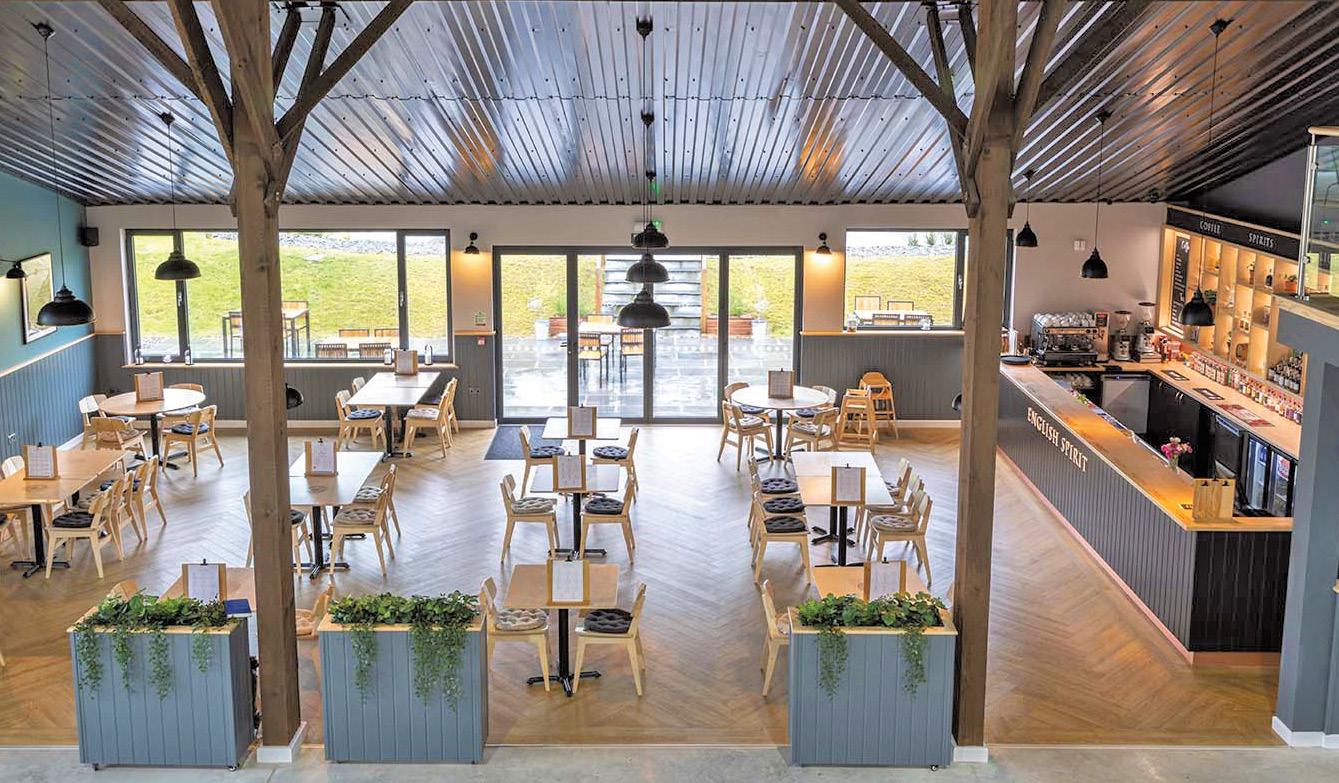
When it comes to designing a dining area, first impressions matter. From the moment a customer steps through the door, the atmosphere sets the tone for their dining experience. While lighting, decor, and furniture all play critical roles in crafting this ambiance, flooring often serves as the unsung hero of front-ofhouse design.
At Altro, we understand that the right flooring choice isn’t just about aesthetics—it’s about balancing beauty with durability and ease of maintenance to create a space that wows guests while standing the test of time.
Whether you’re creating a cozy café, a high-end steakhouse, or a lively bistro, flooring can make or break the vibe you’re aiming for. Luxury vinyl tile (LVT) offers unique benefits and can help achieve distinct looks that align with your brand identity and customer expectations.
LVT has surged in popularity for dining areas, and it’s easy to see why. With its ability to mimic natural materials like wood and stone, LVT delivers high-end looks at a fraction of the cost. It’s also exceptionally durable, standing up to high foot traffic and the inevitable
spills that come with the restaurant industry. For concepts focused on modern elegance or rustic charm, luxury vinyl can be the perfect choice to tie the design together.
Maintenance is another major perk. Altro Lavencia LVT offers peak beauty and performance that will last through its lifetime, even in areas with consistently heavy traffic, thanks to the commercial-grade UV-cured ceramic reinforced urethane finish and
a 28-mil wear layer.
Beyond aesthetics, practical considerations like safety and hygiene also come into play. Easy-to-clean products are equally valuable in these environments to counteract food and beverage spills, promoting hygiene and deterring slip and fall accidents. Clean, well-maintained floors will leave a lasting impression that encourages repeat visits.
Selecting the right flooring for a din-

ing area is an investment in your brand and customer satisfaction. With so many options available, it’s essential to consider not only the initial look but also the long-term performance of your choice. The versatility of luxury vinyl tile can help bring your restaurant’s vision to life while ensuring durability and ease of maintenance.
At Altro, we’re here to help you find the perfect solution for your front-ofhouse needs. With products designed to balance form and function, you can create a dining space that impresses from the first step to the last.
For more information on Altro Lavencia LVT, please visit our website, https:// www.altro.com/us/products/altrolavencia-lvt.
Family-owned and operated since 1919, Altro is a world-leading manufacturer and innovator in commercial floors and walls. With over 60 years’ experience in delivering floors and walls for commercial kitchens we offer an unparalleled, premium expertise to food service sector’s architects, designers, contractors, and end users to help them transform the busiest commercial kitchens and dining rooms into thriving environments.

Rising food costs and ongoing labor shortages continue to challenge restaurant and foodservice operators across the U.S. While businesses can’t always control ingredient prices or staffing difficulties, they can focus on making smarter equipment investments that lead to long-term savings. The right kitchen equipment does more than just cook or store food—it optimizes efficiency, reduces waste, and lowers labor costs. As automation and robotics gain traction, foodservice operators are turning to brands like Atosa, which has positioned itself as a leader in delivering both affordability and innovation.
With a robust product portfolio and a recent showcase of 60 new products at the NAFEM Show in Atlanta, Atosa is proving that investing in the right equipment can mean the difference between struggling and thriving in today’s foodservice industry. Before diving into automation, it’s essential to understand the role of traditional kitchen equipment in a restaurant’s operations. Atosa’s lineup includes a full range of essential products, from cooking and refrigeration to ice machines and dishwashing solutions. Cooking equipment remains the heart of every foodservice operation. Atosa provides a variety of high-per-
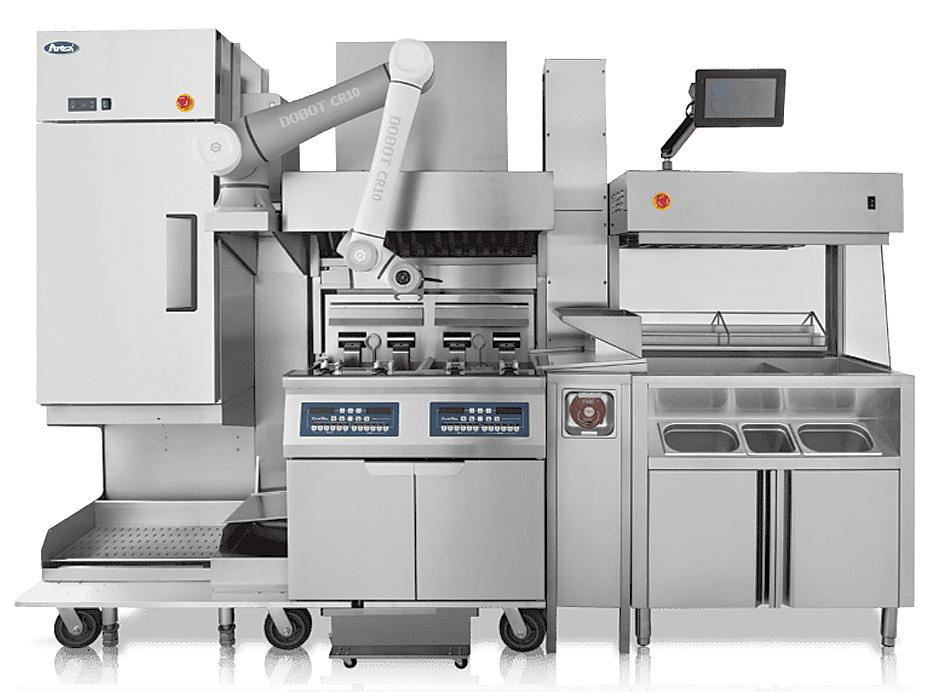
formance ranges, griddles, fryers, and ovens designed for durability, energy efficiency, and ease of use. These appliances ensure that kitchens can operate smoothly while maintaining consistency in food preparation.
Refrigeration is another cornerstone of foodservice. With rising food costs, proper cold storage is more critical than ever. Atosa offers reachin refrigerators, freezers, and undercounter units to help operators keep their ingredients fresh while mini -
“Trust is everything. Our dealers know that we’ll never go around them, and we’re committed to providing the best possible support so they can confidently recommend Atosa to their customers.” — Jennifer Ward
mizing energy consumption. In beverage and foodservice operations, ice machines are essential. Atosa’s high-volume ice machines provide a consistent supply with minimal maintenance, making them ideal for busy restaurants, bars, and cafeterias.
Finally, Atosa is proud to offer the first affordable combi ovens in the industry! Combi ovens combine the benefits of steam and convection heat, delivering exceptional cooking results, versatility, and energy efficiency. Perfect for restaurants looking to elevate food quality while reducing operational costs, Atosa’s combi ovens provide unmatched value for businesses seeking both performance and affordability. These core products form the foundation of a wellfunctioning kitchen, but the future of foodservice is rapidly evolving beyond just traditional equipment.
As labor shortages persist and operational costs rise, automation and robotics are no longer just futuristic concepts—they’re necessities. Atosa has been at the forefront of this shift, unveiling several cutting-edge automation solutions at NAFEM. “The key end of it is understanding what real value automation can bring—reducing labor, optimizing workflow, enhancing consistency, and reducing food waste,” Jennifer Ward, Chief Revenue Officer of Atosa USA, detailed. “But most importantly, the return on investment has to make sense. If it does not have an ROI of less than a year, we do not waste our time.”
Atosa’s automation portfolio includes several groundbreaking solutions, such as pizza automation systems, multi-product saucing solutions, and picking automation designed for multiple QSR and fastcasual brands. These technologies streamline food preparation, reduce labor requirements, and improve accuracy. Other automation on the forefront is dishwashing automation which is another game-changer, eliminating one of the most labor-intensive tasks in the kitchen. Along with slicing and chopping automation, further reducing food prep time while ensuring precision and safety.
One of the biggest advantages of automation is waste reduction. Ward explained, “Let’s say someone orders two large fries at 8 PM. The POS system will automatically instruct our robotic arm and fryer to drop only the necessary amount, preventing unnecessary waste,” she noted. With automation solutions rapidly gaining
continued on page 108
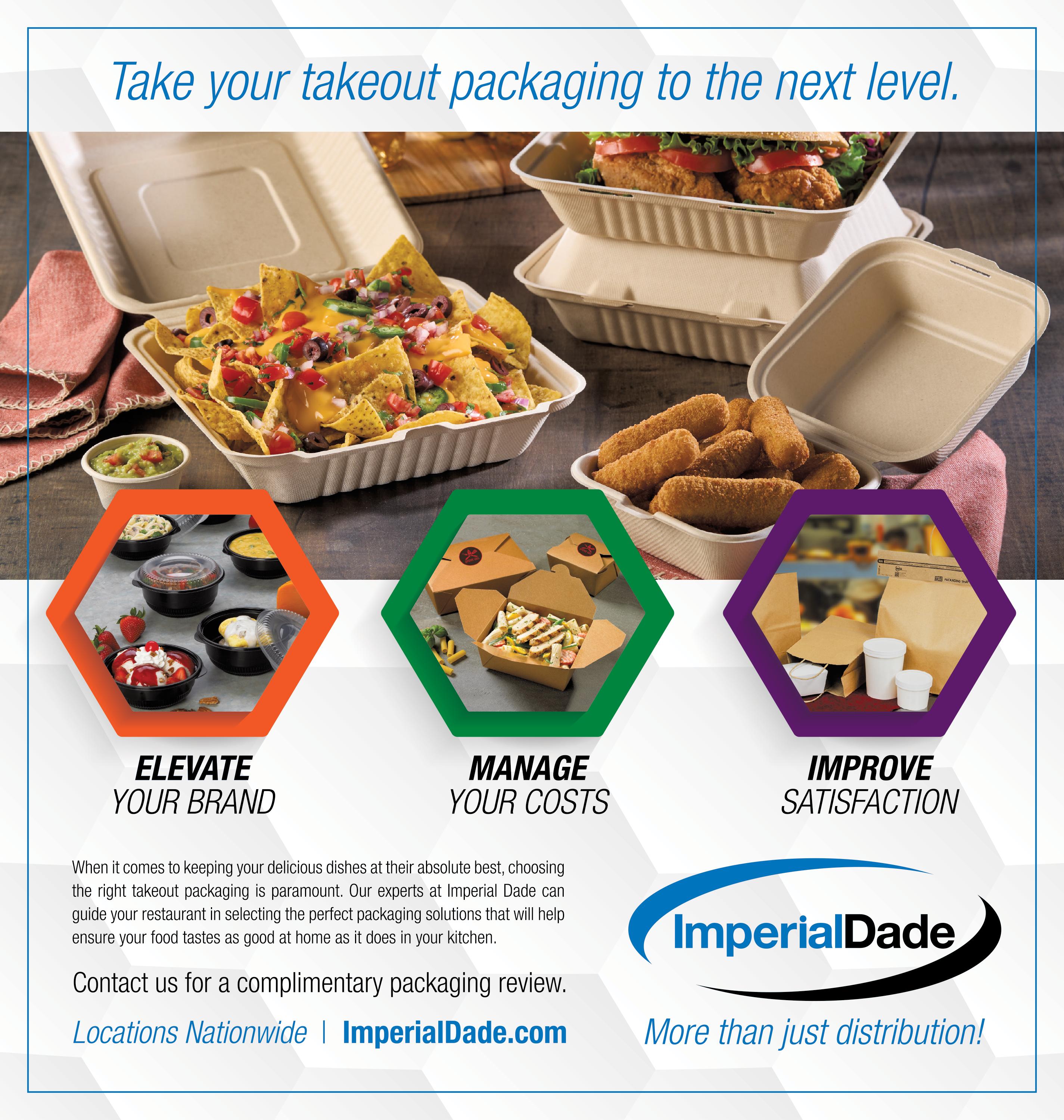
For over two decades, Marc Spitzer has been the Executive Chef of BONDST, one of the most popular and beloved Japanese restaurants in New York City, with locations in both NoHo and Hudson Yards, as well as Bond Street Lounge in Miami. He’s a graduate of The Culinary Institute of America and after graduation worked at the James Beard Award-winning Le Cirque 2000 at the Palace Hotel, and was on the opening team when the iconic Russian Tea Room reopened in 1999. Marc has partnered with Noam Shemel, principal of Kano Real Estate Investors, to start Northern & Main Hospitality and open Okaru as their first concept together.
His journey from chef to restaurant owner is a testament to hard work, creativity, and resilience. His story inspires anyone with a dream, proving that with passion and perseverance anything and everything is possible.
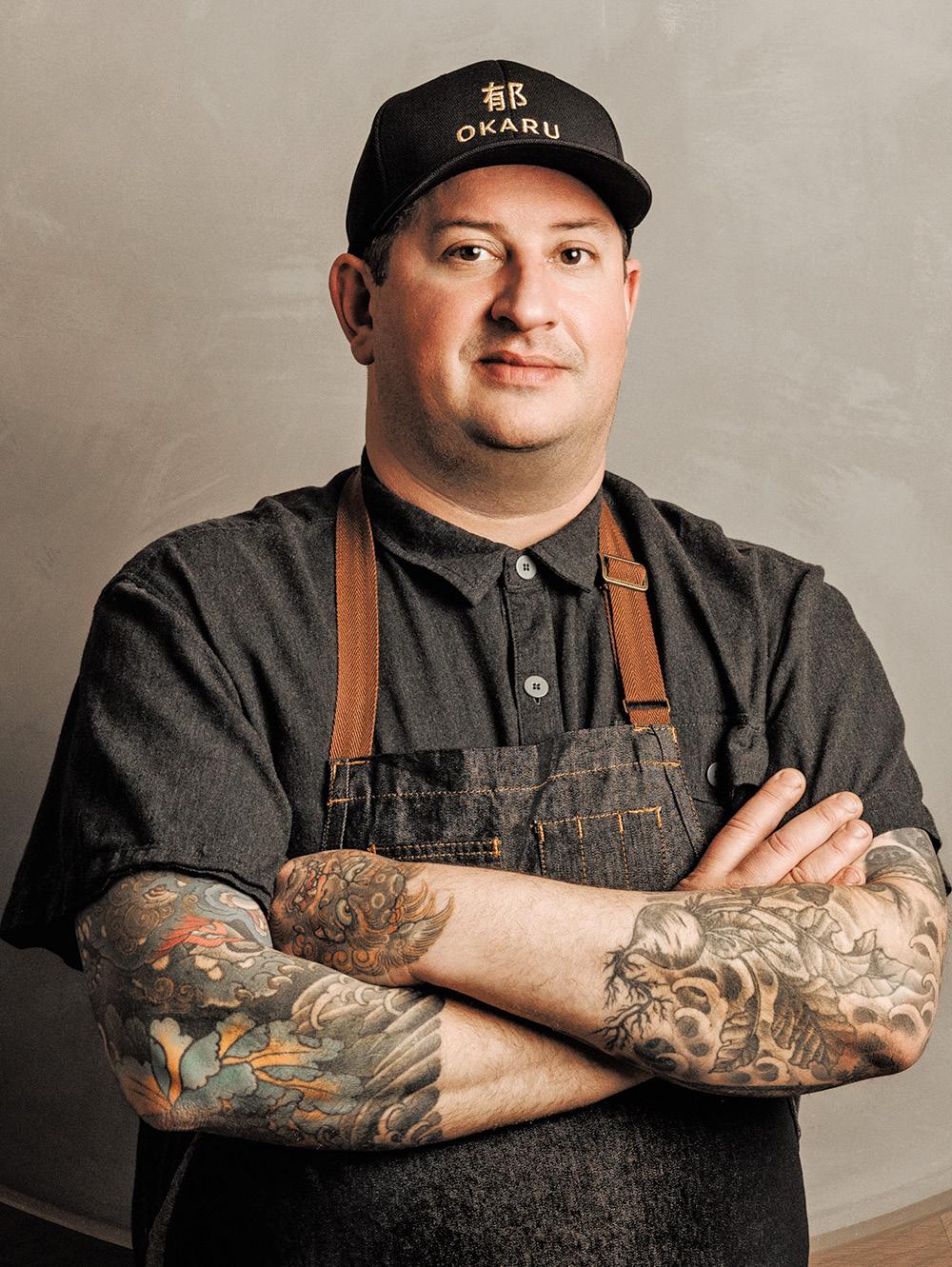
Tell our readers what got you interested in the restaurant industry?
Walk us through your career track.
I grew up in the restaurant industry. My mother is an amazing self-taught chef who had a restaurant in Queens when I was growing up. She would run the kitchen and my father would go there after his morning job. I would spend all the holidays and busy days there and it was from the both of them that I really learned about work ethic and the industry. My mother truly loves cooking and her passion was contagious.
What do you love about running a kitchen and restaurant serving Japanese cuisine?
Cooking is truly a team sport. We as chefs can create many things but ultimately, it’s not us cooking every dish. I think teaching and then seeing people flourish and really love what they do is the best part for me. To see that moment when it just clicks and they get it. The flow, the food, enjoying the process.
Being classically French trained, I fell in love with Japanese food for its ‘simplicity’ yet complexity all at the same time and how dependent it was on the ingredients. Just trying to get the best product and not mess it up.
What’s your approach to creating the dishes?
I always try to create dishes that have balance. Salty, sour with a tiny bit of sweetness and as much umami as I can get in there. Linda Rodriquez, one of my previous chefs, was a true master at this. I try to make dishes that people will crave and bring them back. Trying not to focus on dishes that are perceived as precious that are great but don’t necessarily leave you wanting more.
You received rave reviews at BONDST in NYC, why did you choose to open Okaru in Roslyn, NY?
As a native Long Islander, I have made the daily commute to the city for over 25 years. I’ve always wanted to bring what


Joyce Appelman is the SCOOP News Editor and Senior Contributing Writer for Total Food Service and previously the National Communications Director for C-CAP, Careers through Culinary Arts Program. An industry leader supporting education and scholarships, she has been instrumental in opening career opportunities for many young people in the foodservice industry. Email her at joyceappelman@gmail.com
we did in the city out to Long Island. As a partner in BONDST, I will always have my hand in the day to day, but for now just focusing on getting Okaru to what I know it could be as far as the food and service. We just want the guests to leave having an amazing experience from start to finish in a beautiful warm environment.
How is the cuisine different at Okaru from BONDST?
The food and ethos of Okaru will be pretty similar to what I have done at BONDST. I will be focusing on as much local produce and seafood as possible when in season, but we opened at the end of January, so just getting into it but looking forward to the warmer months. We also plan on having a greenhouse on the roof to grow our herbs and garnishes as much as possible.
At BONDST the cuisine was new Japanese with European and Asian influences. Tell us about the cuisine, the beverage program and what’s on the menu at Okaru.
Coming from a French background I feel that will always be a part of me. I never claim to be a traditional chef of Japanese food and honestly, I don’t think that’s what people are looking for when they come in. I love bringing in different ingredients that wouldn’t normally be on a Japanese menu but to me they make sense. They give that same flavor profile. Whether it’s using green calamansi from continued on page 22

the Philippines in place of Japanese Sudachi for a dish that needs a touch of sweetness, or the occasional addition of classic stocks combined with Asian flavors. For me it’s about closing your eyes and tasting it and having that balance of flavors and Umami really come out. For the beverage program we wanted to keep that same mentality and try to bring a lot of those same ingredients from the kitchen to the drinks like the shishito peppers and even the shitake dust on the espresso martini.
Tell us about your staff at Okaru.
To help run the sushi bar, I’ve brought out to Long Island the super talented Bryan Yee. We worked together at BONDST for over 14 years and he is absolutely amazing. His work truly speaks for itself, and he thinks like-minded as me. He tries to move forward with the cuisine as well as paying homage to the past. I have a couple of the chefs in the kitchen who have worked for me in the past and at BONDST, so it is great to have them out here with me as familiar faces.
What’s the vibe at the restaurant?
Tell us about the design and designer Carlita Alexander.
When my partner Noam and I decided to go ahead with the project I knew I wanted it to look different than what I had been part of in the past while still having some elements of it. We wanted it to look like nothing else in the area. I loved visiting Scandinavia for many years and so many of those restaurants just had this warm inviting feeling to them. They always made you feel at home. The design is Japandi which melds that Scandinavian design and Japanese elements. We had compiled tons of photos of the feel and look we wanted and gave them to Carlita to put the puzzle pieces together and she truly made it come to life while adding so many of her own elements to bring it together. She has such an eye for detail, and I think it shows in the space. People come and are just wowed by the feel and look. I’ve been collecting Japanese pottery and artwork for many years, so it was nice to be able to incorporate it into the design like the pottery on the shelves near the open kitchen window to the gyotaku fishprints on the wall. I think
the vibe also starts before you even walk into the restaurant. It starts with the drive up to this historic house from the late 1800’s. We added over 3,000 sq feet to the home with just the historic front wall still the original. Our architect Alan Cooper was really able to design something that had that same feeling we were going for inside on the outside.
We chose to run Toast at Okaru. I was using it at the Hudson Yards location and it seems to be user friendly and easily manipulated for our needs. We are not the normal appetizer, entrée, dessert sort of place. It’s a large menu and sometimes a little overwhelming for guests to see at first, so it’s important our waitstaff help them navigate and course out properly.
Tell us about your experience building a kitchen.
It was one of the first times where we really had to start from scratch. We designed the whole building, so it started at the infrastructure which is the first time I have had to be involved with something like that. Usually, you have this box and you just put the pieces together. This time we designed the box. The kitchen and sushi bar work in tandem so it’s always a little tricky to get the flow right, but I think for service what we have is exactly how I envisioned it. As far as equipment it’s an open kitchen, so it needed to be nice but a workhorse at the same time. We’ve added a dry ager for a dry aged fish program as well. I’d say almost all the plateware is from Japan besides the sushi platters and some wood serving pieces that I make myself.
What’s your strategy for the restaurant to drive dine-in, takeout, and delivery business?
I think word of mouth is always the best driving force. Especially in a place like Long Island. That’s why it’s so important and we tell the staff every day, it’s all about the guest experience. They leave happy, they tell 10 friends. But if they leave unhappy, they tell 20 friends. For now, we are only focusing on dinein, but in the future will include some catering as well as take out.

What’s your recipe for success? Share your tips and suggestions, best practices with our readers.
It’s cliché but for me it was always about working hard. Putting in the hours and building a team that wants to work next to you. I’m on the line every night with them so I think that helps motivate and have people want to work hard as well. I’m a strong believer in not asking someone to do something I wouldn’t do
myself and that could be anything from dish pit to whatever. The main ‘Recipe for Success’ has always been our magic word at BONDST – Consistency. That’s our main focus and getting a little better day by day. There is no greater compliment then someone coming in and having a signature dish they had years ago and saying it’s the same if not better than they remember. That for us is the highest compliment.


As the appetite for bold, worldly flavors grows across the foodservice industry, chefs are looking to balance authenticity with accessibility. At Ken’s Foods, that challenge isn’t just a trend—it’s a strategic vision. Led by Chefs Chris Gatto and Greg Schweizer, Ken’s Culinary Team is helping operators unlock global flavor potential with versatile sauces, dressings, and marinades that work across menu platforms.
“Consumers’ diverse palates are a huge driver,” said Chef Chris Gatto. “Younger generations especially are more willing to try new flavors, and global ingredients are far more accessible to chefs now than they were even a decade ago.” Chef Greg Schweizer agreed, adding that social media plays a powerful role. “Instagram and TikTok have shrunk the culinary world. Trends that used to stay niche are going mainstream fast—and that’s showing up in national restaurant menus.” Cultural

“Chicken is the universal canvas—and with the right sauce, it can travel the world.”
—Chef Chris Gatto

exchange, travel, and immigration are also influencing the shift. “We’re seeing more regional cuisines pop up in everyday dining, and it’s reshaping what ‘mainstream’ even means,” added Schweizer.
At Ken’s, inspiration comes from around the globe. “Soy, ginger, sesame, tahini, sumac—those are all ingredients we’ve been working with,” said Gatto. “We’re also seeing tamarind, harissa, and Peruvian aji amarillo gain momentum.” Chef Schweizer noted the rising influence of Korean cuisine in particular. “Gochujang is everywhere right now—and for good reason. It brings heat, umami, sweetness—it’s incredibly versatile.” And Ken’s isn’t just talking about these flavors—they’re building them into product lines. “We’ve created sauces like Sweet Baby Ray’s Korean Barbecue and our bulgogi-style Kogi Barbecue Sauce. It’s about offering operators authentic, functional solutions,” Gatto said.
For Ken’s, global flavor innovation starts with adaptability. Their extensive sauce line includes 14 wing sauce flavors—each one reflecting a cultural tradition, from Nashville Hot to Jamaican Jerk and Sriracha Honey. “Chicken is a blank canvas,” Gatto explained. “It’s used in virtually every cuisine, so it’s perfect for experimenting with global sauces. Even cauliflower now plays that role.” One successful adaptation is their Nashville Hot sauce. “When we developed it, we modeled it on the real thing—hot oil, brown sugar, cayenne, smoked paprika,” Gatto said. “It became one of our best product launches because we waited for the right moment—when it went from


Chris Gatto, Corporate Executive Chef (CEC), brings a unique blend of manufacturing expertise and operational insight to his role as Corporate Executive Chef, enabling him to craft culinary solutions that cater precisely to customers’ needs while ensuring they are practical for execution at the unit level. With an Associate Degree in Culinary Arts, a Bachelor’s in Food Marketing, and a Master of Arts in Teacher Education, Chris combines a strong academic foundation with real-world experience. As a Certified Executive Chef with the American Culinary Federation and an active member of the Research Chefs Association, he remains at the forefront of industry trends and innovations. Chris’s passion for creating scalable, high-quality dishes and his ability to understand both the culinary and business aspects of foodservice make him an invaluable leader in the field.
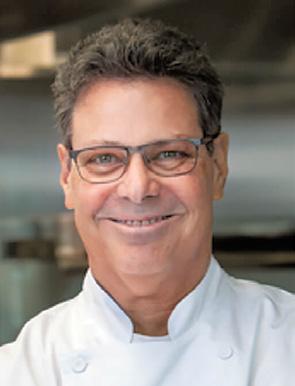
Gregory Schweizer, Corporate Executive Chef, is devoted to delivering high-quality culinary solutions through knowledge, strategy, and innovation. His extensive training includes studies at the Culinary Institute of America (CIA), Le Istituto Culinario de Toscano, Halliburton Institute of Technology, Eckerd College Management Development Institute, Darden University, and the Applebee’s Leadership Institute. Chef Greg’s comprehensive experience reflects his commitment to excellence in every aspect of the culinary industry.
trend to staple.”
Innovation does not stop at authenticity—it’s also about creativity. “Balsamic and ice cream, miso butter, mushroom with blueberry vinaigrette—these are pairings that surprise people but really
continued on page 110

Healthcare costs are projected to rise by about 8% in 2025, compounding similar increases over the past two years1. For businesses in the hospitality and food service industry, where margins can already be tight, these rising costs are becoming a significant challenge. From quick-service restaurants to large hotel chains, many employers are feeling the pressure of escalating health insurance premiums and seeking ways to manage these increasing expenses.
Healthcare costs continue to rise for a variety of reasons, and businesses in the hospitality and food service industry are not immune:
• Medical and general inflation are increasing faster than in non-healthcare industries, making healthcare more expensive overall.
• High rates of chronic conditions like obesity and diabetes, which are prevalent among both employees and guests, are driving up costs.
• Clinical personnel shortages are leading to higher labor costs and fewer medical professionals available to treat illnesses, increasing the need for more expensive treatments.
However, the greatest drivers of rising medical costs are the price of new technologies and drug costs, including specialty drugs such as GLP-1 medications like Ozempic and Wegovy, which can exceed $1,000 a month2. In the hospitality industry, where large numbers of employees rely on health insurance benefits, rising prescription
drug prices and specialty treatments are placing additional strain on healthcare plans.
In recent years, the cost of providing health insurance to employees has risen significantly. Between 2014 and 2024, health insurance premiums for family coverage rose by 52%, from an average of $16,834 to $25,572. Employers in the hospitality and food service sector— many of which are small- and mid-sized businesses—are paying an average of $19,276 of this cost, or 75% of the total premium.
As healthcare costs continue to rise, many businesses are faced with difficult decisions. To manage these rising expenses, some organizations may reduce benefits or move to high-deductible health plans, where employees shoulder a larger share of the premiums. In an industry known for high turnover, this can hurt recruiting and retention efforts, as workers may seek employers who offer more competitive benefits.
To stay ahead of rising healthcare costs, hospitality and food service businesses can adopt several strategies. Here are a few tools and approaches to consider:
• Use Data Analytics: Once a tool primarily available to large corporations, health claim data is now accessible to businesses of all sizes. Hospitality and food service companies can partner with experienced health insurance advisors to leverage data that helps identify trends in employee health claims, allowing for a more tailored approach to reducing costs.
• Harness the Power of Clinical Informatics: While data analytics can show where healthcare costs are rising, clinical informatics helps businesses understand why costs are increasing and what can be done to mitigate them.
• Leverage Contract Compliance: Ensuring that contracts with healthcare providers and pharmacy benefit managers (PBMs) are structured properly can yield substantial savings. A thorough review of contracts, especially for pharmacy benefits, can uncover discrepancies and lead to renegotiation for better terms.

• Seek Alternative Insurance Vehicles: Exploring alternative insurance plans like self-funded health plans or group captives can help food service and hospitality companies reduce their insurance expenses while improving employee health outcomes. Consult with your insurance broker to explore which options may be the best fit for your business and workforce.
By working closely with an experienced health insurance advisor, hospitality and food service businesses

Robert Fiorito serves as Vice President with HUB International Northeast, a leading global insurance brokerage, where he specializes in providing insurance services to the restaurant industry. As a 25+ year veteran and former restaurateur himself, Robert has worked with a wide array of restaurant and food service businesses, ranging from fast-food chains to upscale, “white tablecloth” dining establishments. Robert can be reached at 212-3382324 or by email at robert.fiorito@ hubinternational.com.
can better navigate the rising costs of healthcare. While healthcare expenses are unlikely to decrease in the short term, proactive planning and strategic decision-making can help stabilize these costs and create a more sustainable benefits plan.
Learn more at https://www. hubinternational.com/industries/ hospitality-insurance/
1 PwC, Medical cost trend: Behind the numbers 2025, accessed 2/13/25.
2 USA Today, “Wegovy costs $1,349 in the US vs. $92 in the UK. Why are weight loss drugs so pricey?” November 26, 2024.
3 Segal, What Are the Projected Health Plan Costs for 2025? Survey Finds Double-Digit Projected Rx Trends, September 18, 2024.
4 KFF, Employer Health Benefits, 2024 Summary of Findings, October 9, 2024.
5 McKinsey and Co., “The gathering storm: The transformative impact of inflation on the healthcare sector,” September 19, 2022.

Are you tired of constantly reaching out to your managers for updates, only to hear the same frustrating "I don't know" response? It's time to put an end to this madness and empower your management team to provide you with the crucial data you need. Here are six ways to improve communication with restaurant managers.
1. Implement a restaurant manager log
Let's ditch the outdated method of calling or texting for updates. Instead, create a tailored manager log. This tool ensures your managers answer key questions after each shift, covering everything from sales numbers to staffing and ticket times. Say goodbye to frantic phone calls and hello to immediate, organized updates.
You can use a simple binder with lined sheet paper, create a template you print each week, use one of your restaurant software programs that likely includes a communication tool, or purchase a simple journal where everything is recorded, noting what specifically you want to know each day, each shift.
2. Proactive text updates from restaurant managers
Flip the script by having your managers send you updates via text. Rather than asking if the food order was placed, have them text you details like the budget, expenses and order placement time. Set a rule that they must text you at least one hour before the order deadline, ensuring you're always in the loop and avoiding last-minute surprises.
You can keep these instructions in your manager log and make it part of the daily routine.
3. Simple 3x5 card method

Equip your managers with a handy 3x5 card that has printed crucial questions. These are the questions you frequently ask, and managers can jot down the answers throughout their shifts. When you do call, they'll be ready with the information at their fingertips, promoting efficiency.
4. Daily briefing call with restaurant managers
Consider scheduling a daily briefing call where managers report on crucial numbers and updates. While this might not be everyone's cup of tea, it does help keep everyone aligned and builds a culture of accountability and transparency.
However, be mindful of not hindering their decision-making abilities.
The more you communicate the more likely it is you’ll get the information across to each person, rather than relying on everyone to understand your expectations hearing them only once.
5. Leverage technology
Embrace project management software apps like Asana or monday.com. These tools, while not restaurant-specific, allow managers to input daily stats and updates, creating a digital trail accessible anytime, anywhere. No more constant calls disrupting your restaurant – gain insights at your fingertips.
By implementing these six ways to improve communication with restaurant managers, you're on your way to transforming from a reactive management style to a proactive one.

David Scott Peters is an author, speaker, restaurant expert and coach who coaches restaurant operators how to stop being prisoners of their businesses and to finally achieve financial freedom. His first book, Restaurant Prosperity Formula: What Successful Restaurateurs Do, teaches the systems and traits restaurant owners must develop to run a profitable restaurant. Thousands of restaurants have worked with Peters to transform their businesses. Get his free 30-minute training video http:// www.davidscottpeters.com.
These tools are fantastic for automating and sending reminders, so you don’t have to do any of it once it’s set up.
6. Reward proactive communication
Change your culture by recognizing and rewarding proactive communication. Acknowledge and reward managers and staff who consistently provide timely and accurate information. Whether through public acknowledgment, bonuses, or added responsibilities, create a culture that encourages proactive communication and leadership.
In the world of restaurant management, information is power. By implementing these six ways to improve communication with restaurant managers, you're on your way to transforming from a reactive management style to a proactive one. Empower your team, streamline communication and watch as your restaurant efficiency and morale soar.


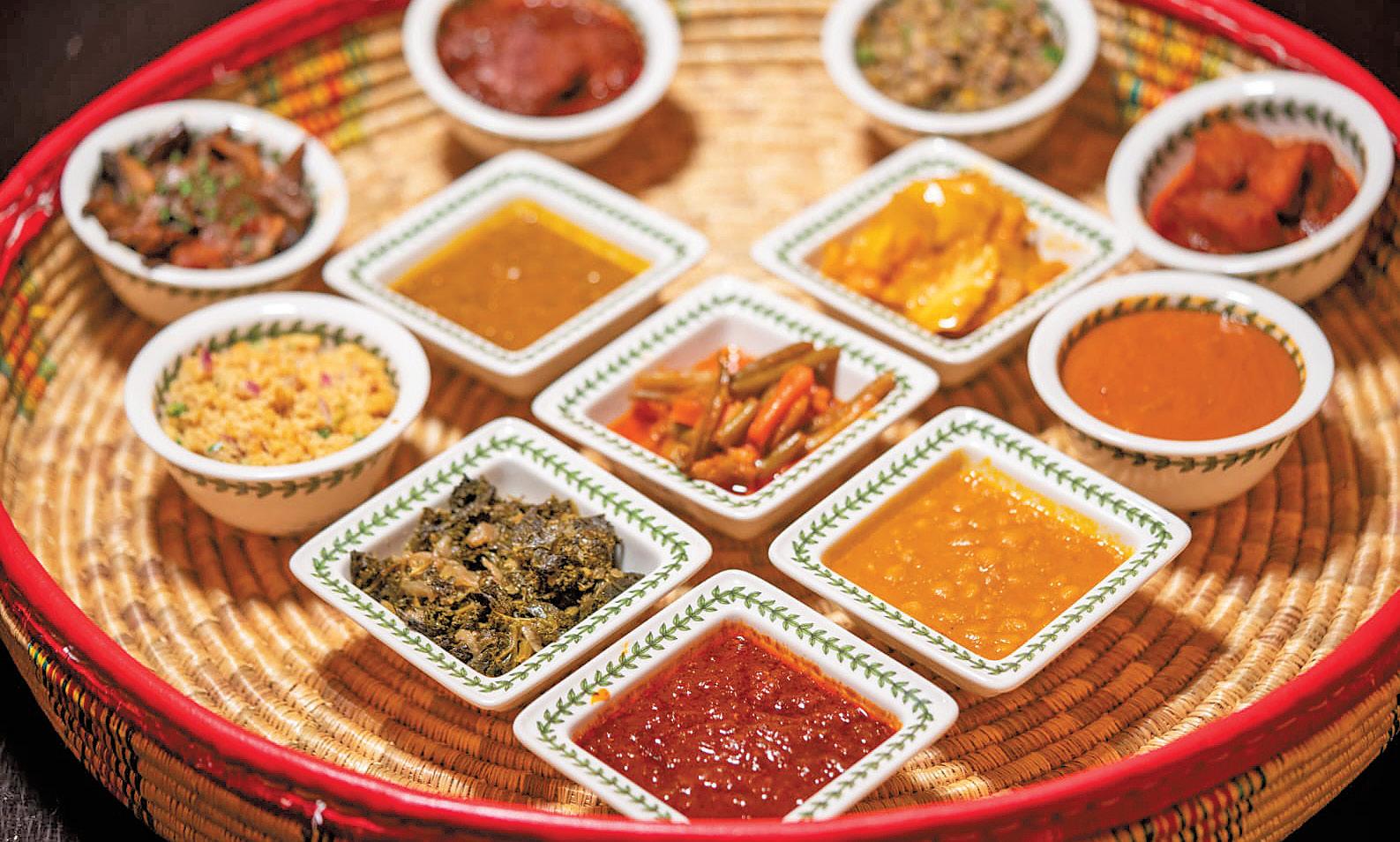
When I was a student at Butler University in Indianapolis, my Ethiopian roommate, Almaz, introduced me to the delights of her country’s cuisine—from the slightly sour and spongy injera to the bold, aromatic flavors of berbere and the hearty, comforting wat. During a trip to DC with Almaz to enjoy Ethiopian restaurants, I learned that Ethiopian food naturally celebrates plant-based ingredients, with lentils, chickpeas, greens, and vegetables taking center stage in many traditional dishes. Rooted in Ethiopia’s Orthodox Christian fasting traditions, these vibrant, spice-infused meals have been enjoyed for centuries, long before plantbased eating became a global trend.
While Washington, D.C. remains a hub for Ethiopian cuisine, its flavors have spread nationwide, including to Montclair, New Jersey, home to Mesob, an award-winning Ethiopian restaurant. Founded in 2003, Mesob was recently voted #1 Most Popular Culinary Destination in Montclair by BestofNJ.com, thanks in part to its authentic approach and its diverse, plant-forward menu that appeals to vegans, vegetarians, and omnivores alike.
To uncover the secrets behind Mesob’s two-decade success, I caught up with Berekti Mengistu, the restaurant’s co-founder. In our conversation, she shares how Mesob has evolved to meet changing tastes while staying true to its roots, offering an immersive dining ex-
perience for all who seek to explore the rich flavors of Ethiopia.
How would you describe Ethiopian cuisine to someone who is trying it for the first time?
Ethiopian cuisine is a vibrant, communal experience centered on bold flavors, rich spices, and wholesome ingredients. Meals are traditionally shared from a large platter, fostering a sense of togetherness. It’s more than just food; it’s an expression of culture, hospitality, and love.
What does Mesob mean?
A Mesob is a traditional Ethiopian handwoven wicker basket, historically used as both a table and a storage con-

Cherry Dumaual is a seasoned contributing writer for Total Food Service, bringing years of experience in culinary communications to her role. As the former Partnerships Director at The Monday Campaigns/Meatless Monday, she was responsible for spearheading the PR and partnership development for Monday initiatives, including Meatless Monday. During her tenure, she successfully forged partnerships with renowned organizations, such as C-CAP (Careers for Culinary Arts Program), the American Institute of Cancer Research, and New Jersey Healthy Kids Initiative. Prior to joining TMC, Cherry held the position of Senior Vice President at leading PR agencies, where she worked with major food and healthcare clients. Her passion for learning and cooking international cuisines has led her and her husband to explore local food markets and restaurants in over 50 countries. This firsthand experience has allowed her to gain a deep understanding of different cultures and cuisines, which she brings to her work in the food industry.
tainer for injera. It symbolizes community, togetherness, and the joy of sharing a meal, which is a perfect reflection of Ethiopian dining culture.
Mesob has been in business since 2003. How did you get started? What were the early years like?
My sister Akberet, who is a co-founder of Mesob, and I come from a large, closeknit Ethiopian family where cooking was a daily tradition for many. Preparing meals was not just about feeding people; it was about bringing them together in a warm and joyful space. Opening Mesob was a natural extension of that love for food and hospitality. In the early years, we focused on introducing the beauty of Ethiopian cuisine to new audiences while staying true to our roots.
How has your menu evolved through the years to accommodate changing food preferences?
Health and authenticity have always
continued on page 98



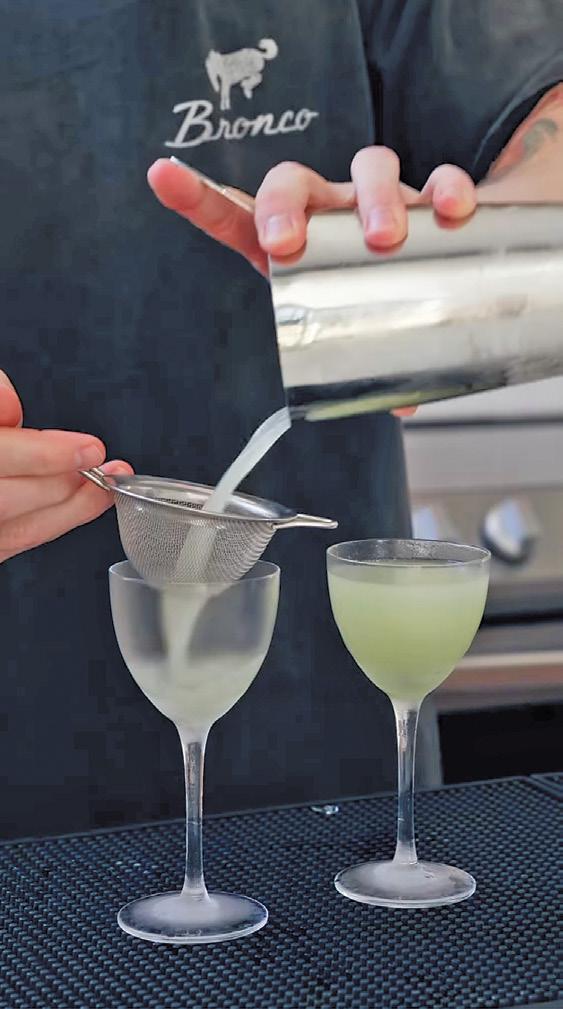

In an era where escalating food and labor costs are squeezing profit margins, bar and restaurant owners face the pressing challenge of maintaining profitability without compromising quality or customer satisfaction. Chris Leavitt, Content Creator and Industry Consultant at Not Just A Bartender, offers invaluable insights into maximizing bar profits through strategic beverage menu design and operational efficiency.
The restaurant industry has undergone significant transformations in recent years, with rising food prices and increased labor costs becoming persistent concerns. According to industry reports, many establishments operate on razor-thin margins, making profitability a constant challenge. Leavitt emphasized, “In today’s economic climate, it’s essential for bars to optimize every aspect of their op -
erations to remain profitable.”
Leavitt’s career trajectory is a testament to passion and adaptability. Starting as a bartender during his college years at Penn State Harrisburg, he briefly ventured into pharmaceutical sales before realizing his true calling lay in hospitality. A pivotal business trip to Las Vegas exposed him to the city’s vibrant bar scene, inspiring him to relocate and immerse himself fully in the industry. Over the years, Leavitt honed his skills at notable establishments, including Carson Kitchen and Barry’s Downtown Prime at Circa Resort & Casino. Reflecting on his journey, Leavitt noted, “Each experience allowed me to understand different facets of the business, from mixology to operations, shaping my approach to bar management.”
A well-curated beverage menu is pivotal in driving profitability. Leavitt advocates for a strategic approach:
regularly analyzing the menu to identify high-profit items, promoting them through strategic placement and vivid descriptions, and removing underperforming items to streamline operations. “Review your pricing structure to balance profitability with customer value,” he said. “Consider factors like ingredient costs, preparation time, and market competition when setting prices.” He also recommends developing signature cocktails using cost-effective ingredients that are perceived as premium. “This allows for higher price points and differentiates your bar from competitors,” Leavitt said. With a growing trend towards reduced alcohol consumption, bars must innovate to cater to this demographic. Leavitt advises against merely creating non-alcoholic versions of existing cocktails. Instead, he encourages bars to craft non-alcoholic drinks that stand on their own, offering

unique flavors and experiences. “This not only caters to health-conscious patrons but also showcases the bar’s creativity,” he said. Investing in highquality mixers, fresh ingredients, and artisanal syrups can elevate the flavor profiles of these offerings and turn them into destination drinks in their own right.
Operational efficiency is closely tied to the tools and training provided to the bar team. Leavitt stresses the importance of empowering bartenders with what they need to succeed. “Ice plays a crucial role in the presentation and dilution of cocktails,” he noted. “Investing in quality ice machines ensures consistency.” He pointed to companies like Hoshizaki as examples of technology partners that can streamline operations, reduce waste, and ensure consistent product qual -
continued on page 106
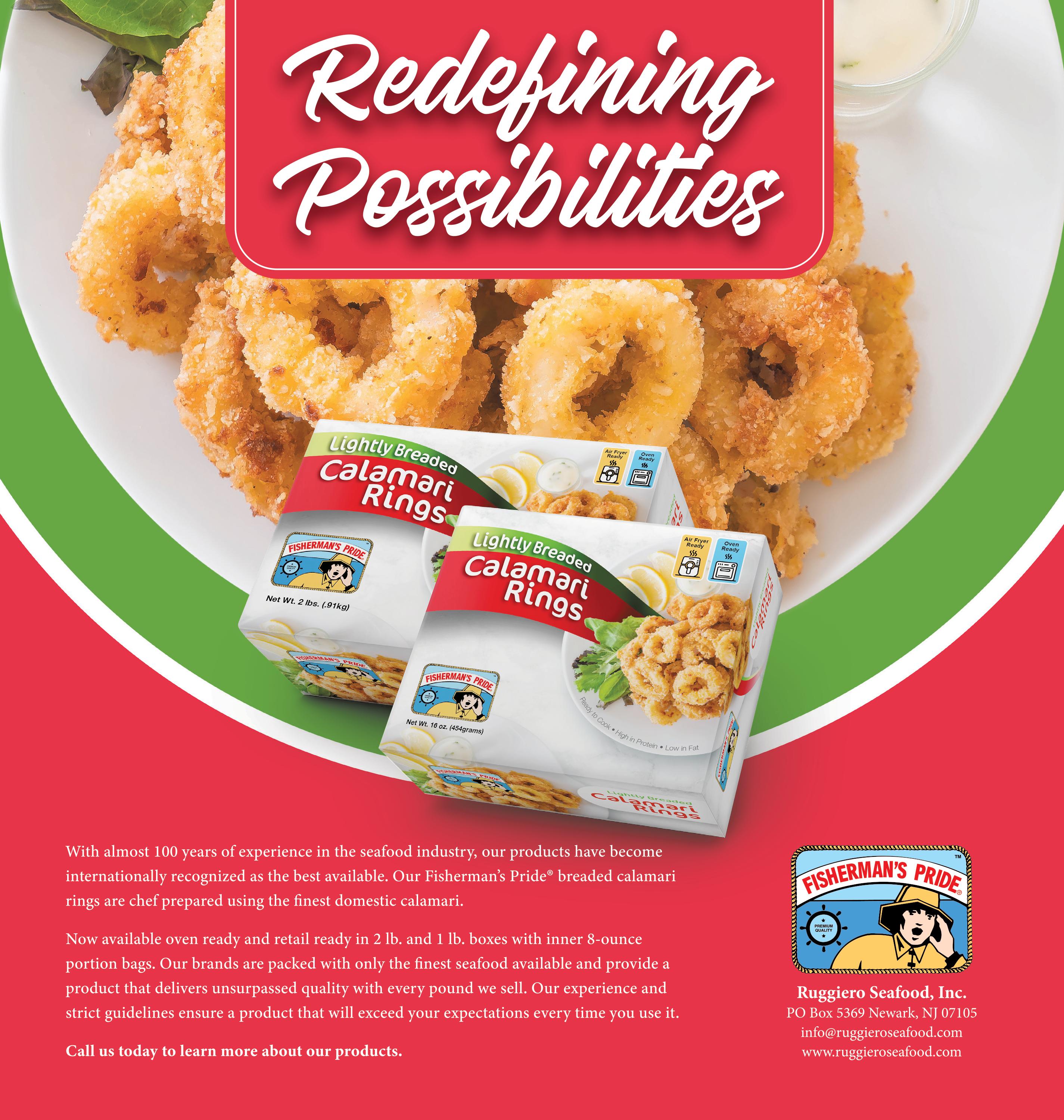
If you told me 20 years ago that I'd be leading culinary innovation for one of the most exciting companies in senior dining, I probably would’ve raised an eyebrow—and then asked what was on the menu. My journey into foodservice started like many others: in a bustling kitchen, behind the line, learning the rhythms of a restaurant from the ground up. But over the years, what pulled me in deeper wasn’t just the food. It was the people—especially those whose needs are often underserved. That’s what led me to Restaura. At Restaura, we’re not just serving meals. We’re rewriting the expectations for what senior dining can be. And that starts with recognizing that the audience has changed. Today’s seniors aren’t the same as the generation before them. They’re more health-conscious, techsavvy, and culinarily curious than ever. They've traveled. They’ve experienced global flavors. And they expect more than meatloaf Thursdays.
This shift has fundamentally changed how we think about senior dining. No longer is it about “playing it safe” with the menu or assuming limitations. It’s about creating an experience that reflects who today’s seniors really are: vibrant, engaged individuals who are looking for quality, variety, and dignity in every aspect of their lives—including their meals.
One of the biggest transformations in our approach is how we view nutrition. In the past, nutrition in senior dining was too often reduced to restrictive diets and bland plates. But at Restaura, we believe that food should not only be functional—it should be joyful. We’ve developed a holistic nutrition-forward philosophy. That means crafting menus that balance macronutrients, accommodate medical conditions, and also

Today’s seniors are more open to technology than we give them credit for. Many use tablets, smartwatches, or voice assistants daily. So, we’re integrating tech tools that elevate the dining experience rather than complicate it.
celebrate flavor. We’re seeing a rise in plant-based options, global cuisines, and wellness-boosting ingredients like turmeric, chia, and fermented foods.
We’re proud of the menus we’re crafting at Restaura—menus that reflect both nutritional needs and culinary excitement. You’ll find dishes like grilled salmon with quinoa and citrus herb vinaigrette, turmeric-roasted cauliflower steaks, and pho-inspired chicken noodle soup with ginger and scallions. For breakfast, we’re serving avocado toast with poached eggs and smoked paprika, alongside classics like whole grain waffles with seasonal berries. And yes, we still honor comfort favorites— just reimagined. Think mac and cheese
with a protein boost and heart-healthy twists. Every item is designed to nourish the body and satisfy a new generation of seasoned palates.
But we’re not just throwing trendy items onto plates. We’re listening to our residents. We ask them what they want, what they love, and what food means to them. That feedback becomes part of our culinary roadmap. It’s co-creation at its best.
Another critical piece of the transformation puzzle is technology. For years, tech has been an afterthought in senior dining spaces. But that’s changing fast—and Restaura is helping lead the charge. Today’s seniors are more open to technology than we give them credit
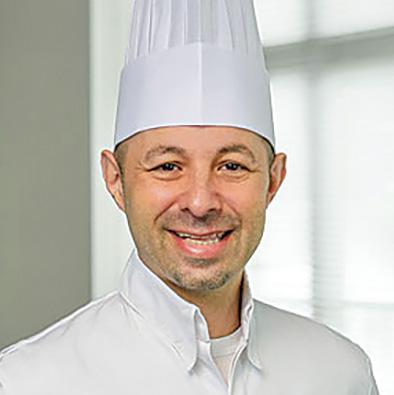
Chef Matthew Thompson is a distinguished culinary executive celebrated for his innovative and sustainable approach to menu development and hospitality. With over 25 years in the industry, Chef Matthew has established operational systems that drive meaningful social and economic impact. At Restaura, he is devoted to advancing culinary artistry through creative menus and fostering a team culture focused on dynamic, responsibly sourced dining experiences. Throughout his career, Chef Matthew has championed plant-based diets and sustainable lifestyles, contributing to Food Solutions New England and serving on the Farm to Institution New England advisory council. He is also a sought-after speaker for sustainabilityfocused organizations such as AASHE, the Culinary Institute of America, and others. Previously, Chef Matthew cofounded Harvest Table Culinary Group, a farm-to-institution dining venture that emphasized regional sourcing and wellness in universities. He spearheaded programs in data-driven food tracking and partnered with the World Resource Institute for climate-forward initiatives. Chef Matthew also held roles in Culinary Operations and Sustainability at Aramark Corporation.
for. Many use tablets, smartwatches, or voice assistants daily. So, we’re integrating tech tools that elevate the dining experience rather than complicate it. Think digital ordering systems that allow residents to customize meals with the swipe of a finger. Smart kitchen tech that ensures consistent quality and portion control. Nutritional dashboards that
continued on page 102

Total Food Service is always seeking out voices that shape and redefine the culinary landscape. Few chefs embody this mission as fully as Chef Serigne Mbaye , the visionary behind Dakar NOLA in New Orleans. With roots spanning Harlem, Senegal, and New Orleans, Chef Mbaye has seamlessly woven his cultural heritage into a cuisine that is at once deeply personal and widely celebrated.
His journey—from training at the New England Culinary Institute to staging at Commander’s Palace, refining his craft at Atelier Crenn and L’Atelier Joel Robuchon, and ultimately creating a James Beard Award-winning restaurant—is nothing short of inspiring. He has not only redefined modern Senegalese cuisine but has also placed it firmly on the national stage, earning accolades from Bon Appétit, Eater, TIME100 Next, and beyond.
We had the privilege of talking with Chef Mbaye to discuss his path, his philosophy on food, and how he envisions the future of Senegalese cuisine in America. Our conversation covered everything from his formative years in Senegal and Harlem to the ethos behind Dakar NOLA and the impact of his James Beard Award win.
Now, let’s dive into the conversation with the chef who is redefining modern West African cuisine in America.
continued on page 38

by Clay Williams
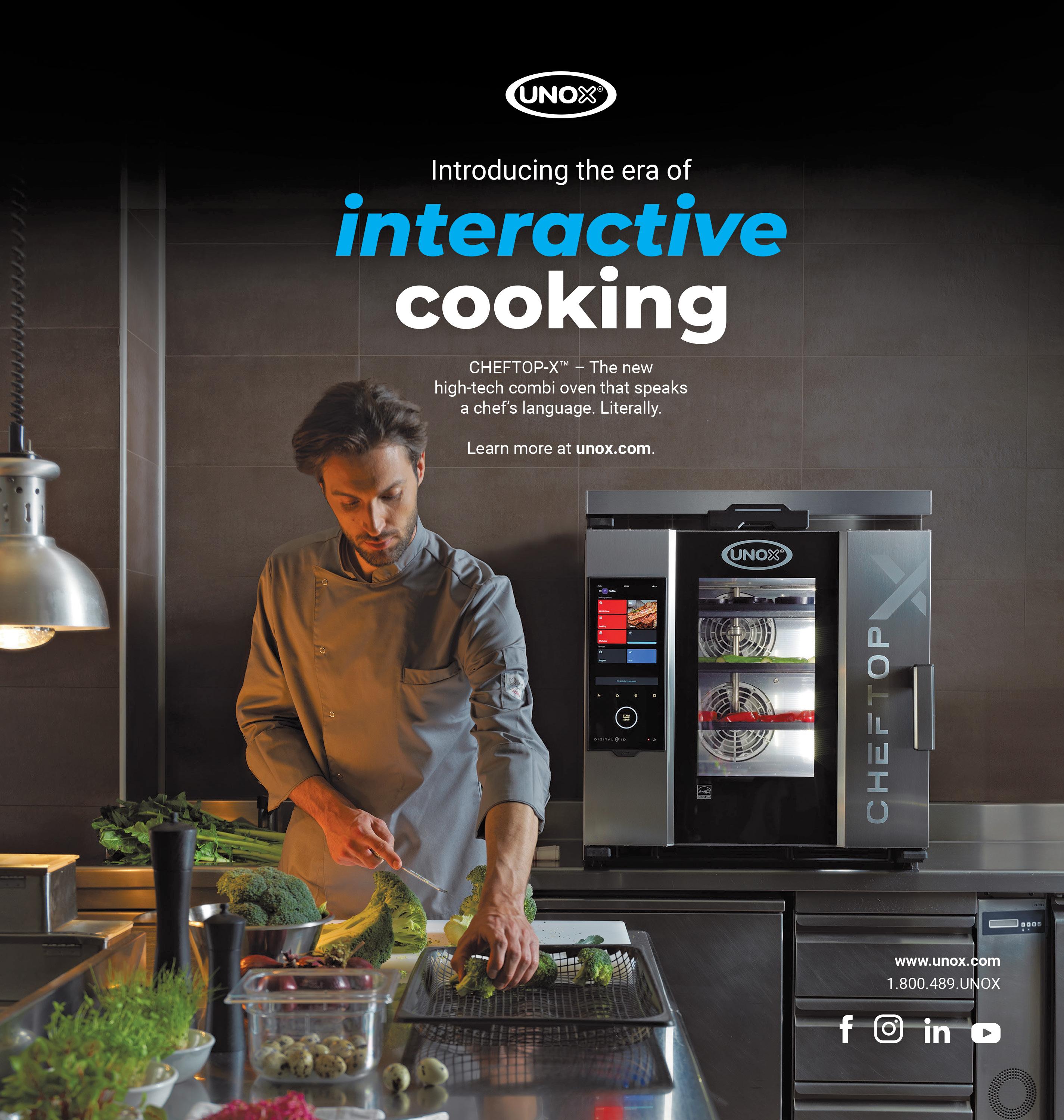
While growing up in Harlem and Dakar, can you talk a little bit about the role that food played in your childhood?
Absolutely. Growing up in Senegal, food was a huge part of my childhood. I went to a boarding school, and as men, we did everything—we cooked, we cleaned. That experience really shaped my perspective early on. My mother also owned a Senegalese restaurant in Harlem in the late ‘80s, so I was exposed to the restaurant world from a young age.


tute, which had a French-based culinary program that really intrigued me.



















My older brother had also talked about NECI, and that put it on my radar. I was really curious about French techniques because, historically, Senegal was colonized by France, and I knew a lot of our cooking methods were influenced by French cuisine. I wanted to see that connection for myself.
In Senegal, food is not just about eating—it’s communal. We sit together, eat from the same plate, and share stories. That sense of togetherness is something I carry with me to this day.
What brought you back to the States and, eventually, to culinary school in New England?
I returned to the U.S. when I was about 14 or 15, and even though I was born in Harlem, I barely spoke English. After finishing high school, I worked in a few good restaurants, but I realized I wanted to take cooking more seriously. That led me to the New England Culinary Insti-









Did you already have a clear culinary style at that point?
Not really. The program was very French-driven, so I was learning classical techniques. But I was also really curious—I wanted to go beyond the familiar, to step outside my comfort zone. That’s what led me to pursue restaurants outside of my cultural background before fully embracing Senegalese cuisine.
After culinary school, what were the key steps that led you to New Orleans?
After graduating, I worked at The Redding Room in New York and was supposed to do an internship in Paris, but
continued on page 40


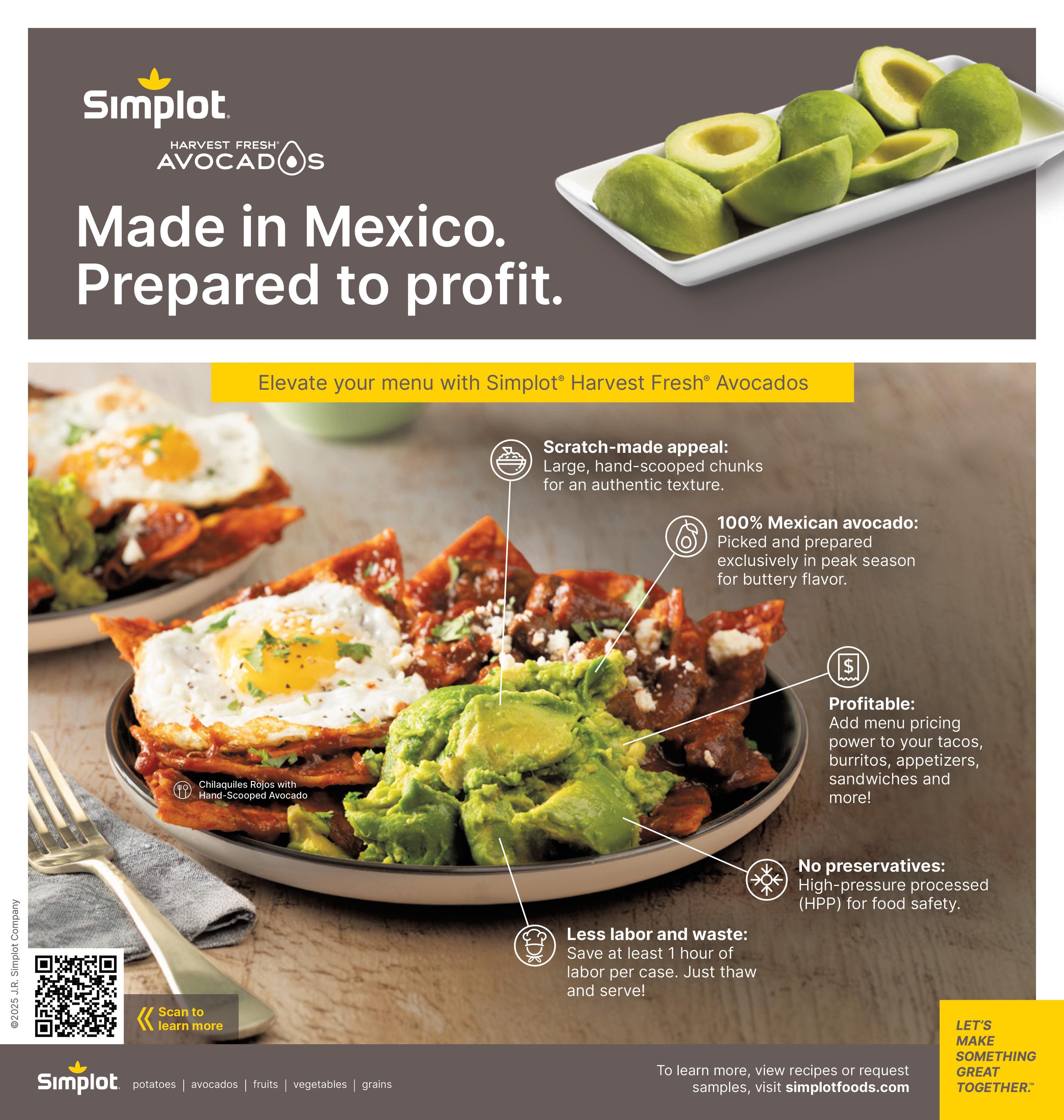
financially, it didn’t work out. Instead, I went to Cleveland for six months. After that, I decided to visit home in Senegal since I hadn’t been back since I was a teenager.
On my flight back, I had a chance encounter with some people from New Orleans who were involved with the Giving Hope Foundation. They introduced me to Tory McPhail, the executive chef at Commander’s Palace, and that’s how I ended up in New Orleans.
What was it like working at Commander’s Palace? What did you learn there?
It was an incredible experience. I learned everything from prepping Cajun and Creole dishes to understanding Southern hospitality and cooking at a high volume. We were serving hundreds of guests per night, so it was fast-paced. But most importantly, I started to see the connections between New Orleans and Senegalese cuisine—from gumbo to étouffée, the similarities were striking.


That was a big moment for me. It also taught me about discipline and consistency. At Commander’s, every plate had to be perfect, and that level of attention to detail has stayed with me.
How do you see Senegalese cuisine evolving in America?
I think West African cuisine is having a moment, but it’s still just the beginning. People are becoming more curious about food beyond the usual French, Italian, and Japanese influences. Sen-


egalese food, in particular, has so many layers—there’s depth, spice, and history. I see it growing in popularity, especially as more chefs explore their roots and diners become more adventurous.
Do you see more Senegalese or West African fine dining in the future? Yes, and I want to be part of that movement. There’s no reason why Senegalese cuisine can’t be represented at the high-
continued on page 42

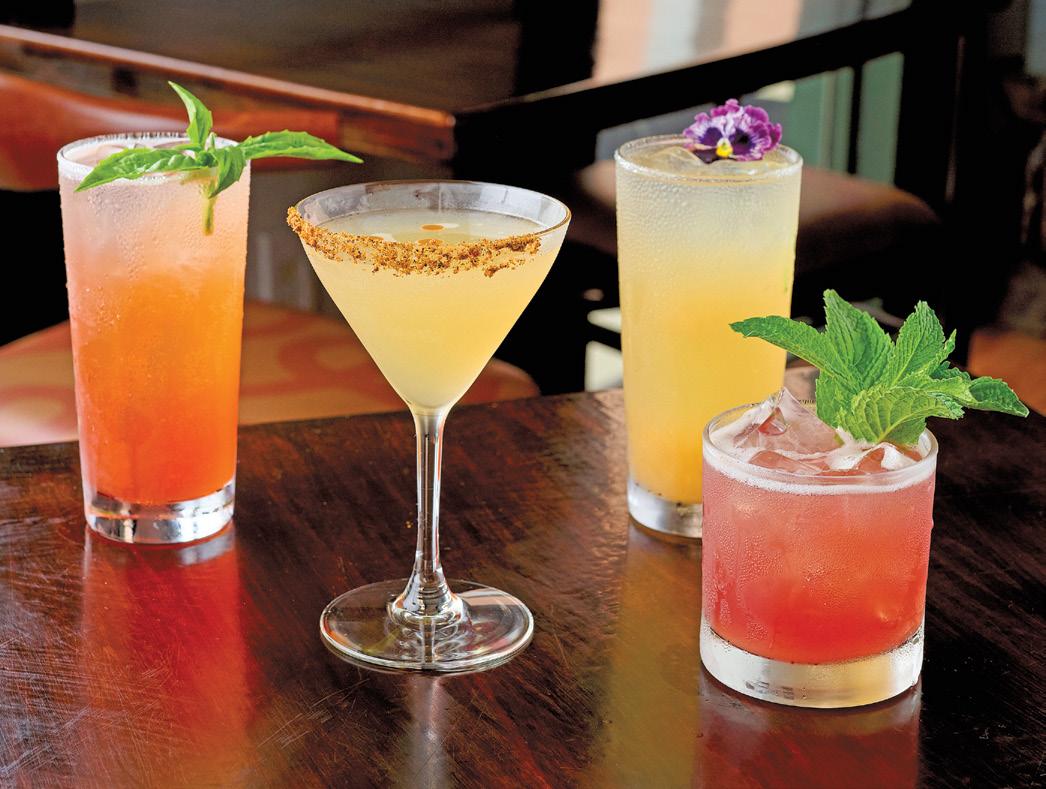

est levels of fine dining. You see it happening with Japanese, Korean, and Indian restaurants—West African food is next.
What challenges have you faced as a Black chef in fine dining?
There aren’t a lot of chefs who look like me in the fine dining world, especially at the level of Michelin-starred restaurants. That comes with challenges—sometimes people don’t take you seriously, or they assume you only cook a certain type of food. I’ve had to work twice as hard to prove myself.
How have you navigated those challenges?
By staying focused on my craft. I let my food speak for itself. I also surround myself with people who believe in the vision—mentors, peers, my team. When you have confidence in what you’re doing, the noise doesn’t matter as much.
How do you manage stress in such a demanding industry?
It’s tough. The restaurant industry isn’t built for balance, so you have to be intentional about it. I try to take time for myself, even if it’s just an hour to listen to music or go for a walk. I also make sure my team gets breaks—it’s important to take care of your people.
What keeps you inspired?
Traveling. Music. Learning from other chefs. I try to keep evolving, so I never feel stuck.
Which chefs or figures have inspired you the most?
Pierre Thiam is a big one—he’s been bringing Senegalese cuisine to the world for years. Also, Tory McPhail at Commander’s Palace and Dominique Crenn—she taught me how to tell a story through food. But my biggest inspiration is my mother. She ran her own restaurant in Harlem, and I always admired her work ethic.
continued on page 44

A quintessential part of Dakar NOLA's success also goes to Managing Director and owner Dr. Afua “Effie” Richardson, as she is the backbone of the front of house operations. A board-certified pediatric dentist by training and a hostess by inclination, Dr. Richardson was born in Pennsylvania of Ghanaian parents. (Photo by Jeremy Tauriac)


When people look back on your career in 20 years, what do you want to be known for?
I want to be known as someone who helped put Senegalese cuisine on the global stage. I want young chefs to see me and realize they can embrace their roots and still be innovative.
What impact do you hope to have on the next generation of chefs?
I want to create opportunities for African chefs. Whether it’s through mentorship, training, or helping them open their own spots, I want to make sure that West African cuisine keeps growing.
If you had one piece of advice for chefs looking to incorporate their heritage into their cooking, what would it be?
Know your history. Learn about the flavors, the techniques, the traditions. And then, don’t be afraid to innovate. That’s how you create something lasting.
What does it mean to you to represent Senegalese cuisine on such a global stage?
It’s an honor, but it’s also a responsibility. I’m not just cooking for myself—I’m carrying my culture with me. Every dish I put on the plate tells a story about where I come from, about the people and traditions that shaped me. And I want people to taste that. I want them to understand that Senegalese cuisine isn’t just flavorful—it’s historical, it’s emotional, it’s powerful.
Do you ever feel pressure to “educate” through your food?
All the time. But I welcome it. A lot of people don’t know about West African food beyond maybe jollof rice or peanut stew, so I see every meal as an opportunity. When someone tastes yassa or thieboudienne for the first time and is blown away, that’s a moment. And if they ask questions—where’s this from, what’s in it—I’m happy to explain. Food is a gateway to culture.
How do you balance tradition with innovation in your cooking?
By understanding the roots. You can’t innovate if you don’t understand what you’re building from. I take traditional
Senegalese dishes and then think about how I can elevate them—maybe it’s through presentation, maybe it’s technique. I want to respect the original dish, but I also want to push it into new territory. That’s how you keep a cuisine alive.
What’s one Senegalese dish you think the world really needs to try?
Thieboudienne, without a doubt. It’s our national dish—rice, fish, vegetables, all cooked in this rich tomato base. It’s bold, it’s satisfying, and it’s full of layers. Every family has their own version, and every bite tells you something different. If people try that one dish, I think they’ll start to understand the depth of our cuisine.
You mentioned your mother earlier—what lessons did she teach you about food or business that you carry with you?
She taught me that food is love, and that hard work always matters. She ran her restaurant with so much pride, even when it was tough. She didn’t have investors or a fancy team—just grit, flavor, and faith. Watching her, I learned that authenticity connects with people. She didn’t change her recipes to please anyone. She cooked what she knew, and people came because it was real. I try to do the same thing.
Looking ahead, what’s next for you?
I want to open a fine dining restaurant that showcases the full range of Senegalese cuisine—not just the hits, but the deep cuts, the regional dishes, the lost recipes. I want to build a space where our food is treated with the same reverence as any other globally celebrated cuisine. And I want to build a team of African chefs who believe in that vision.
And what legacy do you hope to leave behind?
That I helped redefine what African food could look like at the highest level. That I created space for the next generation of chefs to be bold, to be proud of where they come from, and to never feel like they have to choose between excellence and authenticity.
All photos courtesy of Dakar NOLA unless listed otherwise

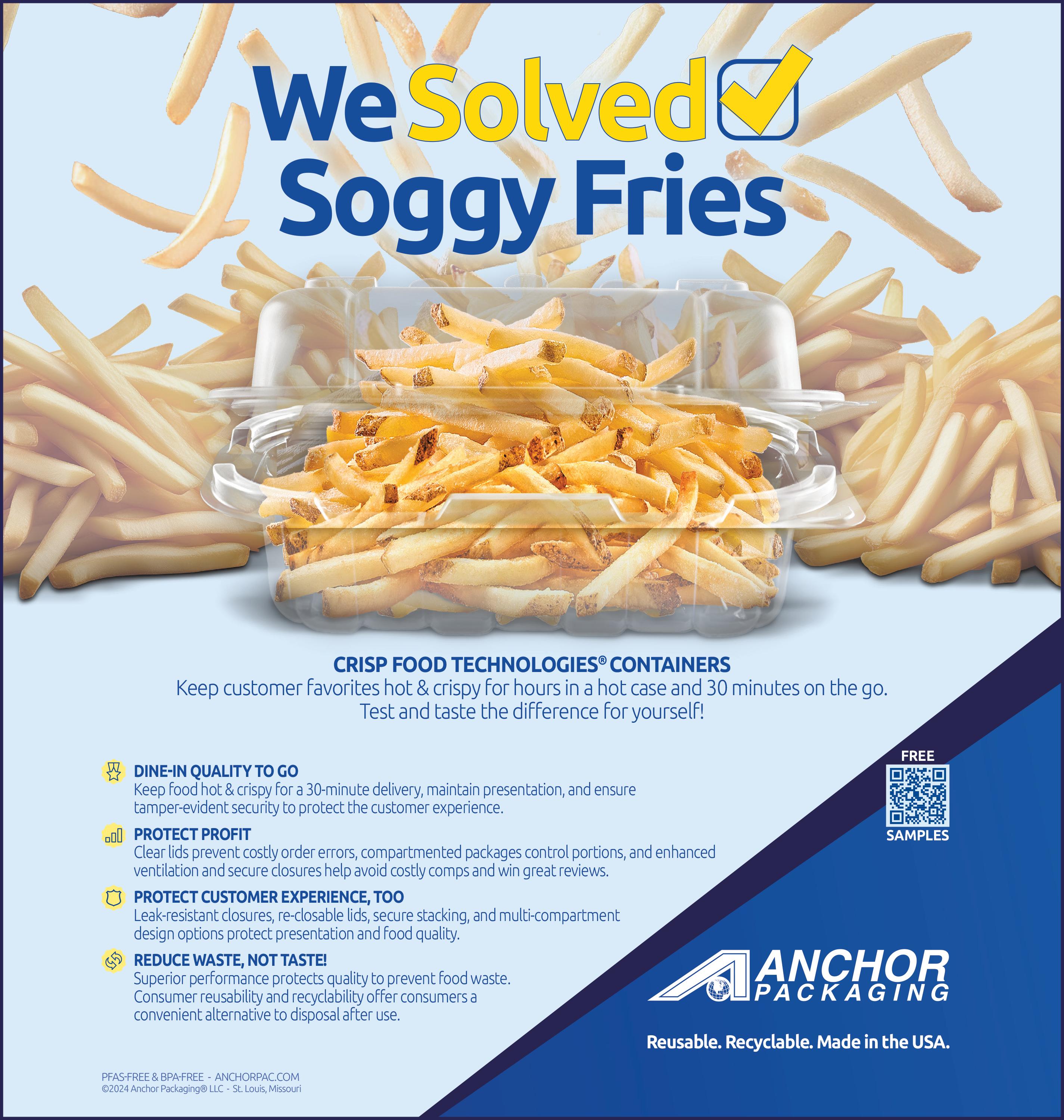
When guests walk into a restaurant, their first impression is often dictated by the decor, lighting, and—most importantly—the furniture. Seating arrangements, table choices, and overall layout influence not only the aesthetic appeal but also the way customers interact with the space. Whether it’s an intimate fine-dining experience with plush velvet chairs or a bustling café with sleek minimalist seating, furniture plays a crucial role in defining the restaurant’s identity.
Every restaurant tells a story, and furniture is a fundamental part of that narrative. From color schemes to materials, every detail should align with the restaurant’s theme and brand identity. While a rustic farm-to-table restaurant may opt for reclaimed wood tables and industrial metal chairs, a high-end sushi bar might lean towards sleek, modern designs with minimalist aesthetics. Every furniture choice should reinforce the restaurant’s personality, making it instantly recognizable and inviting. “Owners must think beyond function and consider how every element ties into their brand,”
“Furniture is the face of every restaurant. It sets the tone, defines the atmosphere, and shapes the customer experience.” — Vlad Spivak
added Yana Katliarova, Managing Partner at Modern Line Furniture.
New Jersey based Modern Line Furniture is a leading provider of highquality, commercial-grade furniture designed for the restaurant and hospitality industry. With years of expertise in crafting durable, stylish, and functional furnishings, Modern Line understands the unique demands of high-traffic environments. Their innovative designs blend aesthetics with practicality, offering solutions that enhance guest experiences while ensuring longevity and ease of maintenance. From sleek seating options to versatile dining and lounge furniture, Modern Line delivers customized, space-efficient solutions tailored to the needs of hospitality professionals. With a commitment to quality and modern design, they help businesses create inviting and lasting interior spaces.
In an era where restaurant opera-

tions must adapt quickly to changing customer needs, modular furniture provides an essential advantage. Modular booths, convertible tables, and lightweight chairs allow restaurants to rearrange seating based on reservation sizes, private events, or shifts in dining trends. “Many restaurant owners come to us with a blueprint and a seating capacity requirement. Our job is to maximize that space efficiently while maintaining comfort and aesthetic appeal,” detailed Spivak. He noted that the ability to quickly reconfigure a dining area not only improves customer experience but also enhances service efficiency.
Restaurant furniture endures daily wear and tear, making durability a top priority. Owners must choose materials that balance aesthetics with functionality. “High-traffic establishments need materials that can withstand spills, cleaning, and constant use without los-
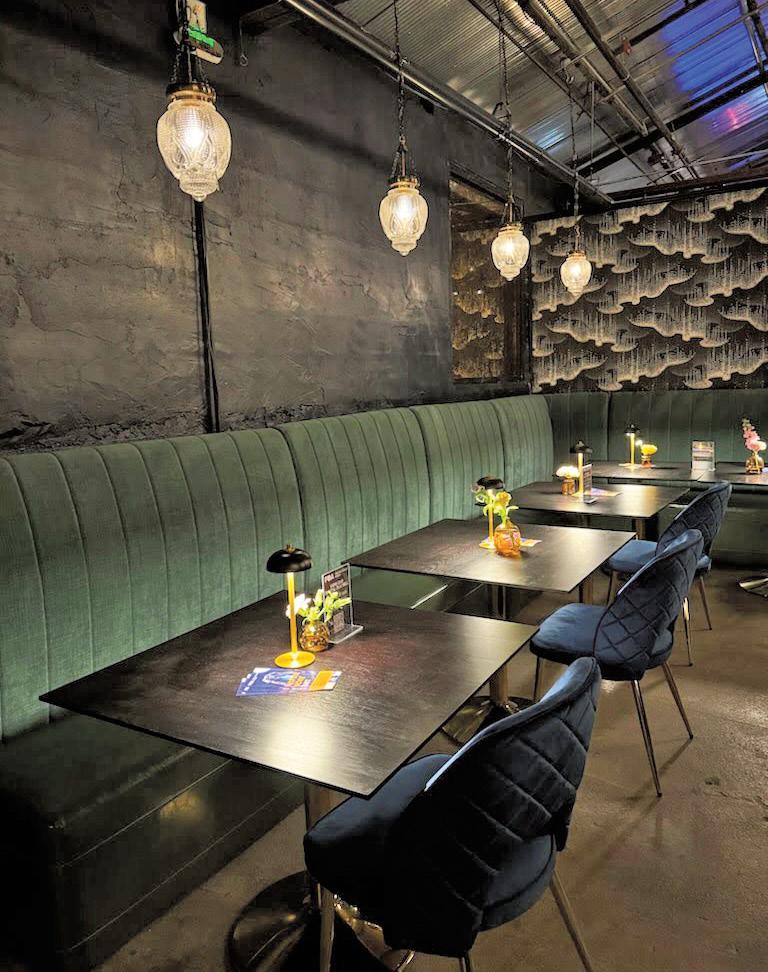
ing their appeal,” Spivak explained. For long-lasting furniture, some of the best material options include high-abrasion vinyl, which is easy to clean and highly resistant to wear; laminate surfaces, known for their durability and low maintenance, making them ideal for tabletops; and metal or reinforced wood, which provide exceptional strength for chairs and tables that experience heavy use. Choosing the right materials not only enhances durability but also reduces maintenance costs, ensuring that furniture investments remain functional and aesthetically pleasing for years. The design of seating influences how long customers stay, how they interact with the space, and their overall dining satisfaction. Fine dining establishments often choose ergonomic seating that encourages relaxation, while quick-service restaurants focus on designs that facilitate faster table turnover. Lounges and cocktail bars may opt for lower seating with a more relaxed posture to encourage extended stays and additional orders. “The seating choice can dictate continued on page 104



WHAT WE’RE READING: WHAT WE’RE WATCHING:

This Earth Day, let’s come together to regenerate our planet! Join the movement with the award-winning documentaries Common Ground and Kiss the Ground, streaming on Amazon Prime on April 22, 2025.
These films reveal how regenerative agriculture can heal our soil, balance the climate, and secure a healthier future for generations to come. Featuring Laura Dern, Jason Momoa, Rosario Dawson, and more, these stories will leave you inspired to take action.
Common Ground is the award-winning documentary about how we can restore our soil, health, and planet

with regenerative agriculture practices. It features Laura Dern, Jason Momoa, Donald Glover, Rosario Dawson, Woody Harrelson, and Ian Somerhalder along with farmers, ranchers, scientists, scholars, and more! You will walk away feeling hopeful about how we can reverse desertification, biodiversity loss, and grow a healthy future for all!
It is the highly anticipated sequel to the juggernaut success documentary, Kiss the Ground, which touched over 1 billion people globally and inspired the United States Department of Agriculture (USDA) to put $20 billion toward soil health. By fusing journalistic expose’ with deeply personal stories



WHAT WE’RE LISTENING TO:

from those on the front lines of the food movement, Common Ground unveils a dark web of money, power, and politics behind our broken food system.
The film reveals how unjust practices forged our current farm system in which farmers of all colors are literally dying to feed us. The film profiles a hopeful and uplifting movement of white, black, and indigenous farmers who are using alternative “regenerative” models of agriculture that could balance the climate, save our health and stabilize our economy before it’s too late.
Narrated and featuring Woody Harrelson, Kiss the Ground is an inspiring and groundbreaking film that reveals
the first viable solution to our climate crisis. Kiss the Ground reveals that, by regenerating the world’s soils, we can completely and rapidly stabilize Earth’s climate, restore lost ecosystems and create abundant food supplies. Using compelling graphics and visuals, along with striking NASA and NOAA footage, the film artfully illustrates how, by drawing down atmospheric carbon, soil is the missing piece of the climate puzzle.
Matt Sartwell, Managing Partner, Kitchen Arts & Letters Bookstore in New York City shares his book reviews...
Spirited Women: Makers, Shakers, and Trailblazers in the World of Cocktails by Sammi Katz and Olivia McGiff
From bartenders to master distillers to brand founders, this book highlights 55 important women in the spirits and cocktail business. With profiles and recipes, it demonstrates the range of creativity, passion, and focus they use to make their mark.
Written by Sammi Katz, an NYC cocktail pro, and illustrated with verve by Olivia McGiff, Spirited Women can introduce you to the likes of:
• Lesley Grace, master distiller at Hendricks Gin
• Andrea Wilson, master of maturation and chief operating officer of Michter's
• Julia Momose, founder of Kumiko bar in Chicago
• Shannon Mustipher, rum expert and author
• Eileen Wayner, Alex Smith, and Lola Thomas, who run the annual Tales of the Cocktail conference
The book's scope underscores the many varied paths which women have taken to achieve significant places in the world of spirits, offering motivation and guidance to others who aspire to achieve something similar. Fun and inspiring.
by Ángel León
This impressive set of books offers an immersion into the cuisine, philosophy, and history of one of the most renowned restaurants in Spain, which is famous for its commitment to seafood and sustainability.
Chef Ángel León places a heavy emphasis on cooking with marine animals which might be discarded as trash fish or otherwise overlooked. His resourcefulness extends to ocean and marshland plants as well as phytoplankton.
The cooking is technically ambitious and innovative. Like Josh Niland, León seeks to avoid waste wherever possible. He explores ways to use every possible part of the creatures he serves, producing a guanciale from shark meat, a form of miso and tofu from the beans of a
plant which grows in salty soils, and even a seaweed cola.
Aponiente's location in in the port city of Cadiz, near where the Atlantic meets the Mediterranean, means that the restaurant has access to a wide range of seafood. But even cooks who don't have the same access will find the sheer imagination and virtuosity of the chef's approach to be inspiring.
The six paperback volumes come in a handsome slipcase. Their colorful titles are:
• Volume 1. Past, present and future
• Volume 2. Inspiration and game
• Volume 3. The marsh, the environment
• Volume 4. Tradition and caresses
• Volume 5. Soul and classicism
• Volume 6. Sweet Salt
Presentation photography reflects an elegant, minimalist style. Six paperback volumes with jackets in a slipcase. Color photographs throughout. In Spanish and English.

Editor’s Note About Podcasts- Listen and subscribe wherever you get your podcasts, including on Apple Podcasts, iHeart, Spotify, Stitcher, Google Podcasts, Audible & more.
Lara Prendergast and Olivia Potts interview notable guests about their life, through the food and drink that has come to define it. Lara Prendergast is the Food and Drink Editor of Spectator Life. Olivia Potts is Spectator Life's Vintage Chef.

In an industry where every seat, every table, and every moment of customer experience matters, why are wobbly tables still tolerated? Restaurant and hospitality operators invest heavily in ambiance, branding, menu development, and service, yet an unstable table can derail a guest’s experience in seconds. The result? Spilled drinks, frustrated customers, lost revenue, and even safety risks.
For an issue so seemingly small, the financial impact is anything but. That’s where FLAT Tech comes in, offering game-changing solutions that eliminate wobbly tables and improves alignment—two problems that cost restaurants more than they realize.
A wobbly table is not just an inconvenience; it’s a direct hit to a restaurant’s bottom line. It starts with the customer’s experience. If a guest’s drink spills due to an unstable table, it creates frustration and disrupts the meal. Worse yet, it can lead to a demand for a replacement drink or meal—an expense that comes straight out of the restaurant’s profits.
“The second a customer asks to switch tables or has to push sugar packets under a leg, you’ve got a problem,” said Nils Hughes, Executive Vice President-The
“The cost of just a few spilled drinks and comped meals can outweigh the investment in a longterm table stability solution.” — Nils Hughes
Americas at FLAT Tech Inc. “It’s not just about inconvenience; it’s about perception. If a guest sees an issue, they start wondering what else is wrong—whether it’s service, cleanliness, or food quality.”
The financial drain from wobbly tables can be significant. A spilled martini, a comped entrée, and a dry-cleaning bill for a guest’s clothing quickly add up. Lost time for staff dealing with complaints and adjusting tables means fewer customers being served efficiently. Negative online reviews from frustrated guests can impact future business. And beyond that, spilled drinks can create slip hazards, leading to potential liability claims.
Hughes noted that, in a study conducted with major restaurant brands, restaurant staff spent an average of 20 minutes per day adjusting tables—time that should be spent serving customers.
“When you’re paying staff $15 to $20 an hour, those wasted minutes turn into real money,” he explained.
FLAT Tech provides two industryleading solutions to eliminate table instability. FLAT® Table Bases use patented technology to instantly stabilize tables on uneven surfaces, whether it’s tile, wood, carpet, or an outdoor patio. FLAT® Equalizers offer a retrofittable solution for existing tables, replacing standard table feet with a simple press-and-lock mechanism that provides stability and alignment. “Our technology eliminates the need for servers to crawl under tables adjusting legs,” Hughes detailed. “It’s instant and it saves restaurants time and money immediately.”
This innovation also addresses another common frustration—aligning tables for larger parties. “Restaurants often struggle when combining tables, leaving an awkward gap down the middle where plates and glasses teeter,” Hughes explained. “FLAT products help align adjoining tables seamlessly, improving both aesthetics

and customer experiences.”
Restaurant operators may initially hesitate at the thought of replacing their table bases or investing in Equalizers. But the return on investment is undeniable. “In nearly every case, the cost of FLAT is covered within just a few months,” Hughes concluded. “For a single table, the price of a couple of spilled drinks or a comped meal is enough to justify the investment.”
A study conducted by FLAT Tech and major hospitality brands showed that operators could save up to $30,000 over two to three years simply by preventing comped meals, spills, and staff inefficiency. Even from a facilities management perspective, the solution is a game-changer. “Facilities managers are thrilled because we’ve finally solved a problem they’ve been dealing with for years,” Hughes noted. “Instead of makeshift fixes like coasters or folded napkins, they have a permanent, reliable solution.”
In the restaurant business, details matter. A wobbly table might seem minor, but the financial and reputational costs add up quickly. By investing in FLAT products, restaurant operators can ensure a stable, frustration-free dining experience for guests, increase staff efficiency, and protect their profits. At the end of the day, a stable table isn’t just about preventing spills—it’s about protecting a restaurant’s reputation and revenue.
FLAT Table Bases and Equalizers are available through a network of major foodservice dealers and distributors across the U.S. For more information, restaurant owners and operators can reach out to Nils Hughes and his team for guidance on the best solution for their business. Visit FLAT Tech’s website at www.flattech.com for purchasing options and expert consultation.



Your restaurant’s been humming along for ten years plus, but since you first opened your doors, the restaurant landscape has grown throughout your city, and you're finding it increasingly challenging to stay relevant in what used to be a relatively engaging consumer market. You've evaluated your current operations, level of service, food quality, and marketing and social media program, and even though you’re functioning on all cylinders, the business is just not there. If you still have more to give and an unwaning passion for what you do, a brand refresh or a complete rebrand may be the plan in lieu of an exit strategy.
When deciding between these two options, keep it simple.
This approach is best for restaurants that are not “broken” but need to elevate
their brand. Essential starting points include a logo redesign, menu revamp, interior renovation, and a new marketing plan involving many platforms and opportunities you may have previously pushed off.
While this approach is often viewed as bold or a Hail Mary, it is an effective strategy for restaurants that have taken their current concept as far as it can go or feel their competitive edge has weakened. A rebrand is a liberating exercise in moving forward with a new name and design aesthetic, a fresh menu concept, and the opportunity to bathe in that new business attention and excitement that consumers and tastemakers relish. Both tactics are fabulous excuses for reintroductions to customers, social media influencers, the media, neighborhood platforms, and community leaders. However, both approaches often
hinge on the players involved, such as the owner, chef, and staff. A careful evaluation of reputation, quality of service, and public perception are key factors when diving into either transformation.
Branding has many layers, and for that reason, it is important to seek out a branding company that can manage all aspects of the branding process at any stage. A brand refresh or a total rebrand both have a starting point and often, that starting point is where it all began.
“Many companies don’t realize the impact and benefits of truly effective branding when starting out. This might show itself as inconsistencies across touchpoints or a lack of connection between the core of the business and its visual identity. A brand refresh is a worthwhile investment if the visual identity never truly reflected the business,” explains Carter Grotta, Manag-

Linda Kavanagh is the founder of MaxEx Public Relations, LLC. Prior to launching her company in 1997, Kavanagh spent ten years in the culinary field, ultimately leaving the kitchen side of the business, trading her apron in for the almighty press release. Kavanagh’s experience in the restaurant industry adds another layer to her skillset, separating her from other publicists. Kavanagh is also the director of the New England Culinary Group, a 501(c)(3) professional organizational and support arm for the food service industry.
ing Partner of JUICE Creative Group in Norwalk, CT. “Even a strong brand will start to feel outdated after some time. Branding and design trends come in and out of style like everything else. If you’ve been neglecting your brand and it starts to feel out of touch with up-and-coming competitors, an effective rebrand will breathe life back into the brand.”
JUICE Creative Group’s Rebrand vs Refresh Philosophy:
When there is a significant change in the direction of the business or the target audience, or if you are offering something different - rebrand. If you are trying to appeal to a new group of customers, modernize your image, and create cohesion between the brand's visual identity and the physical location—brand refresh.
Grotta warns restaurateurs not to get ahead of themselves by refreshing or rebranding without making real changes to the menu, the space, and the approach. With a refresh or a rebrand come expectations. And for an industry that is already one of the most scrutinized among consumers, these changes can surprise, impress, or disappoint the end user.
For a brand refresh, the similarities between the menu/concept/atmosphere and the visual/technical side of
continued on page 94

The foodservice and unattended retail industries are experiencing a major transformation. With labor shortages and changing consumer habits, unattended retail—micro-markets, vending, and self-service kiosks—has emerged as a game-changer. No longer limited to snacks and sodas, vending technology now offers fresh meals, high-quality coffee, and even gourmet tea.
For retail landlords, converting underutilized space into high-performing micro-markets can boost revenue and increase foot traffic. For foodservice operators, unattended retail provides an additional sales channel with lower labor costs. The NAMA Show, happening May 7-9, 2025, at the Las Vegas Convention Center in Las Vegas, Nevada, is where industry leaders gather to explore these opportunities, see new technology firsthand, and build partnerships to future-proof their businesses.
With nearly 5,000 attendees expected in 2025, The NAMA Show is the largest event dedicated to unattended retail, vending, micro-markets, and convenience services. It’s not just a trade show—it’s a marketplace where business happens. “You can see, touch, and test all the latest vending innovations under one roof,” said Ryan Harrington, Founder and CEO of Royal ReFresh and NAMA member. “It’s the only place where you can meet directly with manufacturers, suppliers, and operators to negotiate deals and solve challenges in real-time.”
For many businesses, attending the show has led to key partnerships, op-

erational improvements, and gamechanging insights. Unlike virtual meetings or online research, walking the show floor provides an irreplaceable experience—where new ideas, technology, and industry trends come to life.
Today’s consumers expect quick, easy access to food—whether it’s a fresh sandwich at a transit hub or healthy snacks in a corporate office. The growing demand for grab-andgo solutions is reshaping foodservice. “Unattended retail revenue is no lon -
ger just an alternative—it’s a necessity,” added Harrington. “With labor costs rising and consumer expectations shifting, foodservice operators who ignore this trend risk falling behind.” By integrating smart vending and micro-markets, restaurants and foodservice providers can expand their reach, reduce wait times, and increase revenue—all while lowering operational costs.
A highlight of The NAMA Show is Imagination Way, a real-life innovation lab demonstrating emerging
“Whether it’s a busy professional grabbing lunch at a micro-market or a traveler using a contactless vending machine, today’s consumer values fast, reliable service.” — Ryan Harrington
trends. This immersive exhibit showcases how self-service technology can enhance various environments, from hotels to hospitals and corporate offices. “Imagination Way gives attendees a hands-on look at how convenience services are evolving,” noted Kristen Griffith, NAMA vice president of programs and services. “Whether it’s a smart cooler in a hospital or an AIpowered vending kiosk at an airport, this showcase helps foodservice professionals and landlords envision new revenue streams.” For hotel operators, this could mean offering 24/7 access to essentials without additional staffing. For property managers, it’s a way to enhance tenant satisfaction while generating passive income.
Convenience, speed, and frictionless transactions are now the standard. Consumers are accustomed to ordering via apps, using self-checkout, and expecting food on demand. This shift is fueling the rapid expansion of unattended retail. “People don’t just want convenience—they expect it,” detailed Harrington. “Whether it’s a busy professional grabbing lunch at a micro-market or a traveler using a contactless vending machine, today’s consumer values fast, reliable service.” With cashless payments and AI-driven inventory management, vending and micro-markets are not only keeping up with consumer habits but also enhancing profitability for operators.
Beyond the show floor, The NAMA Show offers valuable educational sessions designed to provide actionable strategies for industry professionals. continued on page 102
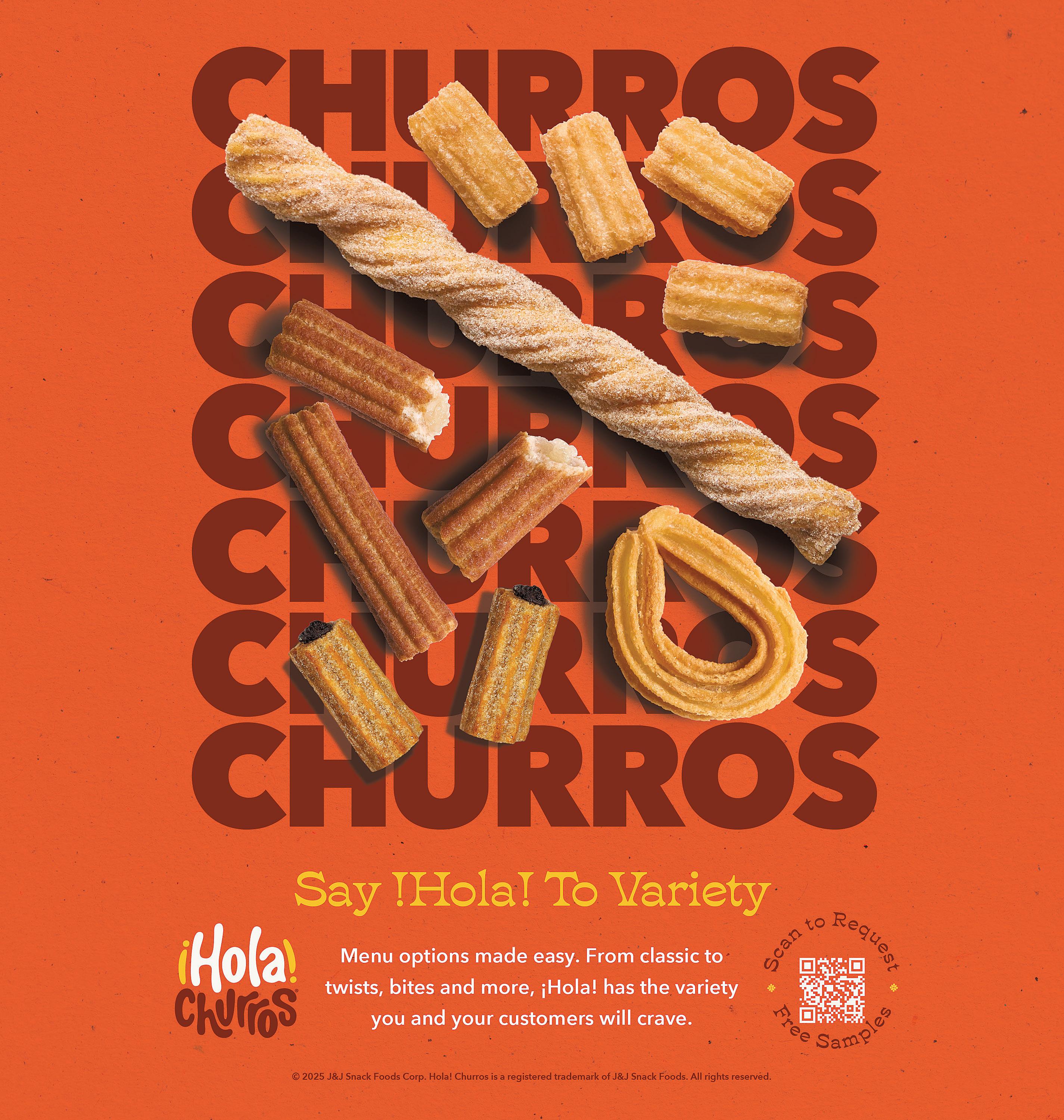
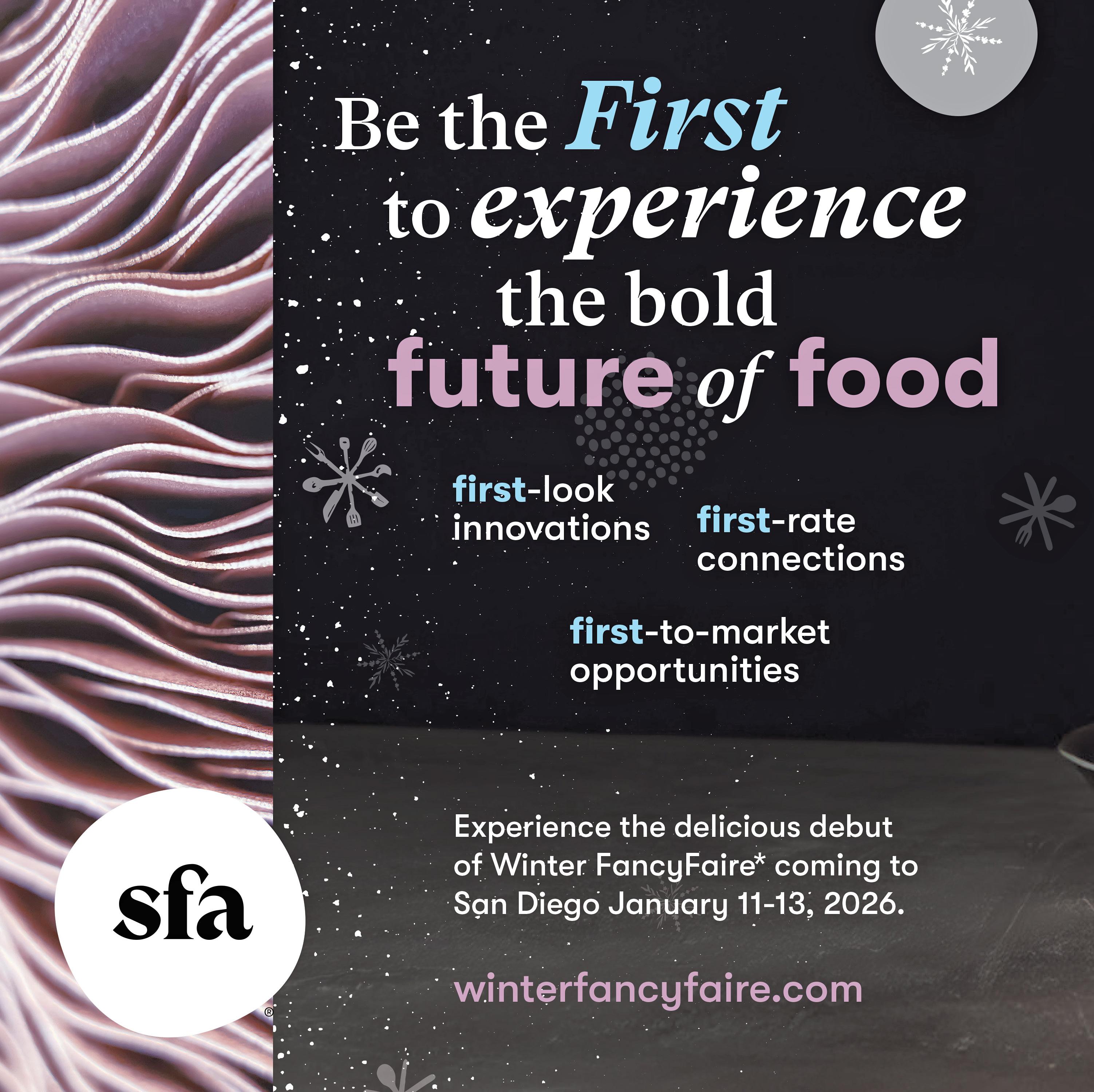


Ihave wonderful childhood memories of eating a delicious spit-roasted lamb on Easter. In villages like Thermo, the one I grew up in, it was the centerpiece of our Greek Easter feast. Usually, it was a whole roasted lamb that was loaded with spices and then turned on a spit throughout the day. The fragrance was unbelievable. I later learned that this tradition of enjoying lamb was one that both Orthodox and Catholics had in common, an important part of their Easter celebration.
I must add that Lamb is certainly not the only thing that Orthodox and Catholics have in common, as we have a shared religious heritage. What is unique between the two, is that, in years past they haven’t always celebrated Easter on the same day… it’s a rare occurence. But, this year, on Sunday April 20th 2025, Catholics, Christians, and the Orthodox will be celebrating Easter on the same day. So why does this date discrepancy occur between the holidays? It’s because each religion subscribes to a different calendar.
Both Orthodox and Catholic Easter


celebrations share many similarities in the kinds of foods that will be served on a family’s table, and all of the dishes will reflect their common heritage, but in the Orthodox tradition, Mediterranean dietary influences can be seen in everything prepared and consumed.
Depending on family tradition, the centerpiece of any Orthodox Easter celebration usually includes lamb, and alongside that you’ll see everything from a beautiful array of early spring vegetables, Easter eggs, breads, specialty dishes, and holiday desserts made just for that day.
• Magiritsa is an offal soup, full of finely chopped organ meats (from the whole lamb usually roasted on a spit), paired with vibrant spring vegetables and herbs, lots of lemon, and of course, olive oil.
• Lamb is the traditional meat of choice on Easter. Many families still cook a whole lamb roasted throughout the day on a spit, or in the oven stuffed with rice. It’s done very simply, often dressed with salt, pepper, bathed in beer, and flawlessly roasted - the centerpiece of the meal.
• Kokoretsi, an acquired taste, is or-
gan meat wrapped in intestines, then caul fat, and roasted on a spit to crispy perfection. Seasoned with salt, pepper, and dry Greek oregano, served with olive oil and lots of lemon, the Greek Easter table is a prime example of nose to tail cooking.
• Spring vegetables are also part of the Easter table, not only because they are seasonal, healthy to eat, but because they also symbolize spring renewal, and the start of a new life.
• Spanakopita, the famously delectable Greek spinach pie, is a dish often associated with warmth, family, and abundance. It has long been a part of holiday tables throughout Greece for generation, after generation. Made with a savory mix of spinach, feta, and herbs that are folded into layers of crispy phyllo dough, it’s traditionally served up on Easter either as a a side dish or an appetizer.
There are a variety of sweeter treats that those celebrating Easter, whether Orthodox or Catholic, have in common: Hot Cross Buns - If you’ve never tried them before, you don’t know what you’re missing! These sweet and spicy buns

Chef Maria Loi is an entrepreneur, Greek food ambassador and healthy lifestyle guru. The author of more than 36 cookbooks, she is also the host of the award winning PBS series, The Life of Loi: Mediterranean Secrets, now airing its second season on PBS stations nationwide. Both seasons 1 & 2 are available to stream on PBS Passport, Amazon Prime Video, Apple TV, Amazon Freevee, Roku, and Plex TV. The Life of Loi aims to build an inspirational, educational movement around the Mediterranean diet and lifestyle. Loi Food Products, her specialty brand built on traditional ingredients from Greece, includes refrigerated dips, savory pies, pastas, botanical herbs, and olive oil sold on QVC, at Whole Foods Markets, Fresh Direct, and at other retailers. Chef Loi is also the namesake of the acclaimed restaurant, Loi Estiatorio, in the heart of Midtown Manhattan. Connect with her on LinkedIn, follow her on Instagram and Facebook, and learn more about her food philosophy at loiestiatorio.com/chef-loi/.
with the symbol of a cross on top, are often eaten on Good Friday in Catholic, and some Orthodox traditions.
Tsoureki is a traditional Easter bread served in Greece to break the Lenten fast. Tsoureki is a beautifully braided bread, seasoned with ‘Mahlebi’, a Mediterranean seasoning made from cherry pits, with or without red-dyed, hardboiled eggs inserted into the weaving on the top. It’s as delicious, as it is beautiful! Known as Pasha in the Ukraine, and Babka in Poland..this deliciously rich, sweet, egg bread is often filled with raisins, nuts, and my favorite, chocolate. Served as a breakfast treat on Easter morning, Babka is traditionally much sweeter, and sometimes topped with frosting.
Pastiera is an Italian Easter cake, originating in Southern Italy. It’s one of my favorites for the holiday (even though it’s not Greek), and while I’ve enjoyed many versions of this delicacy over the years, my absolute favorite is homemade by
continued on page 60


friend Gennaro’s father, Nicola Pecchia. For the past few years, every Easter, Gennaro and Nicola hand deliver this incredible treat to me at Loi Estiatorio, and I savor every bite. It’s light, creamy, and delicately floral, made with creamy ricotta, wheat berries, eggs, and orange blossom water. Not only is it delicious, but it’s beautiful too, topped with a perfect lattice making it a true show stopper for Easter.
Ever since the first time I was gifted this amazing cake, I told Gennaro and Nicola that it’s a shame that more people can’t taste their Pastiera – they should open a seasonal bakery only for this, so everyone in New York (at least!) can enjoy!
And Don’t Forget the Eggs..
Eggs are very symbolic in the springtime, throughout all the major religions. Greeks, along with many other cultures, have looked at these eggs as a symbol of fertility, and rebirth
In Christian religions, eggs are dyed bright, happy shades to evoke spring feelings – though the original meaning was to symbolize the tomb from which Jesus arose. In Greek culture, Easter Eggs are serious business! There are a number of stories for why the eggs are dyed red, but the one I like the most has it that an unknown woman, who wouldn’t believe the news of Christ’s resurrection, said that she would believe it only when the eggs she had been holding turned red; miraculously, the eggs changed as soon as she spoke the words.
In the Orthodox tradition, the eggs are usually dyed a very deep red on the Thursday before Easter. This particular Thursday is called Red Thursday, or Kokkini Pempti. Nothing is done on Good
Friday as a sign of respect; everyone fasts on Holy Saturday, and Sunday is a celebration of his divine nature and of the true arrival of spring!
We also play a fun game called tsougrisma (which means ‘clinking together’ or ‘clashing’) and it involves two players and red eggs.
• Each player holds a red egg, and one taps the end of her/his egg lightly against the end of the other player’s egg. The goal is to crack the opponent’s egg. When one end is cracked, the winner uses the same end of her/his egg to try to crack the other end of the opponent’s egg.
• The player who successfully cracks the eggs of the other players is declared the winner and, it is said, will have good luck during the year.
Wine is an integral part of both Catholic and Orthodox Easter celebrations. Throughout time many different wines have been part of the holiday table.
I personally think one of the nicer pairings with lamb, is a lovely grape known as Agiorgitiko (also known as the St. George varietal), which originated in ancient Greece, and is still grown across the country today. It’s a full-bodied wine with lots of spice that matches nicely with the lamb’s seasonings.
A sweet dessert wine is also frequently served, and a festive part of an Easter feast as well. A fortified wine like Muscat of Samos is one of the more popular choices, and loved by wine enthusiasts. The grapes come from the semi-mountainous zones of Samos, and it pairs nicely with desserts, as well as the traditional tsoureki bread.
Happy Easter, or Καλό Πάσχα (Kalo Pascha) in Greek! No matter how you commemorate Easter, remember that this is an ode to spring, and a time to celebrate the rebirth and renewal that happens all around the world as it reawakens after the winter.
All photo credits are Chef Loi


One of the most important trends in restaurant and foodservice today is the transition to electric cooking. As sustainability regulations evolve and energy efficiency becomes a greater priority, operators and the equipment dealers and consultants who support them must carefully vet new electric cooking equipment. Performance, reliability, and ease of use are critical factors to consider. The right electric equipment should match an operator’s cooking needs, maintain consistency under high volumes, and improve efficiency while reducing training time for staff. The shift toward electric is not just about meeting regulations but also about finding practical solutions to operational challenges. Wood Stone has been at the forefront of this movement, taking a customerfirst approach in developing electric solutions. The company started with solid fuel ovens, expanded into gas, and is now innovating in electric cooking to meet growing demand. According to Chris Trout, President and Chief Executive Officer of Wood Stone, the company’s success has always been rooted in listening to the market. “We’ve always developed and innovated based on customer needs. We’re not just making electric versions of our gas ovens. We’re engineering electric ovens that meet the specific challenges operators face today.”
A major factor driving the shift toward electric is utility access. In certain areas, new gas installations are becoming more difficult due to regulations, while other locations favor electric for efficiency and flexibility. The
ability to install electric ovens without the complexities of gas lines and ventilation requirements provides a strong business case for the transition. Wood Stone recognized these trends and developed the Electric OneRev Labor Saver Rotating Pizza Oven, a piece of equipment designed to streamline operations while maintaining high-quality pizza output.
The Electric OneRev is designed to reduce labor dependency while delivering consistent results. Unlike traditional pizza ovens that require an experienced operator to rotate and monitor pies, the OneRev automates the process with a single rotation. According to Trout, “The OneRev eliminates the need for an operator to ‘chef’ the pizza. You load it, let it do one full rotation, and take it out— perfectly cooked, every time.”
This new electric oven offers a rotating cooking surface that ensures even baking with zero recovery time, meaning pizzas can be continuously loaded without any impact on performance.
“We’re not just making electric versions of our gas ovens. We’re engineering electric ovens that meet the specific challenges operators face today.” — Chris Trout, Wood Stone
The oven’s dynamic thermal management system, along with responsive top and bottom heating elements, creates an efficient heat-on-demand environment.
The OneRev is also highly versatile, allowing multiple pizza sizes and toppings to cook on a single setting, reducing the need for operator adjustments. Its ease of use minimizes training time and ensures consistent quality. Unlike larger traditional ovens that could require renovations for installation, the Electric OneRev is compact, fits through a 72inch doorway, and comes on wheels for easier transport and setup.
For restaurant operators, switching from gas to electric ovens often raises concerns about throughput, performance, and energy efficiency. Wood Stone addressed these challenges by designing the Electric OneRev to match the cooking performance of its gas counterpart. “The throughput and cooking performance of the electric version is the same as the gas version,” Trout explained. “That was a top priority during development.”

Additionally, electric ovens often lead to long-term savings by reducing ventilation requirements, lowering fuel costs, and minimizing labor and food waste.
The Electric OneRev is designed for high-volume pizzerias looking to balance
artisanal pizza quality with operational efficiency. It appeals to both independent operators and restaurant chains that need to maintain consistency while simplifying kitchen operations. As pizza continues to expand beyond its traditional Italian roots into a variety of cuisines and formats, the demand for efficient, high-performing equipment grows. “Pizza isn’t just Italian anymore—it’s a global phenomenon,” said Trout. “This oven is built for anyone who wants to serve incredible pizza without the complications of traditional ovens.” Wood Stone continues to innovate by staying close to the needs of the market. As electric cooking gains traction, the company remains committed to offering both electric and gas solutions, ensuring operators have the best equipment to meet their specific needs. “Electric isn’t going to take the world over overnight,” Trout concluded. “Gas is still going to be here, and solid fuel as well. Our job is to pay attention to our customers and continue developing solutions based on their needs.”
For foodservice operators, consultants, and dealers interested in adding the Electric OneRev or other Wood Stone ovens to their portfolio, Wood Stone provides comprehensive support and consultation.
To explore the full lineup of Wood Stone’s electric and gas pizza ovens, visit their website (woodstone-corp.com) or contact their team directly.

The evolving industry landscape set the stage for NAFEM 2025, where thousands of attendees converged on Atlanta to explore cutting-edge foodservice equipment and supplies that cater to modern industry demands. Deirdre Flynn, executive vice president of the North American Association of Food Equipment Manufacturers (NAFEM), noted that the biennial show has never been more relevant. “With ongoing labor shortages, the recovery from supply chain disruptions, and tariff concerns, the equipment and supplies industry is stepping up with innovative solutions,” she said.
NAFEM ’25 focused on how restaurant and foodservice operators are increasingly turning to automation, smart technology, and sustainability-focused solutions to keep their businesses running efficiently.
Operators and the dealers and consultants that support them came looking to reduce reliance on manual labor found solutions in robotic kitchen assistants, automated fryers, and connected equipment with real-time monitoring capabilities—all designed to streamline backof-house operations while maintaining food quality.
The NAFEM Show is known for showcasing the latest in foodservice technology, and this year was no different.
The demand for connected kitchen equipment has surged, with manufacturers unveiling AI-powered ovens, induction cooktops, and automated fryers that optimize cooking times, reduce food waste, and improve energy efficiency. Many of these systems are now cloudintegrated, allowing remote monitoring and predictive maintenance to minimize downtime. “Smart kitchens are becoming the new norm, with technology
continued on page 66

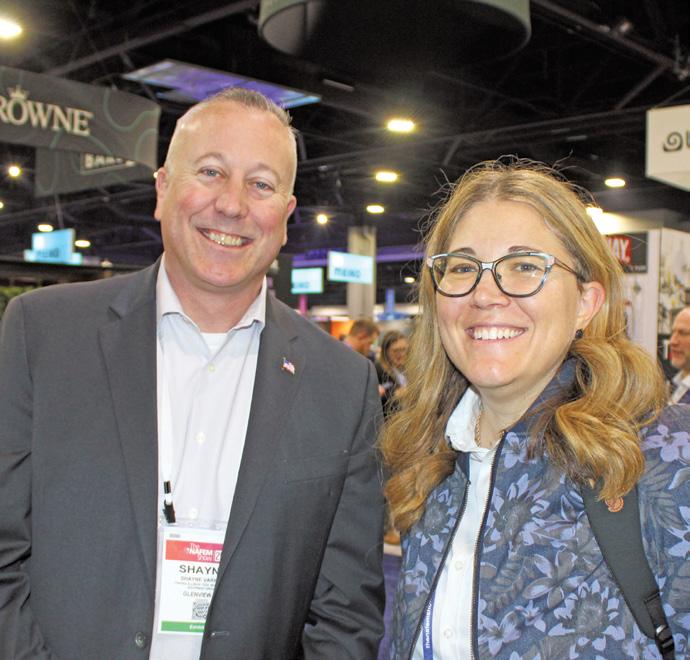



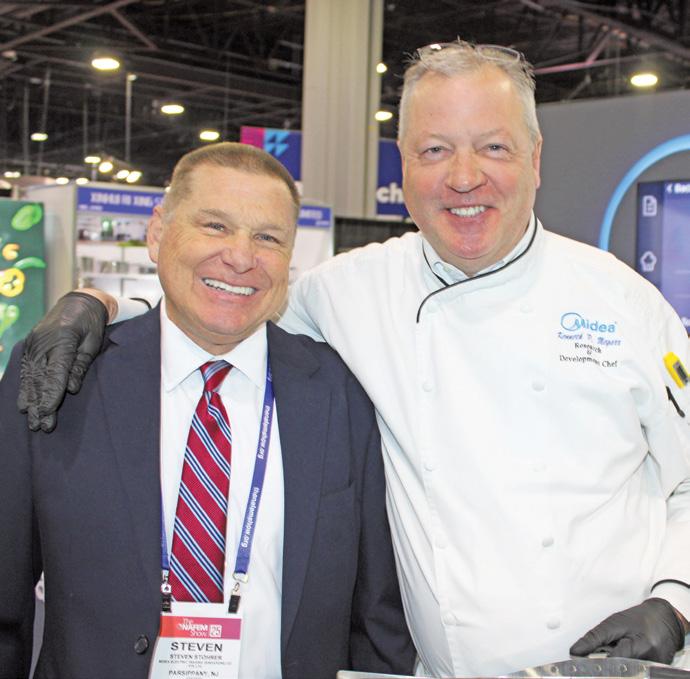


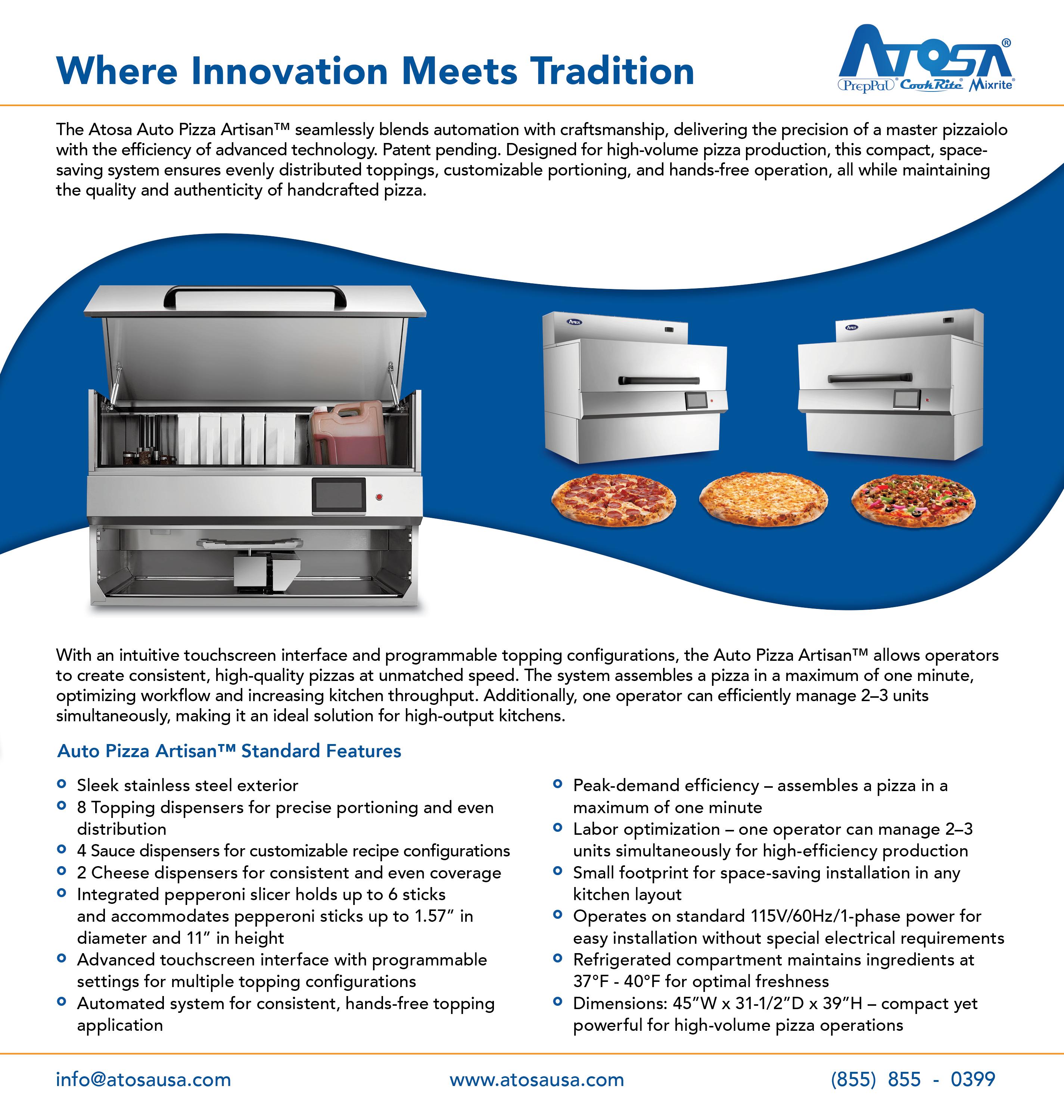
from page 64
that helps operators do more with less,” added Steve Spittle of Middelby and the current NAFEM president.
For some showgoers, the primary goal was to find compliance solutions that align with these new regulations. With new environmental regulations coming into effect, exhibitors showcased ice machines and refrigeration units that use eco-friendly refrigerants like R-290 and HFOs to comply with upcoming EPA mandates. The transition from high Global Warming Potential (GWP) refrigerants like R-404A to lower-GWP alternatives is now a critical concern, as the EPA has mandated that self-contained commercial ice machines with refrigerant charge capacities of 500 grams or lower must use refrigerants with a GWP of 150 or less by the beginning of this year.
Manufacturers like Manitowoc and Hoshizaki showcased models designed to meet these new standards, offering energy-efficient and environmentally friendly alternatives for operators looking to stay ahead of regulatory changes. Additionally, intelligent refrigeration systems that track temperature fluctuations and notify operators of potential issues were a hot topic.
Manitowoc debuted its Indigo NXT ice machines, which use next-generation diagnostics and energy-efficient components to reduce water and power consumption. Hoshizaki showcased its Sphere Ice Machine, catering to the growing craft cocktail trend by producing crystal-clear spherical ice.
Attendees experienced a packed agenda with product showcases, hands-on demos, and networking opportunities. The WHAT’S HOT! WHAT’S COOL! product gallery returned, featuring next-generation kitchen equipment, including AI-driven cooking systems, robotic assistants, and compact, multi-functional appliances designed for smaller kitchens.
For the first time, the NAFEM Show hosted the U.S. Culinary Open, a prestigious cooking competition where 12 chefs competed in a high-energy showdown on the show floor. The event highlighted cutting-edge cooking equipment while celebrating culinary excellence.
continued on page 68





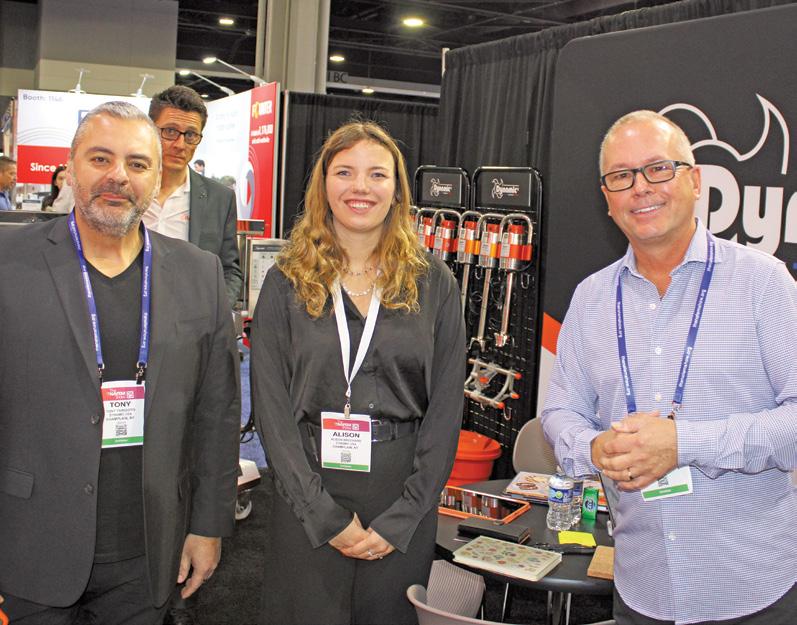








For operators looking to stay ahead, NAFEM provided a real-world testing ground for the latest innovations. Attendees can engage with engineers, designers, and sales reps to learn how cutting-edge technology can be integrated into their kitchens. The show has long been known for catering to the needs of the nation’s dealers and consultants. NAFEM introduced dedicated morning training hours for foodservice equipment dealers, allowing them to engage in one-on-one demonstrations with manufacturers before the show floor opened to operators from across the globe.
Automation took centerstage. Robotic arms were a standout at the show, with companies like Middleby Robotics and Atosa showcasing cutting-edge automation solutions. Middleby Productive Robotics introduced its pizza-making robot, designed to automate the doughstretching, sauce-spreading, and topping application process with precision.
Atosa’s fry-making robot also caught attention, acting as a co-bot that senses the weight of fries, lowers the basket into the fryer, and removes it after the exact cooking time, reducing labor needs while ensuring consistency. These robotic assistants highlight the growing role of automation in commercial kitchens, allowing operators to optimize labor while maintaining food quality.
Manufacturers such as Rational, AltoShaam, and Convotherm showcased their latest mini-combi models, emphasizing energy efficiency, rapid cooking capabilities, and intuitive touchscreen controls., ‘Mini-combis are giving operators a powerful tool to maximize efficiency without sacrificing quality, making them a must-have for kitchens looking to do more with less.’ Middleby Corporation introduced the new TurboChef Plexor, a high-speed ventless oven that offers multiple cooking technologies in a single footprint, ideal for quickservice and fast-casual restaurants. Rational continues to show the way with presented its iHexagon and iCombi Pro, an intelligent combi oven that adjusts cooking settings in real-time based on load size and food type. Electrolux Professional highlighted its new electric chargrill, a gas-free alternative for highperformance grilling.
The show once again did a brilliant job of helping the industry set the table. Tabletop offerings included earthy tones, natural finishes, and sustainable materials in tabletop presentations. Bold colors and playful patterns are also making a comeback, moving away from the monotones and neutral tones that have dominated in previous years. Tabletop offerings from companies like Steelite showcased this trend, with vibrant dinnerware collections featuring striking hues and intricate designs.
Dinnerware trends in 2025 are focusing on not just aesthetics but also sustainability and functionality. Operators are looking for ways to enhance presentation while aligning with consumer expectations for sustainability. Recycled glassware, bamboo fiber plates, and hand-crafted ceramic dishware emerged as some of the top trends. Trending hues include deep emerald greens, earthy terracotta browns, crisp lacier whites, and modern geometric patterns, as well as deep blues and golden yellows.
Another growing trend in dinnerware is the increasing popularity of matte and textured finishes, which bring an organic and modern feel to tabletop presentations. Soft-touch matte glazes, speckled or rough-textured ceramics, and brushed or sanded surfaces were showcased by several exhibitors, highlighting the shift toward unique, tactile dinnerware that enhances both aesthetics and functionality. These vibrant colors and striking patterns are helping restaurants create more engaging and visually stunning tablescapes, making dishes more ‘Instagrammable’ and enhancing the overall dining experience.
Eco-friendly materials are having their moment, with many manufacturers turning broken ceramics and glass into entirely new dishes. Bamboo fiber plates are gaining traction for their lightweight, chemical-free properties, making them both sustainable and visually appealing. Additionally, natural stoneware has seen a resurgence, offering durability and an artisanal aesthetic. “Operators are looking for ways to enhance presentation while aligning with consumer expectations for sustainability,” Flynn noted.
Some of the industry’s biggest manu-
continued on page 70









facturers brought their latest innovations to the show floor. With the cost of food skyrocketing, the battle for bar profits is being led by innovators like Perlick and Krowne. These companies are revolutionizing beverage service with advanced bar equipment designed to maximize efficiency and profitability. Perlick showcased its new retro branding and latest underbar refrigeration systems with rapid cooling technology, ensuring beverages remain at optimal serving temperatures while minimizing energy consumption. Krowne’s spectacular booth introduced its automated draft beer dispensing systems, which reduce waste and improve pour consistency, ultimately increasing profit margins for operators.
The Flynn/Spittle leadership team covered all of the bases including solutions to how to prep plant-based menu items. Plant-based eating isn’t just a trend anymore; it’s a lifestyle shift that’s here to stay. While veganism once represented a niche market, today’s plantbased offerings attract flexitarians, health enthusiasts, and environmentally conscious diners. To execute a highquality plant-based menu, operators found the right equipment at NAFEM ‘25. Vegetable peelers, spiralizers, and mandolines are essential for preparing fresh produce efficiently. Additionally, steamers and convection ovens allow chefs to cook vegetables evenly while preserving their nutritional value.
Exhibitors like Rational and AltoShaam showcased their latest self-adjusting combi ovens, designed to automate cooking processes and reduce staff workload, while companies such as Middleby Corporation and Electrolux Professional highlighted high-efficiency appliances that lower operational costs. As labor shortages persist, manufacturers are focusing on kitchen technology that reduces reliance on skilled labor while ensuring consistency in food preparation. Automated cooking systems, self-cleaning fryers, and robotic kitchen assistants were major highlights, helping operators streamline workflows and reduce operating costs. The emphasis on sustainability was reflected in energy-efficient refrigeration, water-saving dishwashers, and compostable foodservice packaging. Many exhibitors show-
cased AI-driven systems that predict maintenance needs, reducing downtime and prolonging equipment life.
NAFEM 2025 also demonstrated the role of data in foodservice, with smart equipment that collects real-time analytics on food waste, energy consumption, and inventory levels. AI is becoming an integral part of commercial kitchen operations, with predictive maintenance technology monitoring equipment health and anticipating potential issues, reducing downtime and extending the lifespan of investments. These AI-driven systems help operators proactively schedule maintenance, avoid costly breakdowns, and ensure equipment runs at peak efficiency.
As AI continues to evolve, its integration into foodservice technology is streamlining operations and enhancing overall kitchen management. These analytics provide actionable insights that allow operators to adjust portion sizes, optimize ingredient ordering, and identify inefficiencies in energy usage. By leveraging this data, restaurants can cut costs, reduce waste, and improve overall kitchen performance in real time. This technology enables operators to optimize their operations, reduce expenses, and improve overall efficiency. Cloudbased solutions were heavily featured, allowing restaurant owners to monitor their kitchens remotely, adjust cooking settings, and receive alerts for equipment issues before they become costly repairs.
One of the most anticipated special events was NAFEM’s private takeover of Mercedes-Benz Stadium for a night of networking and entertainment. The event featured a performance by OneRepublic, exclusive stadium tours, and interactive food experiences. “This was a first-of-its-kind event for us, and we wanted to create something truly memorable for our attendees,” Flynn concluded.
There was no shortage of “party time”. Hatco hosted a 75th-anniversary celebration with a James Bond ‘Diamonds Are Forever’ theme at the historic Tabernacle in Atlanta, offering attendees a night of entertainment, networking, and industry camaraderie.
NAFEM’s @CenterStage hosted live panels and recorded sessions on food
safety, automation, and the economic outlook for the foodservice industry. A key session featured ITR Economics’ Connor Lokar, who discussed market trends and what operators should expect in 2025.
NAFEM also took the opportunity to recognize outstanding contributions to the industry through the prestigious William W. Carpenter Award and the Louise O’Sullivan Award of Excellence. This year, the William W. Carpenter Award was presented to Rob Connelly, CFSP, executive chairman of Henny Penny Corporation, in recognition of his extensive leadership and impact on foodservice equipment innovation. Mike Whiteley, retired executive vice president of sales and marketing at Hatco Corporation, was honored with the Louise O’Sullivan Award of Excellence for his dedication to the association and the industry at large.
NAFEM has already set its sights on 2027. The next edition will return to Orlando, with expanded educational tracks and a focus on AI-driven solutions, automation, and robotics. The association also announced plans to bring the show back to Atlanta in 2029, solidifying its commitment to providing a premier industry event in a growing foodservice hub.
As NAFEM 2025 demonstrated, the industry is evolving rapidly, and those who embrace technology, sustainability, and automation with an on-going commitment to traditional hospitality (knowing a repeat customer’s name) will be best positioned to succeed in the years ahead.






As the reality of the Trump administration’s threat to deport undocumented immigrants en masse continues to take shape, hospitality businesses remain prime targets for a visit from U.S. Immigration and Customs Enforcement (“ICE”) agents looking to inspect the business’s I-9 forms and search for undocumented immigrants. It is imperative that hospitality employers be prepared for these visits to protect both the business and its employees - and the best time to do so is before ICE agents make their way through your front door (or your loading dock or back door or side door).
Hospitality employers should conduct an I-9 self-audit to ensure the business has a complete and correct I-9 for each current employee and those former employees whose I-9s the employer is required to keep. Hospitality employers
Hospitality businesses remain prime targets for a visit from U.S. Immigration and Customs Enforcement (“ICE”) agents looking to inspect the business’s I-9 forms and search for undocumented immigrants.
should also train managers to respond appropriately if ICE does make a surprise visit.
The purpose of the I-9 form is to demonstrate that an employer has verified both the employee’s identity and authorization to work in the United States.
Employers must ensure that all parts of the Form I-9 are properly completed, as the employer may face penalties and fines if the form is not completed or is completed incorrectly. The form looks

simple enough, but is nonetheless prone to errors. An I-9 self-audit - conducted by the business or by legal counsel - allows employers to identify any areas of non-compliance and make corrections as needed.
In conducting a self-audit, common I-9 errors to look for include that the:
• Employer or the employee listed information in the wrong box
• Employee did not fill out Section 1 completely, or at all
• Employer accepted unacceptable documents or Section 2 is incomplete
• Employee’s work authorization document has expired and the I-9 has not been updated
• Form is unsigned or undated
If errors or omissions are identified, the employer should correct the I-9 in accordance with U.S. Citizenship and Immigration Services (“USCIS”) guidance, available at https:// www.uscis.gov/i-9-central. As the determination of whether a correction is required and the procedure for correction can be complex, consultation with legal counsel is recommended.
Even if your I-9s are in order, and even if none of your employees are

Valerie Bluth is a Partner in the Labor & Employment Group at Ellenoff Grossman & Schole LLP. For more than fifteen years, Ms. Bluth has exclusively represented and advised clients in employment-related matters, with a particular focus in the hospitality industry. Above all, Ms. Bluth works tirelessly to ensure clients are in compliance with an everchanging landscape of federal, state and local employment laws, especially with respect to pay practices, employment policies, and leave and accommodation management, and to devise practical solutions for any employment problems that might arise. Ms. Bluth can be reached at (212) 370-1300 or vbluth@egsllp. com.
undocumented immigrants, there is still a distinct possibility that ICE agents will come knocking. Beyond ensuring I-9 compliance, a suggested preventative step is to put up signs denying access to private areas, such as those saying “no trespassing,” “private” or “employees only.” But, doing so is not a silver bullet and you should still prepare managers and employees for a visit from ICE.
ICE agents show up at a business either with no warrant, an administrative warrant or judicial warrant. The obligation to let the agent into your premises (or to stay on your premises if they have already entered the premises) depends entirely on whether the agent presents a warrant and, if so, what kind.
The first thing a manager should ask if an ICE agent appears is "do you have a warrant?” If the agent says yes, the manager should ask what kind of warrant it is and also to see the warrant. Non-management employees should be instructed to refer an ICE agent to a manager, and not to talk to the agent themselves.
Only a judicial warrant, which will say “United States District Court” at the top and is signed by a federal judge, allows ICE agents to enter and search the premises (including non-public areas), seize documents or property, and arrest any
continued on page 96


Little League baseball is more than just a sport—it’s a community gathering place where families, friends, and players come together to enjoy America’s favorite pastime. One key element that enhances this experience is the concession stand. A well-run foodservice program can provide delicious, crowd-pleasing food while also serving as a critical revenue stream for the league. A great concession stand is more than just a place to grab a snack; it plays a vital role in fostering a fun and engaging environment.
To maximize a concession stand's benefits, a strong foodservice program focusing on quality, efficiency, and profitability is essential. One of the best ways to ensure success is by investing in reliable, ventless kitchen equipment like AutoFry.
A well-executed foodservice program offers numerous benefits, including:
• Revenue Generation: Concession sales often serve as a top funding source for Little League programs, covering field maintenance, equipment, uniforms, and tournament fees.
• Enhanced Game-Day Experience: Tasty and convenient food keeps families engaged at the ballpark longer, ensuring they stay to support their teams. Having a wide variety of snacks and meal options ensures everyone finds something they enjoy.
• Community Engagement: The concession stand serves as a social hub where families and friends gather, enhancing the sense of community and making game days more enjoyable.
• Player Satisfaction: After a long game or practice, players are hungry. A variety of food options ensures they can refuel and enjoy their time at the field, helping to keep energy levels high and
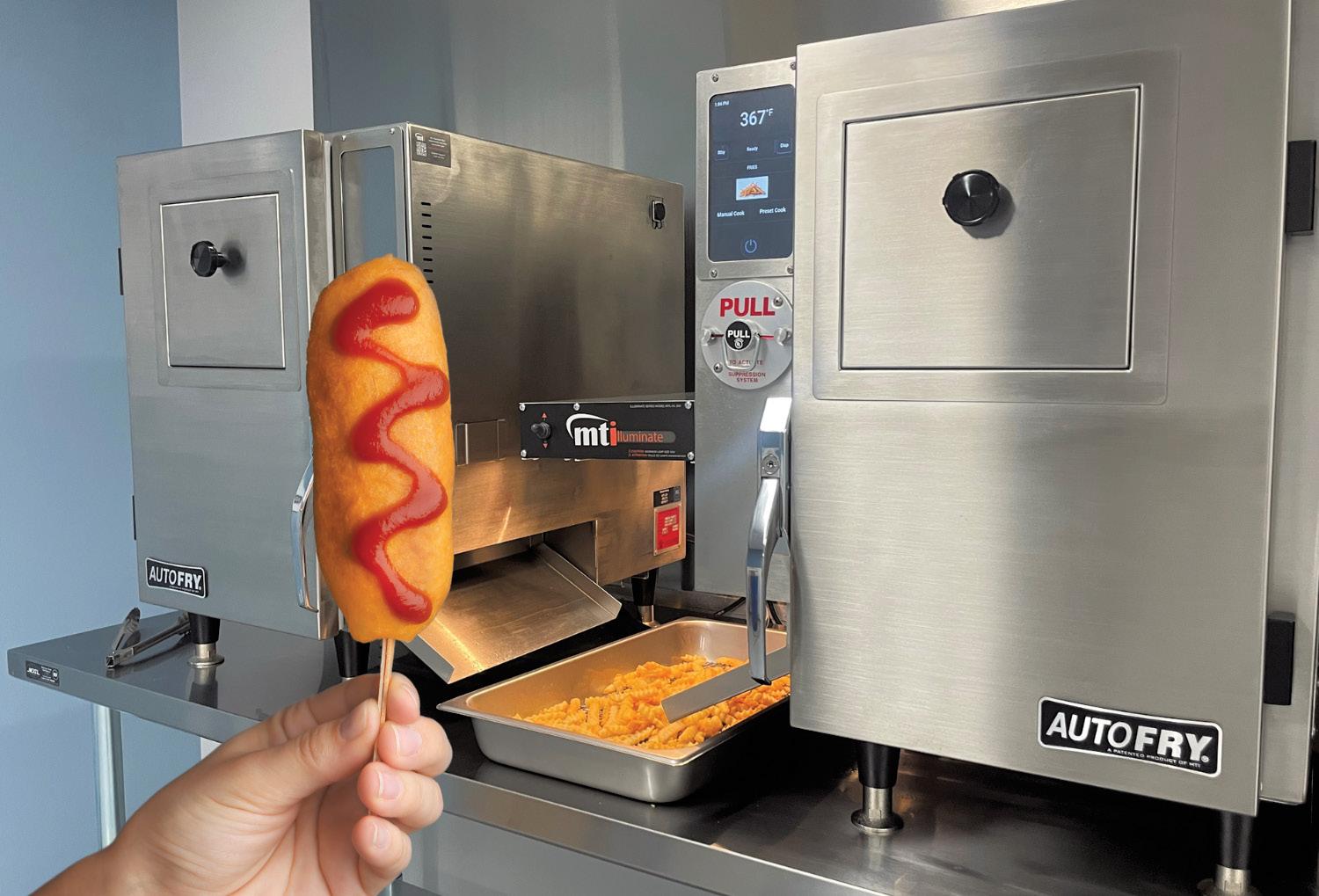

spirits even higher.
Key Components of a Successful Concession Stand
To run a successful stand, focus on:
• Menu Variety: Offer a mix of fan favorites like corndogs, chicken sandwiches, fries, mozzarella sticks, and even churro bites.
• Efficiency and Speed: Families want quick service, so they don’t miss the action. Streamlined equipment and a well-organized setup are essential.
• Food Safety and Consistency: Using the right equipment ensures food is cooked to perfection every time, reducing waste and ensuring customer satisfaction.
• Cost Control: Keeping food costs manageable while maintaining high quality is key to profitability. Reliable, low-maintenance kitchen equipment helps control expenses.
continued on page 98
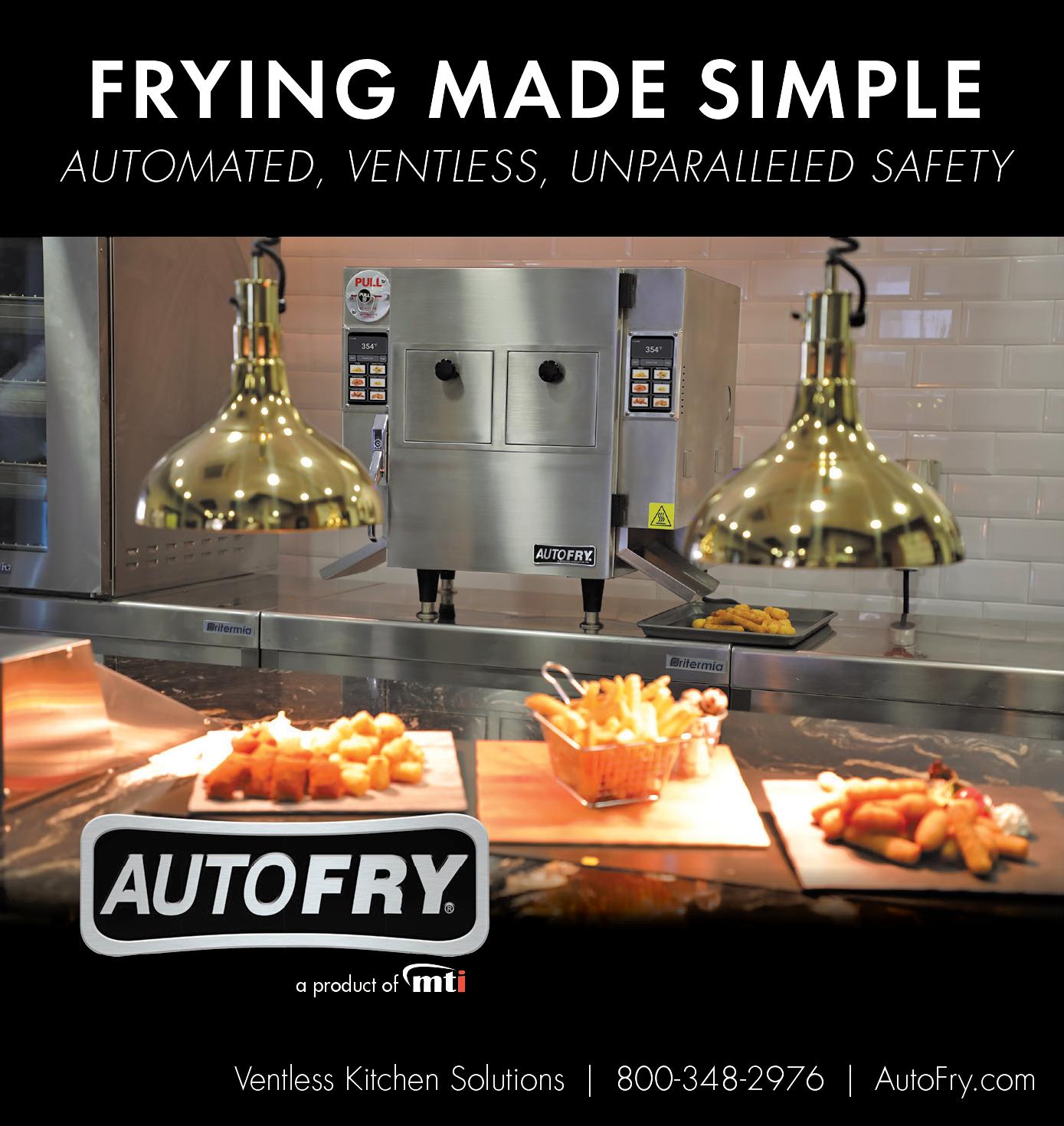


In the high-stakes, high-talent world of San Diego dining, it takes more than skill to survive. It takes vision, consistency, and partnerships that elevate every ingredient. Just ask Chef JoJo Ruiz, Executive Chef and Partner at Lionfish, one of the city’s most talkedabout modern seafood destinations.
But long before Ruiz was making headlines for his sustainable sourcing and bold flavors, he was just a kid in school who stumbled into the restaurant world by accident. “I was offered a dishwashing job at a sushi bar owned by my dad’s friend,” said Ruiz. “Eventually, I worked my way up and fell in love with the kitchen. That’s when I knew I had to go to culinary school and learn from the best.”
That “honest mistake,” as he calls it, sparked a relentless passion for craft, precision, and the power of a well-composed plate. Ruiz trained under toptier chefs, absorbing techniques and philosophies that would later inform his own leadership style and culinary ethos.
Lionfish, located in the vibrant Pendry San Diego hotel in the Gaslamp Quarter, isn’t just a restaurant— it’s a representation of JoJo Ruiz’s identity as a San Diego native and a culinary visionary. Since opening in 2017 with hospitality group Clique Hospitality, Lionfish has drawn acclaim for its seasonal, sustainable, and technique-driven menu. The kitchen at Lionfish is a laboratory of flavor experimentation and sustainable
“I realized my passion was in the kitchen from the moment I picked up a sushi knife. From that point, there was no turning back.” — Chef JoJo Ruiz
practices. “We wanted to create a modern coastal cuisine that represents the flavors of San Diego while keeping sustainability at the core,” Ruiz said. “It’s about letting the ingredients speak and doing them justice.”
One signature dish that keeps guests coming back is the Grilled Octopus with Sumac-Marinated Onions and Castelvetrano Olive Red Chimichurri—a plate
that’s as vibrant as the city it was born in. “That octopus dish really represents who we are. Bold, fresh, global but grounded in Southern California,” Ruiz noted.
Another standout is the Blue Cobia Portions, responsibly sourced and featured with minimalist garnishes that allow the buttery texture and clean flavor to shine. Then there’s his masterful use of White Verjus in vinaigrettes and finishing sauces, which bring acidity without overpowering delicate seafood. Whether it’s sushi, shared plates, or carefully composed entrées, the menu strikes a balance between accessibility and creativity—one reason Lionfish remains a hot ticket in a crowded scene.

Great chefs need great ingredients. And in JoJo’s world, that means The Chefs’ Warehouse—a partner he’s trusted for more than a decade. “I’ve used Chefs’ Warehouse for about ten years. From day one, the service, variety, and quality of products made me a loyal fan,” Ruiz explained.
That loyalty is more than just a supply chain—it’s a relationship built on trust,
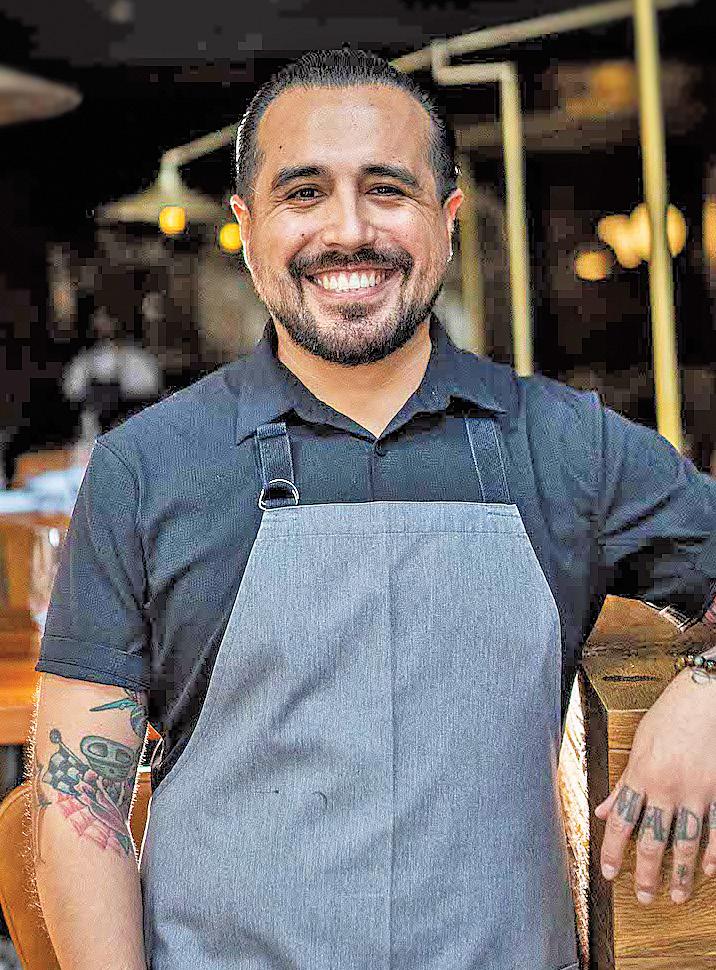
flexibility, and shared commitment to excellence. JoJo emphasized the importance of having distributors who understand a chef’s evolving needs. “My reps have become friends. They know the kind of product I want before I even ask for it. That’s rare,” he said. “When we’re building or tweaking a menu, I can rely on them to get the hard-to-find stuff that gives our dishes that unique edge.”
It’s not just about ingredients. It’s about communication. As menus evolve with seasons and trends, having a distributor who can pivot quickly with you is crucial in staying competitive. “When I needed a specialty product to finish a dish, they got it to me fast. That speed and support lets me push boundaries,” said Ruiz.
The synergy between Ruiz and Chefs’ Warehouse is clear in the plates he puts out, particularly the curated selection
continued on page 102
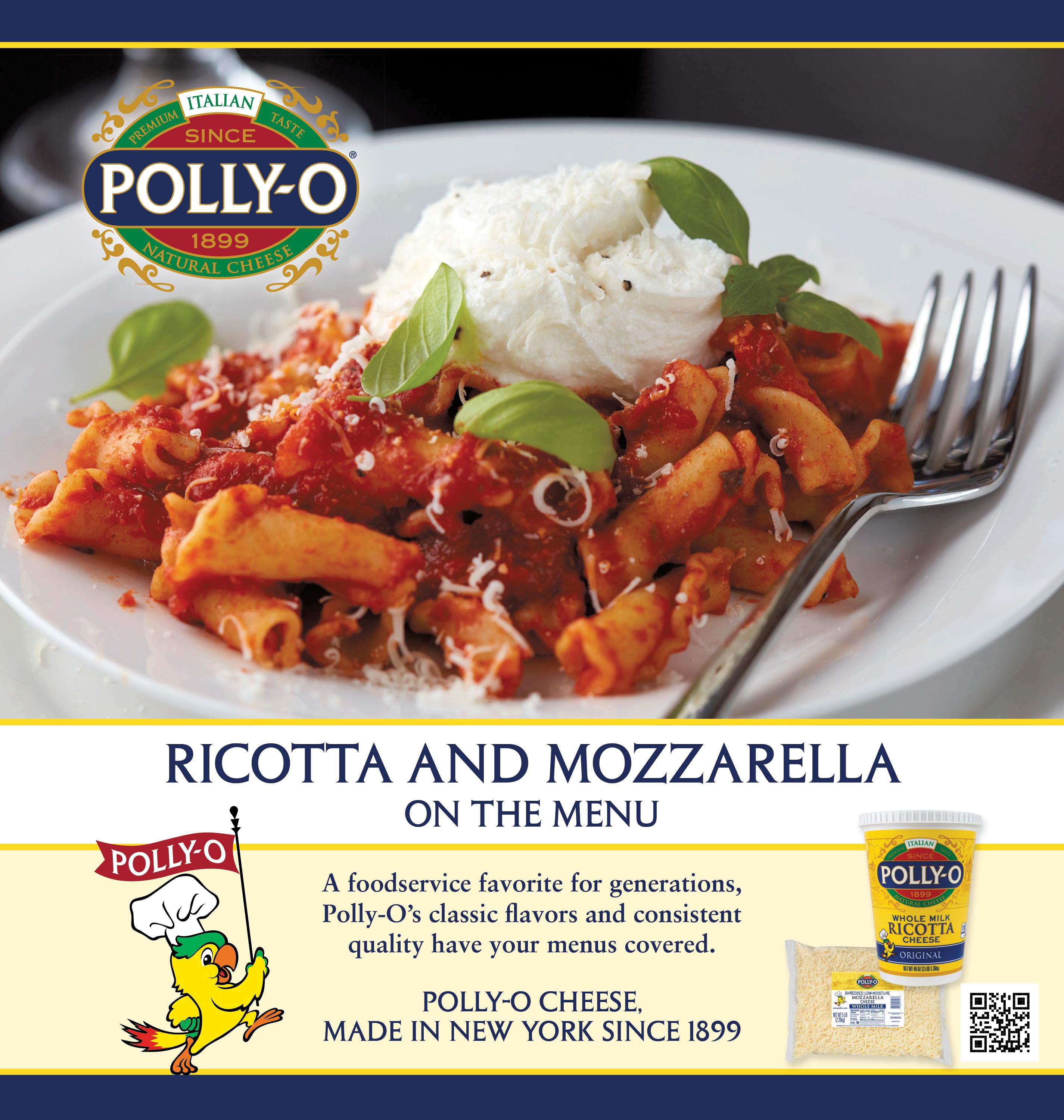
Article by Joyce Appelman
The Specialty Food Association (SFA) Trendspotter Panel navigated thousands of specialty food products showcased by nearly 1,100 exhibitors from in January at the Las Vegas Convention Center. Guided by the SFA’s 2025 Trend Predictions, the Trendspotters assembled a diverse collection of products from which seven overall trends have emerged.
“The first Show in the industry’s annual cycle, the Winter Fancy Food Show establishes key emerging trends for the specialty food and beverage market each year. The 12,000 participants who joined us in Las Vegas in January got an exclusive preview of how specialty food makers are responding to shifts in consumer preferences and values,” said Bill Lynch, SFA President. “The Trendspotter Panel came away with exciting findings that range from Instant Global Gratification to the impact of small farms and Hawaii as Terroir. I look forward to seeing how these trends show up across the industry in 2025 and beyond.”
Top Seven Trends, 2025 Winter Fancy Food Show: Established Trends
Girl Dinner 2.0 Snacking remains a strong trend, and the Show featured diverse snacks, including vegan, high protein, functional, luxurious, and crunchy. "Wellness and quick, healthy snack focus will continue to inspire us all,” said Trendspotter Cathy Strange of Whole Foods. “Energy, digestion, sweetness, craving, nutritional impact are key "ingredients" that support each of us elevating the true you.” Said Trendspotter Mikel Cirkus, “It’s the snap, crackle, and pop of snacks gone wild, and the munchie aisle is rising to the occasion in
very creative ways to meet the demand.”
• Amza Superfoods Tibetan Tsamba Balls with Oregon hazelnuts
• A'Smore Macarons in Raspberry Yuzu and Matcha Caramel
• Dixie Grace’s Boiled Peanuts in Original and Spicy
• Oegg Inc. Quail Eggs
• Rise and Sun/Eddy's Homemade Kitchen, Premium Matcha Popcorn
• Kangkong King Salted Egg Kang Kong Chips
• Mizunaga Fisheries Company Marusa Japanese "Shirasu" Oil Sardines
• Date Better 85% dark chocolate covered dates in Cashew Crisp Lime and Hazelnut Praline
• Side Project Jerky Huli Huli Chicken Jerky collaboration with Kiki Aranita
Instant Global Gratification As predicted for 2025, specialty food makers are reacting to consumer cravings for quick and easy meals from around the world. "Life moves fast, and so do today's consumers—but their tastes are more sophisticated than ever,” says Trendspotter Jeannie Houchins. “Specialty food makers are stepping up, offering grab-and-go and quick-prep options that bring bold, authentic flavors from around the world right to their hands."
• Vinker Foods Plant based Crispy Korean Chicken
• Nooish Instant Matzoh Ball Soup
• JFC International Inc. Lotte Samgak Kimbap in Tuna Mayo and Spicy Tuna
• Ottogi Otoki Stir-Fry Cheesy Ramen
• pi00a frozen, handcrafted Asianinspired, and traditional Neapolitan pizzas
• YSS Food Corp. Aahana's gluten free, plant-based meal bowls
• Xinca Pupusas in Loroco and

The Winter Fancy Food Show Trendspotters included Patranya Bhoolsuwan, Emmy Award-winning journalist & founder and CEO, Patranya Media LLC; Mikel Cirkus, Sr. Director, Global Foresight & Design, dsm-firmenich; Jenn de la Vega, chef, stylist, cookbook author, trends expert, Randwiches; Jonathan Deutsch, Ph.D., CHE, CRC, professor and director, Drexel Food Lab, Drexel University; Jeannie Houchins, global communications executive; Sarah Lohman, food historian, and author; Matt Rodbard, Editor in Chief, TASTE; Cathy Strange, Ambassador of Food Culture, Whole Foods; Summer Thompson, Senior Buyer, Market Hall Foods.
Cheese, Zucchini and Cheese, Bean and Cheese.
Yes, Chef "Whether through flavorful marinades like the Zesty Shwarma sauce by Beituti or the flavor hacks from Fine Foods Marketing, home chefs have tons of options to inject their food with exciting flavors. The addition of one of these pantry items to a sheet of roasted vegetables and chickpeas or as a marinade for protein will upscale your dining experience at home,” says Trendspotter Summer Thompson. “One of the most frequent comments I encounter from our customers is "I want my food to taste like a restaurant." These overtly umamipacked items elevate your baseline level of flavor when you're showing off your new techniques in the kitchen. They also take away some of the edge when you are trying out new methods for cooking – faith in the ingredients is the basis of all good recipes.”
• Chelsea Market Baskets/Fine Food Marketing Belazu Shakshuka paste
• Beituti Zesty Shawarma Marinade
• Ferrer Tradicional USA LLC Salsa Brava
• North Country Smokehouse Bacon Crumbles
• Namisato Corporation Organic Roasted Soybean Flour
New Trends from the Show Beverages - Bubbly and Beyond "As a foodie who loves her “bevvies’” I was very excited to see how far the beverage industry has come in offering customers a wide variety of products to fit their tastes,” said Trendspotter Patranya Bhoolsuwan. “I have always veered towards interesting Asian flavors that also provide health benefits, like the Roasted Green Iced Tea by Ito En. And I love seeing more non-alcoholic products that are catering to a growing market of people who are extending their “dry” streak beyond January. I am sure they are celebrating over offerings like the Jøyus NonAlcoholic Cabernet Sauvignon. I love the innovation, and low calories too? It's a continued on page 100
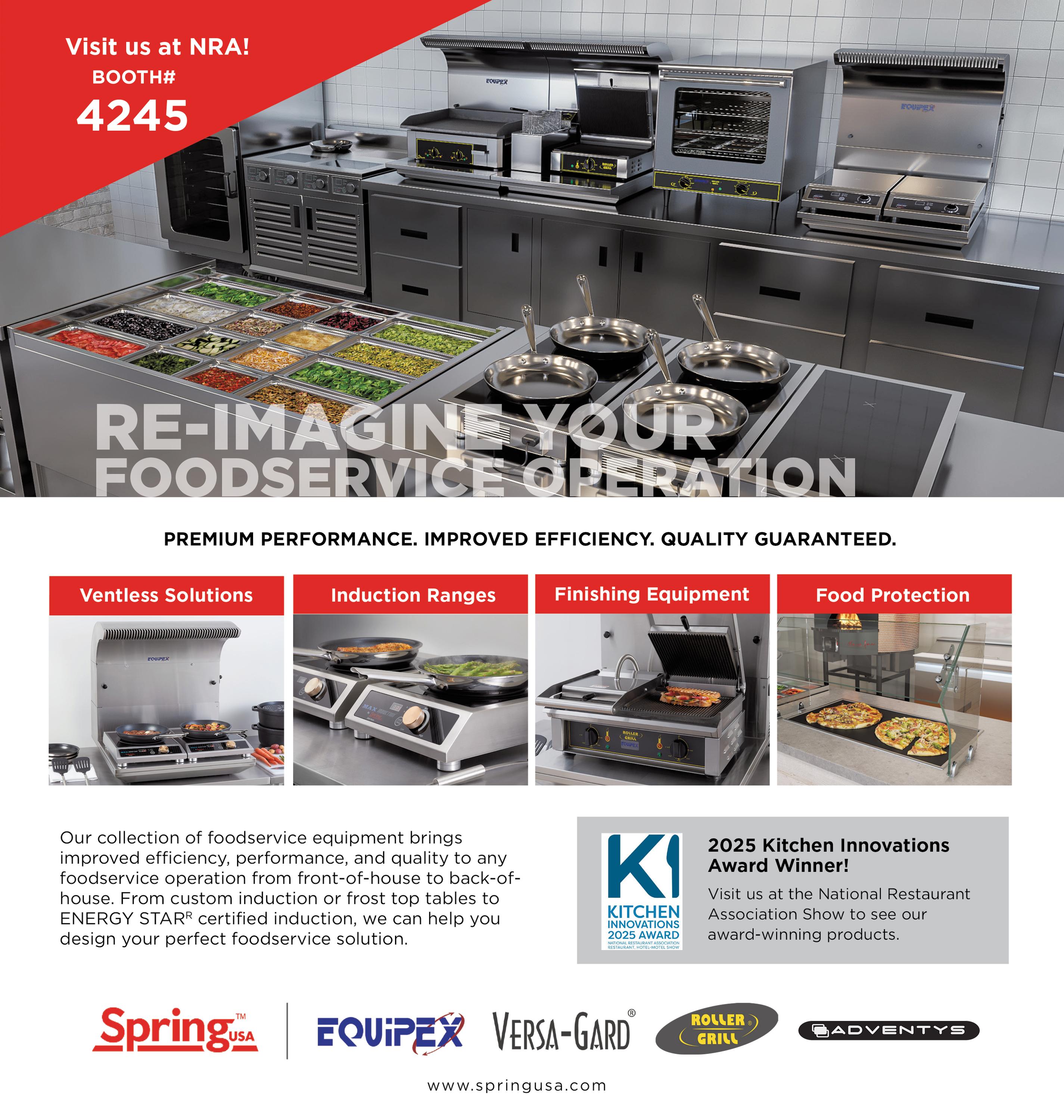
Why donate your profits to your insurance company when you can keep them?
In the restaurant business, every dollar counts. Margins are tight, and smart operators know that cutting unnecessary costs is essential to longterm success. One of the most overlooked areas where restaurant owners lose money is workers’ compensation insurance. The good news is that there’s a proven way to dramatically reduce these costs while improving workplace safety, boosting productivity, and increasing profits.
For more than 30 years, my team at Friedlander Group has helped restaurant owners like you save big on workers’ compensation. Since 1993, we’ve saved New York restaurants a total of $234 million through group discounts and dividends, with an average annual savings of 36%. That’s money that goes right back into your business instead of disappearing into the hands of an insurance company.
The key to lowering workers’ compensation costs is a two-part strategy: creating a culture of safety and joining an insurance program that rewards businesses for prioritizing safety. The United Restaurants Workers’ Compensation Safety Group #556, which we manage, is designed specifically for safety-conscious restaurant owners. Underwritten by the New York State Insurance Fund, it offers guaranteed coverage and returns profits to
Think of it this way: When you and other responsible restaurant owners band together, you collectively lower the risk, and that means lower costs for everyone. Instead of
paying higher premiums to cover riskier businesses, you keep more of your money where it belongs—in your business.
its members through group discounts and annual dividends. This is a powerful advantage over traditional insurance, where you pay your premiums and never see that money again.
Think of it this way: When you and other responsible restaurant owners band together, you collectively lower the risk, and that means lower costs for everyone. Instead of paying higher premiums to cover riskier businesses, you keep more of your money where it belongs—in your business.
At Friedlander Group, we follow a simple but highly effective strategy to help restaurant owners maximize their savings. First, we help you create a culture of safety. Preventing workplace injuries is the most effective way to reduce workers’ compensation costs. We guide our clients in implementing smart safety programs, training staff properly, and following best practices to reduce accidents. Fewer injuries mean fewer claims, which in turn means lower insurance costs.
Second, we make sure you benefit from an exclusive group insurance program. By joining Safety Group #556, you gain access to substantial savings through group discounts and dividends. On average, our members save 36% every year, and those savings add up fast. It’s a game-changer for restaurant owners who want to take control of their expenses.
Finally, our specialized Claims Solutions™ services ensure that if an accident does happen, it doesn’t derail your business. We help you manage claims efficiently, reducing costs and getting employees back to work as quickly as possible. This not only protects your bottom line but also fosters a safer, more productive work environment.
Over the years, we’ve built an exclusive network of more than 800 restaurant owners who are committed to safety and profitability. These business owners understand that

Chuck Sullivan is a trusted expert in workers' compensation insurance and safety solutions, specializing in helping businesses lower costs and improve workplace safety. As a key member of Friedlander Group, Chuck has helped countless clients save millions in workers’ compensation discounts and dividends through strategic risk management and claims oversight. With deep industry knowledge, Chuck works closely with businesses to navigate complex insurance challenges, ensuring they maximize savings while maintaining the highest safety standards. His expertise spans multiple industries, with a strong focus on hospitality, retail, and wholesale sectors. When he’s not helping businesses take control of their insurance costs, Chuck enjoys traveling, exploring new restaurants, golfing, and spending time with family and friends. Contact him at chucks@friedlandergroup.com or 914-257-3155
safety is not just about compliance— it’s about protecting employees, reducing costs, and driving long-term success. Since our founding, we’ve saved clients across multiple industries a total of $769 million. That’s money that went back into their businesses, helping them grow instead of being wasted on inflated insurance premiums.
If you’re running a safety-conscious restaurant, why continue overpaying for workers’ compensation insurance? You don’t have to donate your profits to your insurance company anymore. The Friedlander Group has helped thousands of businesses take control of their insurance costs, and we can help you too.
If you’re ready to start saving, I’d love to speak with you. Visit us online at FriedlanderGroup.com to learn more about how much you could be saving. Keeping your profits starts with a simple conversation. Let’s talk.

Galaxy Group, a leading New Jersey-based manufacturer of foodservice equipment, is continuing its momentum with a major expansion of its Northeast representation. The company has appointed DMM Enterprises to represent its product line in the Metro New York region and has brought industry veteran Dave Rourke on board with his new rep company to cover Pennsylvania.
These strategic appointments mark a pivotal move as Galaxy Group sharpens its focus on regional growth by partnering with top-tier rep firms and professionals. The company’s commitment to working with MAFSI-affiliated representatives underscores its long-term vision: to bring high-quality, operatorfocused solutions to equipment dealers and consultants across the country.
“Our strategy has always centered around building relationships with the best reps in the business,” said Hakan Inan, President of Galaxy Group. “With DMM and Dave Rourke, we’ve added two highly respected partners who know their markets and understand our customers’ needs.”
With DMM Enterprises—based in Bergen County—now spearheading sales and support in Metro New York and North Jersey, and Dave Rourke covering Pennsylvania, Galaxy is positioned to provide faster access and better service to key dealer and consultant networks. “It has always been our goal to represent quality manufacturers in the most professional and conscientious manner possible,” said Ro Doyle of DMM. “Galaxy fits that mission perfectly. The Pegasus ovens and Astra walk-ins are engineered for real-world demands, and the value they bring to dealers and end-users is exceptional.”
For Dave Rourke, a well-known name in the Pennsylvania equipment sales community, Galaxy Group’s versatil-

ity was a major selling point. “What impressed me most was the flexibility of the line,” Rourke said. “Whether you need the right pizza oven or a fully accessible walk-in cooler right away, Galaxy has the options and the logistics to make it happen.”
Galaxy Group first earned national attention with the success of its Pegasus Pizza Ovens and Rotisseries— durable, high-performance cooking equipment designed to deliver consistent results in high-volume environments. Under Inan’s leadership, that early success became the foundation for a broader vision.
“We began with Pegasus because we saw an opportunity to improve reliability and cooking performance for independent and chain restaurants,” Inan recalled. “The response from pizzerias and operators was phenomenal. That’s when we knew we had to expand.”
Galaxy’s expanded offerings now include the Astra Walk-In Series, a full range of modular refrigeration systems built with the same attention to quality, affordability, and operator needs. With over 300 ready-to-ship configurations and customized solutions available, the Astra line is designed for maximum
flexibility and ease of installation. The Astra Quick Ship, Custom, and Warehouse lines have been embraced by equipment dealers for their smart design and streamlined delivery model. All Astra units feature all-cam-lock panels, heavy-duty insulation, and NSF/DOE/ UL certifications. The goal is simple: reduce lead times and increase reliability. “We shopped the world for components, brought them together here in New Jersey, and created a product line that delivers top-tier performance with cost efficiency,” said Inan.
The Astra Quick Ship line offers fast solutions for urgent installs, while Astra Custom allows for tailor-made units with custom heights, door options, and layouts. For industrial-scale needs, the Astra Warehouse line offers high-volume performance and rugged durability.
Galaxy Group’s business model is built for modern foodservice realities—rising costs, tighter timelines, and greater pressure on equipment dealers to deliver fast, effective solutions. The company's 50,000-square-foot warehouse in Kearny, NJ, ensures that regional customers can pick up walk-in units quickly, reducing freight delays and keeping projects on schedule. “We wanted to build
a system where dealers could get what they need with zero hassle,” Inan said. “That’s what our Quick Ship program is all about.”
By aligning with top MAFSI reps like DMM and Dave Rourke, Galaxy Group is aiming to deepen dealer relationships while continuing to raise awareness of its growing product portfolio.
“Our goal is to work hand-in-hand with reps who understand what today’s dealers, consultants, and operators are up against,” Inan noted. “We’re here to help them win.”
The Pegasus line remains a flagship for Galaxy Group, particularly among pizza and casual dining operators. With a range of conveyor and deck ovens, Pegasus provides the throughput and consistency operators rely on. “We designed Pegasus ovens to handle multiple pizza styles,” said Inan. “They’re intuitive, built to last, and easy for crews to manage. Operators love that.”
Meanwhile, the Astra walk-in series has quickly earned a reputation for quality and versatility, whether it's a compact cooler for a small kitchen or a large custom freezer for a commissary. “Galaxy gives consultants and operators more control,” Doyle concluded. “We’ve seen a strong response to the Astra line from firms that want both performance and quick turnaround.”
For restaurant operators, consultants, or equipment dealers interested in learning more about the Pegasus line of cooking equipment or the Astra series of walk-in coolers and freezers, Galaxy Group offers personalized support and quick quoting.
Visit GalaxyGroupCorp.com, call 908-315-3222, or email info@galaxygroupcorp.com to speak with a representative and explore the full line of solutions designed to meet today’s foodservice challenges.

Do you have the SCOOP on any foodservice and hospitality news? Send items to SCOOP Editor Joyce Appelman at tfs@totalfood.com
SCOOP heard that the scarcity of eggs and their soaring prices are emblematic of the high cost of food that New Yorkers struggle with daily. It is no surprise then that one in three New Yorkers has used a food pantry in the past three years. Among them, two out of three were employed, and the majority worked consistently throughout those three years.
New York Common Pantry has seen the increased need faced by city residents and has stepped up its provision of healthy foods to communities in need. To continue to feed hungry New Yorkers, New York Common Pantry (NYCP) hosted its annual Fill The Bag Benefit and raised $1.2 million which will go toward purchasing food it provides through its Choice Pantries, Mobile Pantry program and soup kitchen offering hot meals and brown bag lunches to go. In
fiscal year 2024, NYCP served more than 11 million meals to families experiencing food insecurity and poverty throughout New York City. NYCP also offers case management services to assist guests with enrolling in public assistance programs such as SNAP and Medicaid that help lift families out of poverty. The event commemorated the 45th year of community service for the organization.
“The high cost of food has sent hard-working residents to seek help from food pantries and soup kitchens, many for the first time. New York Common Pantry is here to help struggling New Yorkers help make ends meet by providing food and essential services,” said Stephen Grimaldi, Executive Director, New York Common Pantry. “The money we raised tonight will enable us to continue purchasing and serving healthy, nutritious food to feed thousands of families in need.”
NYCP’s free Choice Pantry program enables members to select their own groceries online at home or on tablets at the Pantry, choosing from all five food groups including fresh fruit and vegetables, grains, proteins and dairy. The night’s program highlighted a guest’s first visit to the Pantry, demonstrating the care and sensitivity given to each person who needs assistance, and how case managers work to find additional public benefits to assist guests and their families.
The Distinguished Partner Award was presented to

Restaurant Associates (R/A), a chef-driven company delivering hospitality excellence through culinary innovation, wellness, sustainability, and humancentered technology. R/A and NYCP share a commitment to fresh food, community, and celebrating guests.
“Our partnership with the Pantry reflects our shared belief in the power of food to nourish, connect, and inspire. For more than 10 years, we have worked together to support local communities in need with dignity,” said Ed Brown, CEO of Restaurant Associates. “As part of the partnership, we’ve expanded NYCP’s food rescue initiatives by connecting our corporate partners, who donate unused food which is served in the Pantry’s hot meals, making a positive impact on people and the planet.”
In addition, NYCP honored Bloomberg as the recipient of The Estée Lauder Companies Distinguished Volunteer Award. Bloomberg, a long-time partner of the Pantry’s, is a global leader in business and financial information, delivering trusted data, news, and insights that bring transparency, efficiency, and fairness to markets. Bloomberg is also known for its deep commitment to sustainability and philanthropy through Bloomberg Philanthropies, which invests in 700 cities and 150 countries around the world to ensure better, longer lives for the greatest number of people.
“Bloomberg’s commitment to ‘Global Reach, Local Impact’ is reflected in our decade-long partnership with New York Common Pantry to combat food insecurity in New York City,” said Nancy Cutler, Bloomberg’s Head of Corporate Philanthropy, Americas. “Bloomberg employees are deeply committed to NYCP's mission, contributing 14,000 volunteer hours to assist over 91,000 families and provide 4.3 million Choice Pantry meals. We are honored by this recognition and grateful to join NYCP in supporting the communities where we live and work.”
Al Roker served as Master of Ceremonies for the evening. Mr. Roker is Feature and Weather Anchor of NBC’s TODAY and co-host of the third Hour of TODAY. Lydia Fenet, founder and CEO of the Lydia Fenet Agency, was the event’s paddle-raise auctioneer. She has raised over one billion dollars for more than 800 organizations globally.
People interested in donating to the cause can click the link here: https://www.classy.org/ give/632936/#!/donation/checkout
continued on page 86


SCOOP learned that Mike’s Hot Honey, the nation’s original and leading brand of hot honey, recently announced the launch of the Mike’s Hot Honey Chef’s Bottle with Drizzle-Ready Cap by FIFO Innovations™. Designed exclusively for the food service industry, this bottle offers ultimate convenience with a new bottom-dispensing cap, making it easier than ever for restaurants, fast-food chains, and convenience stores to incorporate Mike's Hot Honey into their offerings.
The Mike’s Hot Honey Chef’s Bottle with DrizzleReady Cap was developed in response to requests from leading chains, emphasizing efficiency, waste reduction, and ease of use. Designed for efficiency, the new cap cuts waste by 25% while allowing for 2-3 times faster drizzling, making it a game-changer for chefs and foodservice professionals.
FIFO Innovations™ is the bottom-dispensing, industry gold standard; widely regarded as the best squeeze bottle solution for busy restaurants. Mike’s Hot Honey is the first brand to introduce FIFO Innovations™ dispensing cap technology on their standard foodservice packaging.
“Thousands of restaurants around the country are using Mike’s Hot Honey through incredible collaborations with iconic brands like Dunkin’ Donuts, California Pizza Kitchen, and First Watch,” said Mike Kurtz, founder of Mike’s Hot Honey. “Our new innovative Drizzle-Ready Cap is a game-changer for the food service industry, making it easier and more efficient than ever to drizzle our hot honey on everything from pizza and wings to breakfast sandwiches and desserts.”
The Mike’s Hot Honey Chef’s Bottle was originally introduced in 2016 to provide the most convenient
back-of-the-house solution for pizzerias and other foodservice partners. It quickly became the brand’s #1 foodservice sku due to its convenient read-to-use format. The bottle is also refillable from bulk jugs, making it perfect choice for operators managing high-volume food preparation.
For more information and samples, email wholesale@mikeshothoney.com or visit the company website www.mikeshothoney.com.
flatware, storage and transport, and smallwares. For more information visit 1880Hospitality.com.

SCOOP learned that 1880 Hospitality, a leading supplier and manufacturer of tabletop and storage items, recently announced the appointment of their new president, Lisa Knierim. With over 30 years of experience in consumer products, housewares, hospitality, and retail, Lisa is poised to drive new growth and transformation at 1880 Hospitality. Throughout her career, Lisa has built a stellar track record of operational excellence and strategic vision. Lisa's journey began with a bachelor's degree in business and marketing from SUNY, where she discovered her passion for product development and sales. She has held key leadership roles, most recently serving as Chief Development Officer, where she expanded U.S. retail and foodservice businesses through strategic partnerships. In addition to these roles, she is Vice-President of the Tabletop Association and recently completed two terms on the Board of the International Housewares Association.
“We are excited to have Lisa on board,” said Tony Carfagno, the CEO of Foodservices Brand Group, 1880 Hospitality’s portfolio company. “Her passion for building collaborative teams and mentoring others will be an excellent addition to our organization as we continue to grow and evolve.” With Lisa at the forefront, 1880 Hospitality is ready to enter a new era of innovation and growth. Leveraging Lisa’s expertise, 1880 Hospitality will continue to strengthen its partnerships and deliver exceptional high-quality products backed by industry leading customer service. 1880 Hospitality is here to help foodservice operators design the dining experience with dinnerware,
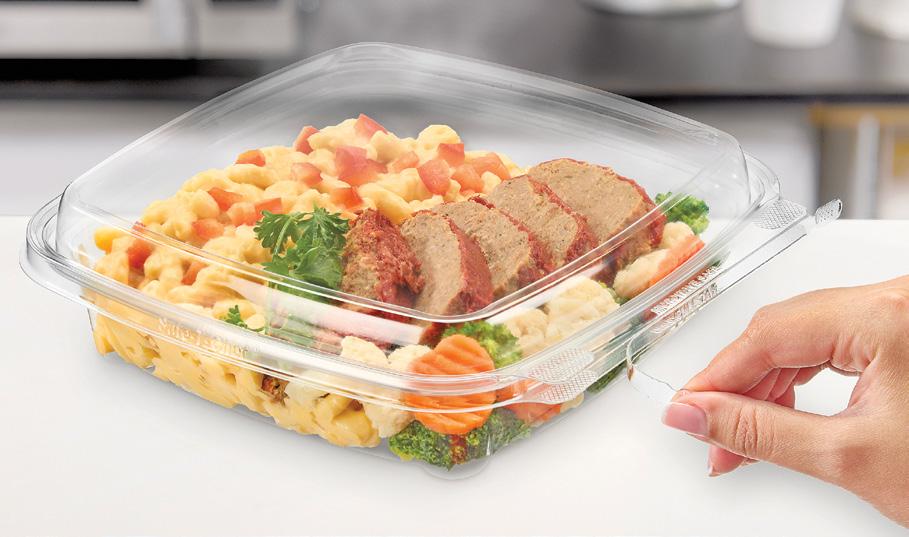
SCOOP knows that hot food packaging just got cooler. Inline Plastics is heating up the food packaging scene with new additions to its Safe-T-Chef® line, recently announcing a strategic expansion with two state-of-the-art 9x9 options. These new offerings represent the latest evolution in foodservice packaging, built on Inline’s patented tamper-protection technology that revolutionized the industry. Perfect timing? You bet. The expanded Safe-T-Chef® line addresses surging demand from grocery retailers, restaurants, and delivery services for secure, sustainable hot food packaging. Crafted from premium polypropylene, these containers deliver superior performance while maintaining the brand's commitment to food safety and environmental responsibility.
"Let's face it, the food industry never stands still," said Marlene Bautista, Product Portfolio Manager at Inline Plastics. "Today's foodservice operators need packaging that does more than just contain food –they need solutions that protect integrity, ensure safety, and support sustainability goals. Safe-T-Chef® delivers on all fronts.”
Key Features include: Tamper Evident & Tamper Resistant: First-of-its-kind tamper protection in polypropylene containers; Sustainability: All-clear material makes it easier to sort at material recovery facilities, supporting sustainability efforts; Versatility: Engineered for hot food applications, the containers maintain integrity during transport and delivery. For more information on their vast line of awardwinning products, visit inlineplastics.com.
continued on page 88


SCOOP knows that, situated in the heart of New Jersey’s renowned industrial region, the Hamilton/Trenton area is synonymous with US manufacturing excellence. Known for housing numerous American-made factories, this region reflects a proud heritage of quality and innovation. At Modern Line Furniture, they are proud to contribute to this legacy by producing commercial Furniture for restaurants and all other commercial establishments. Modern Line Furniture specializes in creating commercial restaurant and hospitality furniture that is as durable as it is stylish. Their commitment to quality is rooted in their local production process—every piece is made right there in New Jersey. By keeping their manufacturing close to home, Modern Line can ensure a faster turnaround, maintain strict quality control, and offer customized solutions that meet the evolving needs of clients.
They invite all industry professionals to visit their facility and see for themselves what sets Modern Line Furniture apart. Lately, ModernLineFurniture.com has been welcoming significant traffic from industry leaders visiting their factory in Hamilton/Trenton, NJ. Large construction companies, designers, architects, and dealers are all discovering the advantages of partnering with a local manufacturer that upholds the highest standards of American craftsmanship. Whether you're in early stages of the project or have a certain deadline, their doors are open for you to experience the craftsmanship, innovation, and local pride that define their products. "Come, See, Feel and Touch" and discover why so many are choosing to invest in US-made furniture that elevates any commercial space. Visit ModernLineFurniture.com/showroom/ and see how their commitment to local manufacturing and exceptional design makes all the difference. Experience the quality and reliability of "Made in New Jersey" today!
SCOOP learned that The National Restaurant Association Restaurant, Hotel-Motel Show® recently announced the 2025 Kitchen Innovations (KI) Award winners, recognizing the most groundbreaking advancements in foodservice equipment and technology. These awardwinning products address critical industry challenges, from streamlining kitchen workflows to improving sustainability and consistency, setting new standards for efficiency and performance. The 2025 KI recipients will be on display in the Kitchen Innovations Showroom, where attendees can explore solutions designed to enhance operations and drive growth. The Show, taking place May 17–20, 2025, brings together a comprehensive cross-section of the foodservice industry—from equipment dealers and quick-service operators to educational institutions and independent restaurant owners. Attendees will not only explore innovations like the KI Award-winning products but also discover the latest trends, ingredients, and technologies across every area of foodservice.
“The KI Awards celebrate solutions that are not just innovative but truly impactful for foodservice operations,” said Tom Cindric, President of Exhibitions for Informa Connect Foodservice. “This year’s recipients demonstrate how technology and design are revolutionizing kitchen operations, creating seamless integration between back-of-house efficiency and front-of-house service, all while enhancing consistency and delivering exceptional customer experiences. The National Restaurant Association Show is where these advancements come to life, giving attendees a chance to experience them in action, speak with the innovators behind them, and find solutions that fit their business.”
For more than two decades, the Kitchen Innovations Awards have recognized foodservice equipment that addresses real-world challenges and drives progress across the industry. An esteemed panel of industry leaders, including representatives from global brands like Walt Disney World Resort, Aramark, and Cracker Barrel, evaluated each submission based on its real-world impact and lasting value to foodservice operators. Richard Eisenbarth, President, Emeritus at Cini-Little International and a long-standing KI judge, highlighted this year’s recipients and emphasized the evolving landscape of foodservice: “The 2025 Kitchen Innovations Awards spotlight solutions that embody the industry's evolution: doing more with less. From AI-driven monitoring to productivity-enhancing robotics, these innovations are reshaping kitchens, helping restaurants adapt
and excel in today's dynamic culinary landscape.”
The 2025 Kitchen Innovations Award recipients are:
• Origin™ Convection Ovens From Alto-Shaam, Inc.
• BuffetBoost™ Warming Block From American Metalcraft
• Automated Fresh Brew: SimpliciTea 1500 From Appliance Innovation
• Chillstream™ Undercounter Frozen Food Dispenser From Atosa USA, Inc.
• OMM Automated Egg Cooker From Bridge Appliances
• CHrisper Station From Carter-Hoffmann
• RoboFry X4 From Charter House Innovations
• Scraegg Egg/Porridge/Soup Cooker From CookUp Group Inc.
• Dual Fuel Gravity Charcoal Oven From Doyon
• Digital Kitchen Application Platform From Ecolab
• PFAS (PFOA/PFOS) Reduction Systems From Everpure from Pentair Water Solutions
• Qeamer From Kitchenless
• FIZZBOT™ From Lab2Fab LLC
• NEO Undercounter Ice Machine w Filtration From Manitowoc
• MilkPal From Marco Beverage Systems
• Metafoodx Platform for Foodservice Operations From Metafoodx
• LongWave IR Oven From Middleby Marshall
• Gravity Beverage Fountain System From Newton CFV
• Total Oil Management by Open Kitchen From Powerhouse Dynamics
• Grill Station Assistant From PreciTaste
• Smart Kitchen System Hub From Renau Corporation
• The Surface Unlimited Induction Table From Spring USA
• Dynamic Response Refrigeration™ with Smart Control™ From Traulsen
• TRM - True Retail Merchandiser From True Manufacturing Co. Inc
The Kitchen Innovations Awards have long been recognized as a defining moment for breakthrough foodservice technology, with award recipients gaining exposure to thousands of industry professionals, from independent operators to large multi-unit brands. Being showcased at the National Restaurant Association Show allows these innovations to reach the buyers, dealers, and decision-makers who drive industry-wide adoption. For more details on the Kitchen Innovations Awards and to register for the 2025 National Restaurant Association Show, visit nationalrestaurantshow.com.
continued on page 90


SCOOP learned that VT Burner’s partners are launching their new lines of high-efficiency equipment in 2025, designed to elevate your kitchen’s performance and save you money on your gas bills.
There is a national standard for high-efficiency gas cooktops (ASTM Standard F1521) and several states offer cash rebates to incentivize consumers to upgrade their cooking equipment to meet these standards. Many states offer rebates from $600 to $3,000 on energy-efficient commercial kitchen equipment. This is exciting news for the commercial cooking industry, and Hi Efficient products powered by VT Burner Technologies can get you those rebates!
Key Benefits include: Patented High Performing Fryers, Infrared Charbroilers, Chrome Griddle Tops, Largest Oven Capacity, High Efficiency Stockpots, and Burner Upgrade Kits for the Field Brands Powered by VT Burner: Vortex by MVP, Infinity by Migali, Emerald by Asber, and Genesis by Venancio.
SCOOP discovered that Vulcan, a division of ITW Food Equipment Group and a best-in-class supplier of topquality, energy efficient equipment, introduced its new Chef’sCombi combi oven — an innovative addition to its highly-reputable product offering that is powerful, intuitive and customizable.
“We are thrilled to introduce the Chef’sCombi to the market. Vulcan developed our new combi oven with chefs
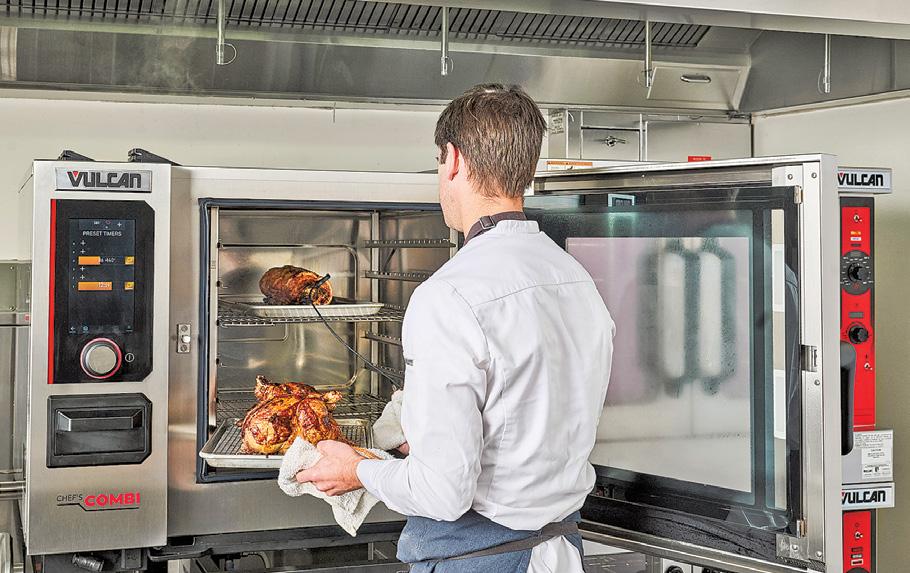
in mind. We wanted to create an oven that’s customizable with unique features so chefs can have everything they need, and nothing they don’t for their operation. Price was a focus too. It’s important to us that Chef’sCombi is an affordable and profitable piece of equipment today and for years to come,” said Carine Wright, senior business development manager for combi ovens at Vulcan. “And because it was developed using ITW’s CustomerBack Innovation, chefs can be assured that they can easily produce consistent, high-quality results, followed by simple, effective and affordable cleaning.”
The Chef’sCombi features CombiOS — the new standard in combi operating systems, with a high-resolution 10" touchscreen that is intuitive, responsive and adaptive, similar to the swipe, drag and tap features of a smartphone. CombiOS includes an easy-to-use, customizable interface with fast response to inputs that eliminates long start-up times. Users can control which features appear on the home, cooking and cleaning screens, and which are hidden — providing them with the simplicity and efficiency to streamline their operation.
Vulcan designed the Chef’sCombi with its patented CombiClimateControl technology, featuring powerful heating elements, multi-speed fan, advanced steam generator and industry-leading dehumidification. Plus, a true humidity sensor delivers precise humidity control for consistent cooking conditions, maximizing food yield with no guesswork. CombiClimateControl provides powerful heating for short heat-up times and rapid compensation of any temperature drop when fully loaded, or with frequent door openings during à la carte operation.
To ensure the Chef’sCombi stays in top condition, Vulcan integrated CombiCare for easy, safe and hygienic cleaning. With automatic soil detection, Chef’sCombi recommends the appropriate cleaning cycle and prevents the waste of resources, including water and electricity. Additionally, cleaning chemicals cost 10 to 15% less than other major combi brands, making cleaning Chef’sCombi not only easier, but also more affordable.
Other notable features include: AutoClimate - Automatic humidity adjustments based on a set temperature for optimum flavor and texture; CombiGuide – Guided automatic cooking, ensuring consistently delicious results, no matter who is at the controls; and MenuMix –Smart technology that provides high-quality results from
mixed loads.
The Chef’sCombi is available in gas or electric across the 6- and 10-level sizes, with a 20-level coming to market in 2026. The available combi ovens are stackable; and in the stacked configurations, the highest shelf stands at just 63 inches, ensuring accessibility for all chefs. Ventless options are also available.
As part of the ITW Food Equipment Group, the Vulcan Chef'sCombi is backed by the unmatched support of Hobart Service. Installation costs are comparable to the market leader. Users also have the availably to outfit entire kitchens from food prep to warewash equipment from ITW Food Equipment Group brands like Hobart, Traulsen, Baxter and Berkel.
SCOOP has learned that the Grease Lock Filter System is a revolutionary solution designed to capture up to 98% of grease particulates in commercial kitchens, preventing dangerous buildup that can lead to fire hazards in ventilation systems and costly roof repairs. This system is crucial for maintaining kitchen safety, cleanliness, and the efficient operation of exhaust systems. Featuring advanced, biodegradable filters, it ensures sustainability while maximizing filtration performance. The system is easy to install, compatible with most OEM ventilation systems, and reduces cleaning frequency, significantly cutting down on maintenance costs. By optimizing airflow, it enhances energy efficiency, while also lowering fire risks by minimizing grease accumulation. The fireresistant filter medium further contributes to safety, improving overall kitchen air quality. Additionally, Grease Lock filters lower maintenance costs, reduces water consumption, and extends the lifespan of exhaust components, ultimately saving money on repairs. In conclusion, the Grease Lock Filter System boosts kitchen efficiency, safety, and cost-effectiveness, making it an essential investment for commercial kitchens seeking to improve operational longevity and safety. For more information, visit www.greaseLock.com or call 800-828-9638.
SCOOP learned that with rising food costs due to new tariffs and ongoing labor shortages, food distributors are under increasing pressure to streamline operations and reduce costs. Automation is playing a growing role in ad-
continued on pgs 92-93


dressing these challenges, particularly in order management, which has traditionally been a slow, manual, and error-prone process.
Choco, a technology company focused on modernizing the food supply chain, is introducing Autopilot, an AI-powered system that eliminates the need for manual order processing. The technology builds on Choco AI, which digitizes orders from voicemail, SMS, WhatsApp, and email, inputting them directly into a distributor’s ERP system to remove the need for manual data entry.
Once orders are digitized, Autopilot takes automation a step further by evaluating each incoming order, checking for accuracy, and determining whether it can be processed instantly or should be flagged for review. This allows distributors to automate routine orders while maintaining oversight on more complex or sensitive transactions.
Early adopters, including The Menu Partners, have reported that Autopilot is already handling approximately 50% of their orders without manual intervention. The technology has helped reduce administrative workload, allowing teams to focus on higher-value tasks such as customer relationships and business growth.
“Automation in food distribution has historically lagged behind other industries, but with ongoing labor challenges and cost pressures, more companies are looking for ways to improve efficiency,” said Dan Khachab, CEO & Co-founder of Choco. “Autopilot helps distributors process routine orders without manual effort, while still giving them full control over the most important customer relationships.”
For the contact info, you can use contact@choco.com.
SCOOP knows that consumers are demanding more from their foodservice establishments. No longer is great-tasting food enough. Guests are craving memorable experiences to share with friends and family on social media. Nassau Candy, a leading confectionery and specialty food wholesale importer, distributor and manufacturer, has found with its foodservice customers the thoughtful incorporation of candy and snacks can be a major step towards creating an immersive experience. Nassau Candy supplies a wide assortment of bulk and packaged candy, chocolate, gourmet snacks and specialty food to restaurants, bake shops, campus dining, independent coffee shops and the hospitality space across the country. The company has
found that using candy and snacks to generate upsells isn’t a one-size fits all model. There are many different ways candy and snacks create an immersive guest experience and generate sales.
For quick serve and dining stations, incorporating international candy and beverages is one way Nassau Candy’s customers are finding success. Sushi stations, for example, have long been a highlight of dining experiences. By simply adding in packaged Japanese candy and beverages breathes new life into the station. Japanese candies’ exotic textures and flavors make guests feel like they’re getting a signature experience. These include Konpeito Star Candy, with its extra crisp crunch and star shape. Or the bright citrus flavor of Ramune soda with its marble stopper that gets pushed in for a signature clink that can be recorded for social and shared. Coffee stations are another area where Nassau Candy has found is ripe for an elevated experience. Whether the coffee station’s self-serve or barista-run, both can benefit from placement of single-serve chocolates and snacks. The shift to single-serve snacks stems from the rising trend of little permissible everyday indulgences. As coffee is often seen as a daily perk, it’s ripe for pairing with single-serve chocolates. Not only is chocolate a great paired with coffee, the smaller portions are portable for snacking on the go.
For the restaurant space, Nassau Candy has found candy garnishes can create shareable moments for social. Candy in fun shapes creates major visual impact with minimal effort. Like a giant gummy shark topping tropical cocktails, or trendy espresso martini adorned with chocolate covered espresso beans. Even colorful cupcakes topped with crispy and colorful freeze-dried candy. Along with pulling from its wide assortment of distributed lines, Nassau Candy can draw on its inhouse private label manufacturing capabilities to create custom experiences for foodservice. For example, in the hospital dining space, they’ve created custom candies for appreciation days like Nurse’s Day as well as pop-up shops at universities with school-branded candy and chocolates.
Another big trend that Nassau Candy is seeing in the foodservice space, particularly for hospitality, is the emergence of bulk candy and trail mix self-serve stations either in lobby gift shops or other locations on premises.

These spaces are less bins than traditional serve yourself candy stores but are making a major impact. Customers like the personal experience creating their own candy mix provides. Learn more at www.nassaucandy.com/
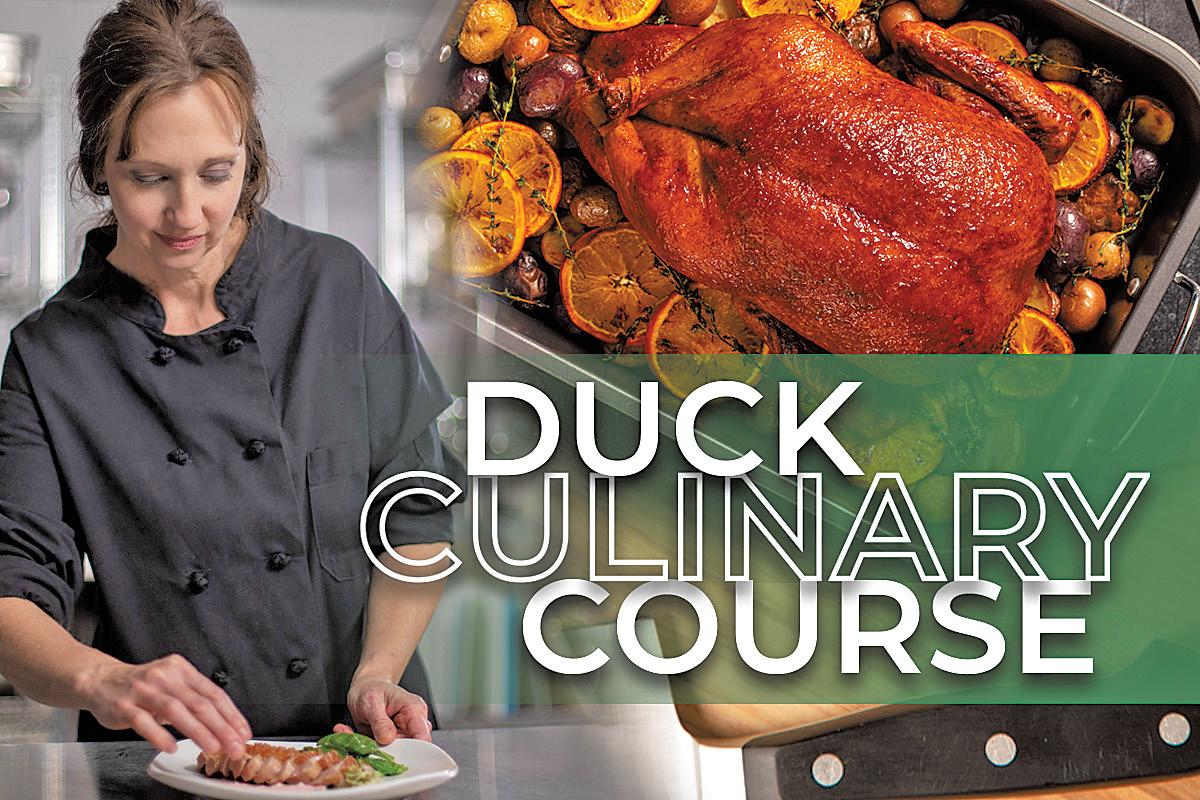
SCOOP learned that Maple Leaf Farms is elevating culinary education with the launch of its new Duck Culinary Course, designed to equip aspiring chefs in culinary schools with the knowledge and techniques needed to master duck preparation.
“Maple Leaf Farms has long been committed to supporting the culinary arts and education,” said Director of Marketing Olivia Tucker Ruddell. “Updating our culinary course so that it is available online and in easy-tomanage modules will allow more culinary students the opportunity to ex-plore duck and expand their culinary skills.”
Currently, the course offers more than 10 modules on topics ranging from duck breeds and safe food handling to how to cook duck breast and make duck stock. Additional course materials, which will include video recipes for several modern and classic duck dishes, will be launched later in 2025.
“As much as we love to encourage creativity when preparing duck dishes, we also want to cele-brate duck’s vast culinary history by helping students learn how to cook the classics,” said Ruddell. “Some of the world’s most popular duck dishes have centuries-old roots in cultures across the globe. We want culinary students to be comfortable cooking these dishes as well as more modern duck recipes.”
Maple Leaf Farms Virtual Duck Culinary Course can be accessed free of charge by visit mapleleaf-farms.com. Culinary instructors with questions can reach the company at mlfmarket-ing@mapleleaffarms.com.
SCOOP heard that PlantSwitch, the maker of plantbased compostable plastic utensils, jars, containers and straws has hit national retail shelves. As part of their partnership with Taylor Farms, PlantSwitch forks are now included in each of Taylor Farms’ six new packaged Chopped Salad Bowls, replacing traditional petroleum-based single-use plastic forks. More national retail brands will be rolling out PlantSwitch single-use plastics in the coming weeks and months. PlantSwitch’s CompostZero resin is a bio-based alternative to conventional plastic that is certified compostable in both home and industrial compost bins and machinery. The company makes its “plastic” using cellulose from upcycled agricultural waste streams. PlantSwitch utensils, straws, jars and containers look, feel, and perform identically to traditional plastic, and they emit zero microplastics into our environment; instead breaking down completely into compost in a matter of weeks. What sets PlantSwitch apart is Its ability to drop into existing plastic molding machinery, making it more cost-effective than other plastic alternatives. Its high-performance capabilities. Considerable VC and government-backed capital for rapid growth of infrastructure, manufacturing and overall scalability. Quickest breakdown in the average home composting bin.
Contact Christian Malcolm, Head of Food Packaging Sales at cmalcolm@PlantSwitch.com and learn more about the products at www.plantswitch.com.
SCOOP heard that The James Beard Foundation® (JBF) announced the findings of its “2025 Independent Restaurant Industry Report,” revealing an industry at inflection as it faces challenges across multiple fronts. In collaboration with Deloitte, the report is a nationwide study providing a data-driven look at the current state of independent restaurants and their outlook for 2025, examining factors from rising costs and labor challenges to shifting consumer behavior.
Despite substantial challenges, the report reveals an industry demonstrating remarkable fortitude and innova-
tion. Through strategic adaptation and creative problemsolving, independent restaurants are actively evolving their operations to meet current market demands, while preparing for future uncertainties. The study identified four major trends that are reshaping the industry landscape: 1. Overcoming barriers to increase guest spend; 2. Intentional engagement to deepen guest connection; 3. New ways to attract and retain a winning team; and 4. Increased urgency to evolve business models. The research findings stem from in-person chef interviews and a nationwide survey of over 400 restaurant owners and operators conducted in 2024. The study represents a broad cross-section of the independent restaurant industry — spanning 47 states and all four census regions — with respondents ranging from fine dining establishments to fast-casual venues, breweries, and caterers. To read the full report visit https://www.jamesbeard.org/2025-independent-restaurant-industry-report.
SCOOP heard that the National Restaurant Association recently announced Leslie Nagao as its new Chief Marketing Officer. Her leadership will bring together internal teams and external partners to strengthen the message of the restaurant industry, drive Association membership, and expand the products, programs, and services the Association creates to support restaurant operators of all sizes. “Leslie is the marketing leader we need to position the National Restaurant Association and the National Restaurant Association Educational Foundation to be indispensable partners to the restaurant industry,” said Michelle Korsmo, President & CEO of the National Restaurant Association. “She has extensive expertise in brand strategy, member engage-
ment, product marketing, events and communications, and public relations, and she has proven success delivering growth and impact across diverse industries. As CMO, Leslie will unify and elevate our marketing and communications strategy, ensuring a cohesive, coordinated brand experience that amplifies our presence and deepens engagement with our members, industry partners, and other key constituencies.” Nagao comes to the Association from the Urban Land Institute, where she served as Global CMO, driving membership and event revenue growth, increasing its thought leadership position through communications and public relations, and increasing ULI's brand reputation globally. Her experience also includes senior marketing roles at ExxonMobil, AARP, and Time Warner, along with agency leadership at WPP. "The restaurant and hospitality industry has been a defining part of my journey—from my first job to my college years,” said Nagao. “The experience shaped my leadership philosophy and equipped me with invaluable skills that I carry to this day. Restaurants are the heartbeat of our communities, bringing people together and creating lasting memories. As Chief Marketing Officer for the National Restaurant Association, I’m honored to champion the powerful story of this industry and its dedicated people while highlighting its profound economic and community contributions.”

things adhere to the same principles.
“For a brand refresh project, we might take the original concept and optimize or modernize it to better align with the business. This maintains a sense of familiarity and recognizability for the business, but it feels brand new. This same approach applies to the menu, as it’s not a departure from the original concept but rather an improvement or advancement of the menu and decor. There needs to be a detectable element at the core that rings with familiarity.”
A brand refresh will focus on improving primary brand assets, logos, color palettes, and typography. Then, brand collateral, like business cards, email marketing templates, landing pages, social icons, and banners, will be created using the new visual identity. This formula applies to the restaurant concept by improving existing offerings, adding fresh food and beverage items, a palpable change in service and presentation, a visual refresh in décor, and a new outlook on marketing, including partnerships and collaborations with thirdparty platforms and influencers.
Rebranding involves a new restaurant outlook. It can be a departure from the original concept and even an opportunity to move past a current customer base. Starting fresh can be nerve-wracking for many operators, as losing what was positive and effective is daunting. Grotta reminds us that those elements can remain in a rebrand, but they are reframed in a way that only holds on to the essence of what’s salvageable. This can be as straightforward as keeping the most popular dishes on the menu but renaming them somehow or referring to them as an “homage to” the former restaurant brand. This is a common practice for restaurateurs who move into a restaurant space with a history, and it can easily be applied here. The same applies to ownership and staff who will remain with the rebranded concept. Let customers know that their favorite bartender will still be there to shake up their martini.
While there are safeguards to implement with a rebrand, one mustn’t forget how and why they arrived at the decision to rebrand and move in another direction. Having a clear sense of the new direction you are going in is paramount. Take your time crafting this new or rei-
magined concept. This is your second chance. There isn’t a third.
“I recommend setting aside a budget for branding. It’s the first (new) interaction you will have with a customer before they have an in-person experience. Do not underestimate the power of effective branding from the start. Starting out properly will generate excitement, prevent the need for further changes, and help get people in the door,” explains Grotta, “Don’t sleep on your website. People look for restaurant recommendations online, and having an outdated or bad website will drive potential customers to other places. Your website is often the first time people are interacting with your business, and you want to make that first impression a good one to get them in the door.”
Key time and financial investments that may have been overlooked or implemented with shortcuts the first time around that are essential tools in both a refresh and rebrand scenario include:
• Great photography. Whether it’s food and beverage photography or photos of the venue, pictures really do say a thousand words and sell the experience of your restaurant. You will need to overcome past images that previous customers might remember.
• Your photography, logo, website, and copywriting are all branding. Make sure they're elevated and cohesive.
• Incorporate tastings into your opening agenda. Staff, friends, family, and even customers will be brutally honest. Use their feedback to ensure your “new” menu departs from the previous food and beverage offerings. Create new signature dishes and revisit the ideas you wish you had put on the menu previously.
• Training. A rookie mistake is assuming that the experienced crew you hired is well-versed in all things “your brand.” They are not. Even the most seasoned staff member needs to be educated about your style and brand philosophy, proficient in the dishes and beverages, trained on your POS system, and informed of your preferred service approach.
• Be more aggressive with your marketing campaign and utilize social media to its fullest. Marketing is not a conservative sport. Put a little money behind your
social media advertising, as a little goes a long way. Create relationships with social media influencers. Regardless of your feelings on this “new media” methodology, influencers are the new media, and the quicker you embrace this, the better results you will have on social media. It's more important to have other people posting on their platform than it is populating your platform. A brand introduction or reintroduction needs to go beyond your existing audience – other
ing and protect meal access.
The conference featured panel discussions on rising costs, administrative burdens, and threats to CEP. Advocacy culminated in direct meetings with legislators, where nutrition directors shared real-world stories of struggling to maintain meal quality amid inflation and staffing shortages.
“The proposals on the table will only widen the gap between what students need and what schools can afford to provide,” Gleave noted during the conference. The loss of LFS and Farm to School funding isn’t just about lunch trays — it's about livelihoods. The LFS program, funded during the pandemic, allowed districts to buy food directly from local farms and ranchers, boosting both nutrition and local economies.
One Arizona district reported losing $100,000 earmarked for fresh beef and vegetables, wiping out its ability to support regional farmers. “It’s a pretty big hit,” said nutrition director Patti Bilbrey. “It wasn’t just about keeping food costs low— it meant supporting your community.”
In Arkansas, a rural district used its grant to serve ground beef sourced locally, yielding better-tasting meals with less shrinkage and fewer additives. The district’s director, Amanda West, emphasized the ripple effect of these programs: “It helped a lot of districts, including mine. And it would be amazing if we could get it back.”
The ripple effects extend beyond schools. Food banks nationwide relied on USDA local food programs to supplement donations with high-quality goods
people's followers need to hear about you.
Arriving at the brand refresh or rebrand decision is significant, but it is also an exciting one that should be embraced. Avoid the mistakes of the past. Enjoy the process even more this time around. You have plenty of experience to draw from, and this time around, your new or refreshed brand is going to be better than your first!
from page 6
— peanut butter with jelly, pasta with sauce. Now, with cuts to the Local Food Purchase Assistance Cooperative Agreement, many will be forced to scale back or turn to cheaper, processed alternatives.
“We’ll have to ration what little we have,” said Eric Cooper, CEO of the San Antonio Food Bank, which lost nearly $3 million in anticipated funding.
A recent SNA survey found that 80% of school districts say federal reimbursements don’t cover their meal costs. As prices for food, equipment, and labor soar, programs are facing existential threats.
In the face of these cascading cuts, the SNA is doubling down on its call for bipartisan action to safeguard school meals. They warn that without intervention, the nation risks undoing years of progress toward nutritional equity.
“The programs being cut are the very ones that help students learn how to eat well,” said Gleave. “They’re foundational. And when we dismantle them, we’re not just hurting today’s lunch menu — we’re jeopardizing long-term health outcomes.”
The Trump-Musk administration insists these cuts are part of a return to “fiscal responsibility.” But school districts, food banks, and advocates argue that the programs being eliminated delivered measurable results and addressed real community needs.
As Congress weighs its budget priorities, the voices of school nutrition professionals grow louder. Their message is clear: Feeding children isn’t wasteful spending — it’s an investment in the future.


numerous tools available today, including AI and user-friendly templates, you can create an attractive website in just a few hours.
When building your site, remember that content is key. Focus on the essentials: present your menu, hours of operation, and any specials you may have. However, the most critical aspect is the "why." Describe the experience you offer and what makes you unique. Tell your story—what inspired you to open this restaurant? Sharing your passion will help customers connect with your brand and ultimately fall in love with it. Having a website also allows you to implement an online ordering system. Use services like Uber Eats or DoorDash to expand your customer base and remain competitive.
It's important to post regularly on social media. Showcase new menu items and develop a following; your followers will help promote your restaurant. Don't forget to complete your Google Busi-
ness profile. When potential customers search for options like "What should I eat tonight?" or "I'm craving Italian food," you want to appear at the top of their list. Additionally, make sure you're visible on Google Maps for those searching for nearby dining options, especially guests looking for a meal near their hotel.
One important tip is to use high-quality photography for your dishes whenever you post. Make them look as delicious as they are! Another suggestion is to train your staff to ask for reviews, especially when they know a customer has had a great experience. Google, Yelp, and social media reviews are crucial for building your brand.
If you can excel in the two areas mentioned above—enhancing your restaurant and establishing a strong online presence—you are well on your way to building a great brand. However, if you have an additional budget and time, let's explore some advertising possibilities.
First, let's focus on your restaurant.
from page 8
“I love when products really showcase a sense of place, which is a real differentiator for products today and resonates with consumers who are looking to travel and experience new locales. At the Winter show, we had Pacific Popcorn's flavors like Portage Bay Strawberry and Alpine White Chili Cheddar…
“When we talked to the team at the Hawaiian Vinegar and Spice Company, it felt like we got to try a little taste of Hawaii in the banana vinegars they had. We had honeys that were from specific fields, olive oils that transported you to Italy. I can't wait to see more manufacturers really showcase a sense of place in their products.”
– Mike Kostyo, Vice President, Menu Matters
SFA is inviting participants to “Find Your Fancy” at this year’s Show. What are you hoping to find?
“The next must-have gourmet product that will surprise and delight our customers—something that blends tradition with innovation and elevates everyday indulgence.” - Josh Gryvatz, Gourmet Foods Dept Manager, Wine Library
“National retail and foodservice buyers to expand Veggie Underground's national presence.”
– Dina DiCenso, Founder, RIND
“New cheese(s) that have not yet been
How you present your menu and specials —whether through information boards, video screens, or table displays—can make a significant impact. There is no single approach to this; it depends on the atmosphere of your restaurant and your specific goals. The key is to deliver your content clearly and engagingly.
Now, let's consider advertising outside of your restaurant. The easiest way to engage in advertising is through paid social media platforms. Consider pay-per-click advertising online. Both options can be economical and less time-consuming. Hiring professionals for these areas can yield even better results.
As mentioned earlier, there isn’t a one-size-fits-all approach for every restaurant. There are various advertising opportunities beyond the online realm. For example, a billboard near your location may be ideal, or you could explore advertising via radio, television, or cable. In some markets, newspapers can still
launched on the retail floor, that are competitively priced and available in limited/exclusive amounts. I want to have a first look at items that will be first to market at our stores.” - Hayley Celentano, Cheese Buyer, Citarella
“New products that will fit into a busy family’s life (and also taste delicious!).” - Laurel Randolph, Associate Editorial Director, Simply Recipes
“A focus on packaging sustainability and better news on chocolate and coffee crop issues.” - Claudia Arcuri-Smith, Category Manager, National Co+op Grocers
“Items that don't just repackage the same trends over and over again in the hopes of riding a quick zeitgeist, but that bring new ideas that are also designed for the long term, meaning they taste good, they have a clear place in a consumer's pantry, and they can make that deeper emotional connection that you only see in food.” – Mike Kostyo, Vice President, Menu Matters
Registration is open now for the 2025 Summer Fancy Food Show! https://www.specialtyfood.com/fancy-food-shows/summer/register/
Please note that this is a trade-only event, not open to the general public.
be an effective way to reach customers. In conclusion, building a strong brand for your independent restaurant or small chain is not just a luxury; it’s necessary to survive and thrive in today’s competitive foodservice landscape. By providing an exceptional dining experience, maintaining a clean and welcoming atmosphere, and ensuring consistent food quality, you’re laying the foundation for a brand that customers can trust and love. Coupled with a strategic online presence and innovative marketing tactics, you can elevate your restaurant’s visibility and reputation. While the challenges are real, the rewards of a wellestablished brand are worth the effort. Stay committed, stay consistent, and always strive to make every customer interaction memorable. With the right approach, your restaurant can stand out, attract loyal customers, and ultimately achieve long-term success.
from page 72
undocumented people they find. If the agent presents a judicial warrant, management should cooperate with the agents but need not “consent” to the search. By contrast, if the agent presents only an administrative warrant, or no warrant at all, the agent is not authorized to search the premises or enter into non-public areas and can be told to leave. Neither managers nor any other employees have to answer the agents’ questions or give identification or papers to ICE (though employees should not run for the exits!). Regardless of the type of warrant an ICE agent presents, or whether they present one at all, managers should document the activities of ICE agents while on the premises, including by taking a photo of any warrant presented. Managers can also take photos or videos of the agents’ activities. Even if the agent tells the manager to stop, the manager is not breaking the law – though the agent may attempt to convince them otherwise. It is, however, of the utmost importance that no manager or other employee physically obstruct an ICE agent.
It is essential to promptly consult with legal counsel to determine additional steps to take, if any, in response to the agents' actions. The business should also ensure that all employees receive their regular wages for the time spent on the premises, even if they are not actively working during the raid. Tipped employees should be paid the full minimum wage without the tip credit, unless they actively served customers during the raid.
**
In sum, hospitality employers should take proactive steps to avoid adverse consequences in the event ICE targets their business.

AutoFry is a game-changer in concession stand operations. As a fully enclosed, automated, ventless deep-frying system, AutoFry makes frying easy, safe, and profitable. Here’s why it’s a great fit:
Benefits of AutoFry:
1. Ventless Operation
• AutoFry eliminates the need for costly ventilation hoods, making it perfect for smaller concession stands.
2. Ease of Use
• Fully automated, allowing staff with minimal training to operate it safely and efficiently.
3. Safety First
• The enclosed system reduces risks like grease burns and fires, ensuring a secure cooking environment. Furthermore, AutoFry is completely electric, eliminating the threat from carbon monoxide poisoning, and comes with a builtin fire suppression system.
4. Size Options
• With a range of sizes, including single and double basket models, it is easy to find the right fit for any location.
5. Cost Savings
• Ventless operation saves leagues thousands on hood installation and maintenance. Oil management systems extend frying oil life, reducing waste and costs.
6. Menu Expansion Opportunities
• With AutoFry, stands can add fanfavorite fried foods like onion rings, chicken wings, and even deep-fried desserts, boosting sales and offering more variety to customers.
To maximize AutoFry, consider:
• Training Staff Effectively: Though easy to use, quick training ensures smooth operation during busy game days.
• Creating Combo Meals: Bundling items (e.g., a corndog, fries, and a drink) increases per-ticket sales and improves customer satisfaction.
• Offering Seasonal or LimitedTime Specials: Rotating menu items keep customers returning for new and exciting options.
• Promoting High-Profit Items: Items like loaded fries or deep-fried pickles have high perceived value and great profit margins.
• Ensuring Consistent Quality: Regular maintenance and proper use of AutoFry help maintain food quality, keeping customers happy and returning for more.
A well-run Little League concession stand can enhance the game-day experience while providing essential league funding. Investing in high-quality, reliable kitchen equipment like AutoFry ensures efficiency, safety, and profitability—key factors in running a successful operation.
By leveraging AutoFry’s ventless, userfriendly design, Little League programs can elevate their concession stands, serve delicious food, and create an even more enjoyable atmosphere for players, families, and fans. If you’re looking to enhance your foodservice program, consider adding AutoFry to your lineup—it’s a winning play for everyone involved!
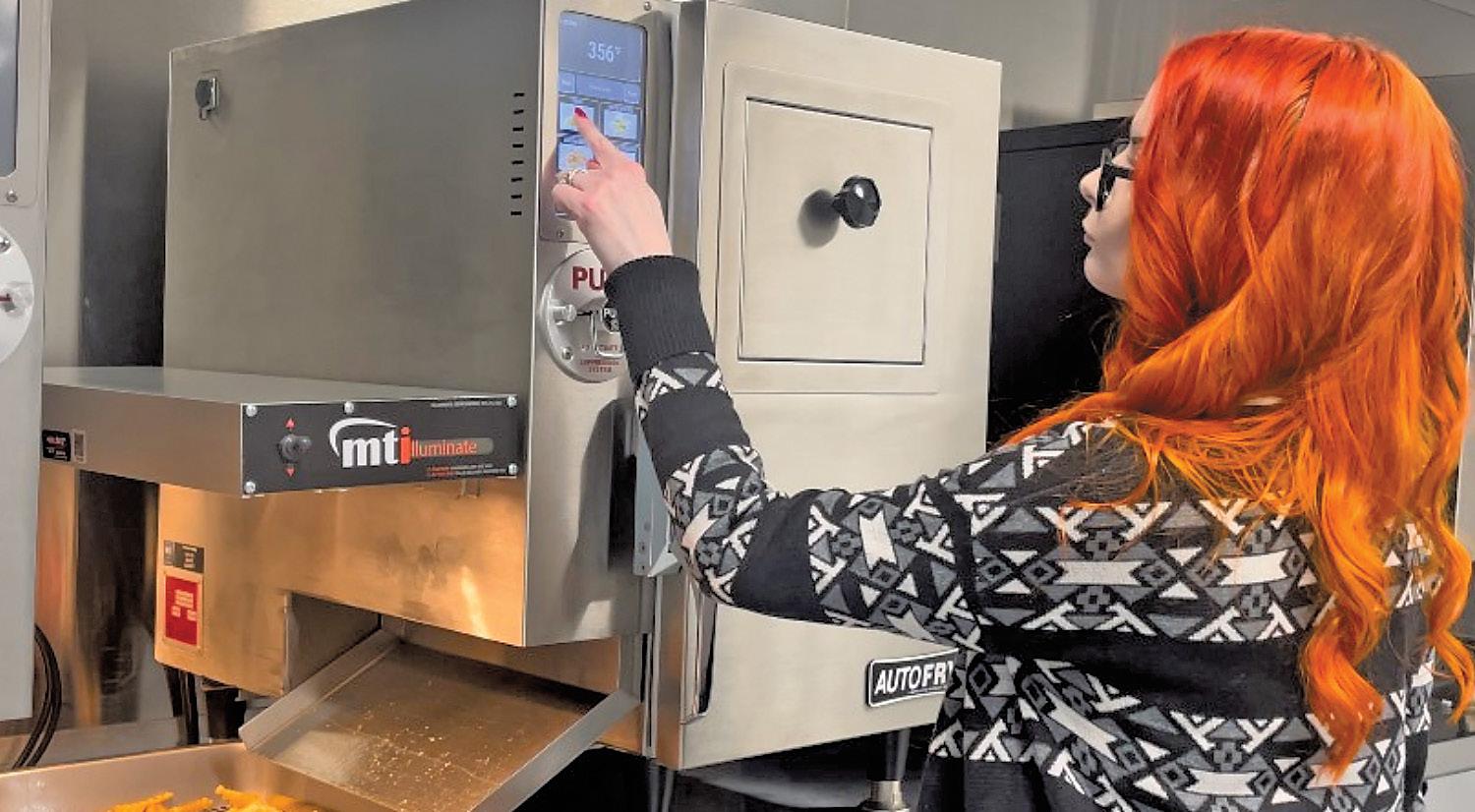
been at the heart of our cooking. Over the years, we have expanded our menu to accommodate gluten-free, vegan, and plant-based diets, ensuring that everyone, regardless of dietary preference, can enjoy the richness of Ethiopian cuisine.
What makes dining at your restaurant an authentic Ethiopian experience for diverse diners -- vegans, vegetarians, omnivores and meat-lovers?
Ethiopian cuisine naturally caters to a wide range of dietary preferences. In accordance with our Ethiopian Orthodox Christian traditions, we observe vegan fasting days on Wednesdays and Fridays, as well as during the Lenten season, like Easter, Christmas, and five other fasting periods. During these times, we ensure that every guest, whether vegan, vegetarian, or omnivore, can enjoy a delicious and truly authentic Ethiopian meal.
Your website says that Mesob is a favorite for both vegans & meat lovers. What Ethiopian plant-based dishes do you feature in the Mesob menu that appeal to vegans and vegetarians?
Our menu includes a variety of flavorful, 100% plant-based dishes that showcase the food's depth and richness. At Mesob, we take pride in honoring our
plant-based traditions, ensuring that vegans and meat lovers can enjoy Ethiopian cuisine's diverse and delicious flavors.
Some favorites include:
• Gomen (Collard Greens) – Slowcooked with garlic and mild spices
• Tikil Gomen (Cabbage & potato) – A comforting dish infused with turmeric and spices
• Atkilt Alicha (Green Beans & Carrots) – Lightly sautéed for a fresh and crisp taste
• Shiro – A creamy and flavorful chickpea stew with berbere spices
• Misir Wet (Spiced Lentils) – A rich, slow-cooked lentil stew
• Kik Alicha (Yellow Split Pea) – Mildly spiced and smooth
With a menu that caters to all dietary preferences and a commitment to preserving the authenticity of Ethiopian flavors, Mesob continues to be a must-visit destination for those eager to experience the rich culinary traditions of Ethiopia. Whether you're new to Ethiopian cuisine or a longtime fan, Mesob offers an invitation to explore, savor, and share in a truly special dining experience.
Learn more about Mesob at: mesobrestaurant.com.
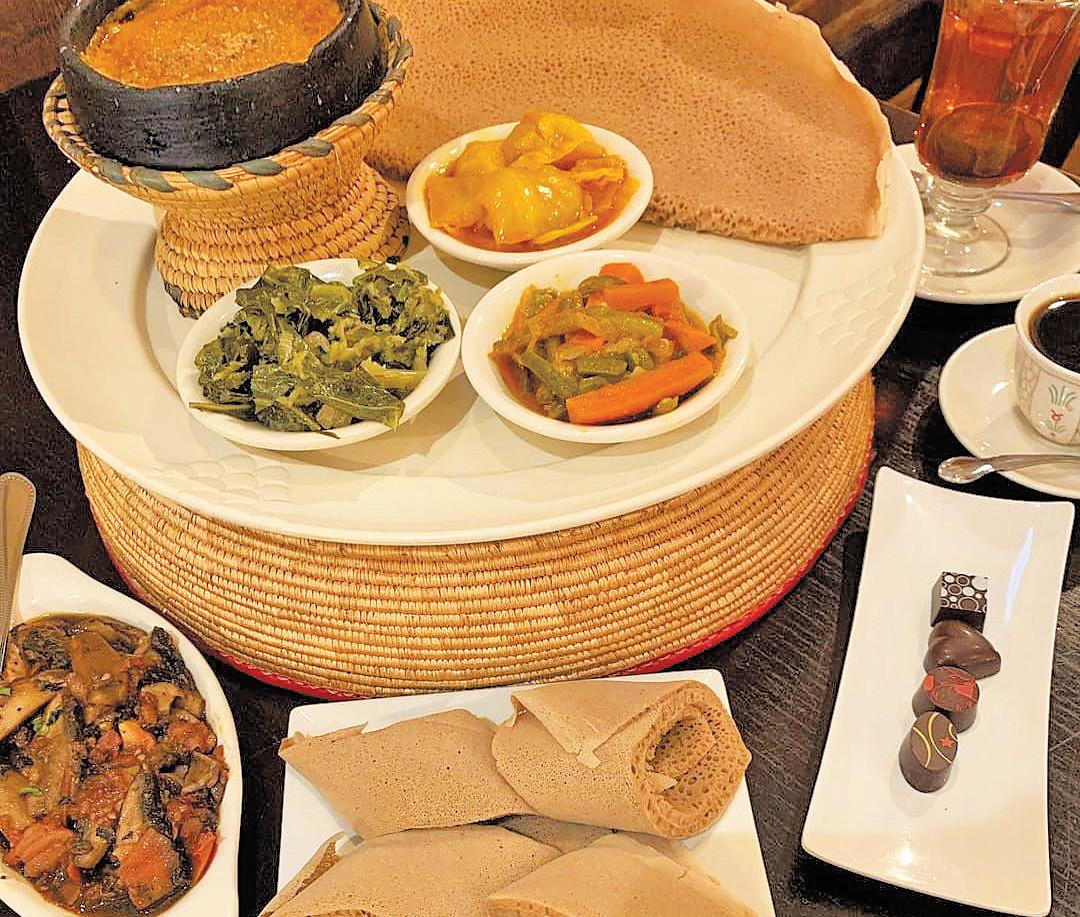

win-win!"
• Good Foods International (GFI) Flouwer Co. Cocktail Cubes: Lavender, Orange Water, Rose
• Uncle Waithley's Smoked Pineapple Ginger Beer
• Jøyus Non-Alcoholic Cabernet Sauvignon
• Moshi Sparkling Water in Lychee & Vanilla, White Peach & Yuzu
• Bee's Water, Native Blueberry Honey Water with Vitamin C + Elderberry Extract
• Ito En Oi Ocha (Hojicha)
Dairy and Non-Dairy Delights “The dairy aisle has more to offer than calcium, vitamin D, and creaminess. In the case of cheeses, exciting mix-ins and never-before paired flavors like Maaz ginger, Marieke Gouda with fenugreek, and Snowdonia Pickle Power amplify mouthfeel and give you the sensation of having more than just a bite of cheese. In the past, extra mix-ins hid the sins of low-quality products, but when you enhance quality milk, it can only get better
from there,” says Trendspotter Jenn de la Vega. “That doesn't mean every great product needs extra flavors; the new classics are here to stay, like Vermont Creamery's cultured butter. The world of dairy alternatives has turned a corner on quality and innovation. Forca Foods MILKish watermelon seedmilk utilizes often thrown out watermelon seeds to make a tasty, new, sustainable beverage, while RIND has found a way to use traditional cheese affinage to make a vegan aged Alpine style Swiss. It's an exciting time to explore the diversity of dairy and what it could be!”
• MAAZ Cheese, in Ginger, and Pickle
• Snowdonia Cheese Company, in Beech Wood and Pickle Power
• Vermont Creamery Salted Cultured Butter Logs
• Marieke Gouda Foenegreek Gouda
• RIND LLC plant based Alpine SVVIS
• Frost Buttercream frozen bakeryquality frosting
• Two Spoons Creamery Strawberries & Cream Keto Ice Cream
• European Imports Matcha Milk Jam
• Liko Lehua Lilikoi Butter
• Forca Foods MILKish Watermelon Seedmilk
Hawaii as Terroir "Hawaiian farms have their own unique, rich terroir - for produce but also animal production too. Hawaii's brands are leveraging the origins of Hawaiian farming, which some may say is underutilized in CPG. Hawaii is thought of for its pineapple and not the meats especially. I see that changing," said Matt Rodbard.
• Mauka Meats Wild Harvest Hawaiian Venison Bone Broth
• Island Sausage cured meats
• Hawaiian Vinegar and Spice Company Cacao Nectar Vinegar
• Galleon Chocolate Goat Milk Ube Bar, and Macadamia Nuts covered in Ube Royale
• Hawaiian Krunch Company, Granola with purple sweet potato
Small Farm, Big Impact "If you're delivering a craft, hand-made product, then it only makes sense to pair that with
an ethical brand,” says Trendspotter Sarah Lohman. “Consumers are interested in transparency and morality in the brands they buy from. And a memorable story makes the mission travel further, and the food tastes better!"
• Bellwether Farms Sheep Milk Yogurt
• Bluebird Grain Farms Einkorn Flour, Emmer Flour, and Sonora Heritage Soft White Wheat Berries
• Wapato Island Farm Smoked Salt
• Burlap & Barrel Single Origin Sugars
These trends and more will be on full display at the 2025 Summer Fancy Food Show, which features thousands of specialty food and beverage products from around the world, educational and event programming, and networking opportunities. The Show runs June 29-July 1 at the Javits Center in New York and is open only to qualified members of the specialty food trade, industry affiliates, and media.
For more information, go to https:// www.specialtyfood.com/fancy-foodshows/summer/

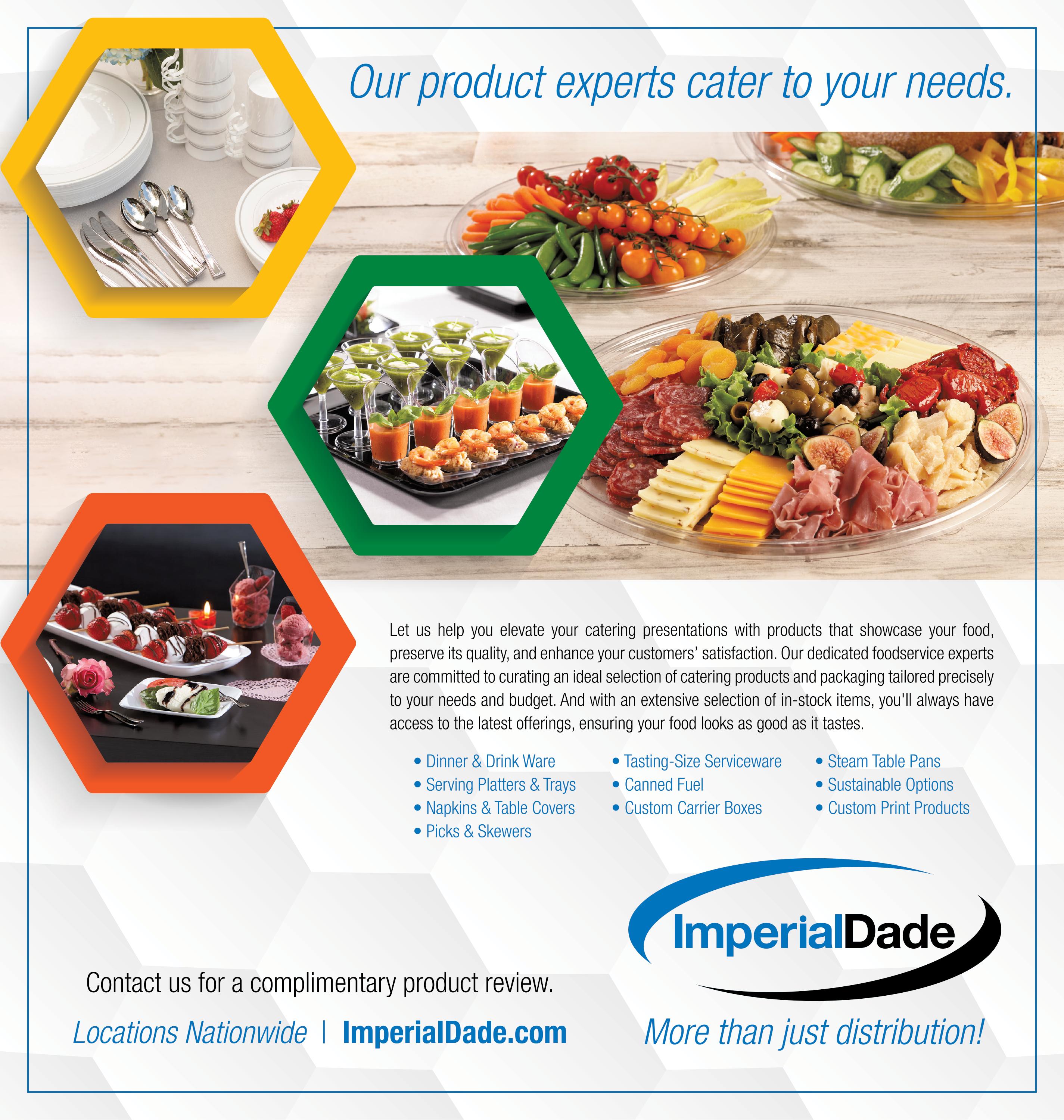
let families and care teams track wellness in real time. Even virtual culinary demos that connect residents with our chefs and dietitians. Technology isn’t replacing the human touch. It’s enhancing it—giving seniors more choice, more control, and more connection to their food.
One of the most rewarding aspects of my role is teaching and coaching other foodservice professionals. We hold workshops, lead innovation summits, and provide hands-on training to culinary teams across the country. The message I share is simple: Don’t underestimate your diners. Seniors today are more dynamic, diverse, and discerning than ever. They deserve food that honors their past while embracing the future. I often say, “Treat senior dining with the same creativity and care you’d bring to any five-star experience.” That mindset shift alone can change everything—from how menus are designed to how dining rooms feel.
At Restaura, we see the future of senior dining as personalized, purposeful, and people-driven. Personalized:
We’re developing AI-enhanced meal planning tools that adapt to each resident’s dietary needs and flavor preferences. Imagine a menu that evolves with you—not just based on health data, but also your favorite meals and memories. Purposeful: Food will become a central part of wellness programming. From “brain-boosting breakfasts” to interactive cooking classes focused on mobility and dexterity, dining will be fully integrated into residents’ overall well-being. People-driven: We’ll keep listening. The voices of our residents, families, and foodservice partners will shape every decision we make.
At the end of the day, food is connection. It’s comfort. It’s culture. And for seniors, it can be a powerful expression of independence and joy. We’re proud to be part of a movement that’s transforming senior dining from an obligation into an opportunity—to nourish, to delight, and to celebrate life at every stage. So the next time someone asks me what’s cooking in senior dining, I just smile and say, “Everything.”
from page 76
of exclusive ingredients like Valrhona Caraibe chocolate for desserts or Mediterranean spices like Sumac, which lend depth and authenticity to his menu.
San Diego isn’t an easy market. It’s saturated with talent, fiercely local in taste, and always chasing the next big thing. But Ruiz thrives in this environment because he knows his audience and stays grounded in the city’s culinary DNA. “San Diego is unique—we love bold flavors, but we also respect simplicity. You’ve got to walk that line carefully,” Ruiz said.
His formula for success includes relentless consistency, ensuring dishes taste as good on a Monday night as they do on a Saturday rush. He builds community connections by supporting local fishermen, farmers, and nonprofits like Waste Not San Diego. He leads with a team-first mentality, mentoring young talent and creating a culture of collaboration in the kitchen. “The stronger the team, the better. I make
This year’s lineup includes Harnessing AI to Decode Data: Waste Management Workshop, a hands-on session demonstrating how AI can optimize inventory and reduce food waste; CStore Recon: Growth Through Consumer Mission Trips, which explores real case studies on how convenience stores are adapting to evolving shopping behaviors; and Retailing 101, part of the new Essentials Track, focused on helping small and growing operators maximize margins and improve merchandising strategies. “The education sessions are a must,” outlined Harrington. “They provide real strategies that foodservice professionals can apply immediately to improve operations and increase revenue.”
The NAMA Show isn’t just reflecting industry trends—it’s driving them. Over the years, it has played a pivotal role in helping businesses transition from traditional vending to high-tech micro-markets and frictionless selfservice models. “Every major step in our company’s growth was influenced by what we learned at The NAMA
from page 12
Show,” said Harrington. “It’s where we’ve met our best partners, discovered new technology, and made decisions that have transformed our business.” Harrington, co-CEO of Royal ReFresh, began his journey in 2006 with two vending machines. Under his leadership, Royal ReFresh has grown into a prominent provider of vending services, including micro markets and office coffee services, serving the Portland, OR and Las Vegas marketplaces.
For foodservice operators, property managers, and vendors interested in exploring unattended retail, The NAMA Show is the place to be. Whether you want to network with industry leaders, attend workshops or showcase your products, now is the time to get involved. “You can vend anything,” concluded Harrington. “And The NAMA Show is where you learn how.” Attendees and exhibitors can find essential event details at thenamashow.org . The site also provides travel details, marketing tools, and show updates.
it a point to pass on everything I’ve learned. That’s how you build something lasting.” His commitment to sustainability has earned national recognition, including James Beard Foundation Smart Catch Leader certification. His restaurants are also Surfrider Foundation Ocean Friendly certified— a rarity in fine dining.
With Lionfish locations now open in San Diego and Delray Beach, Florida, and sister concept Serea flourishing at the iconic Hotel del Coronado, Ruiz shows no signs of slowing down. But even with growing success, he stays rooted in his mission: make beautiful food that honors the sea and the community around it. “At the end of the day, we’re just telling stories with food. The ingredients are the characters. You’ve got to treat them with respect.” And in San Diego’s everevolving dining scene, Chef JoJo Ruiz continues to be one of the most compelling storytellers around.
looks simple, but it is effective. It helps drive repeat business and build longterm customer relationships.
There is no doubt that SMS ordering is already transforming the food service industry. However, its future is bright, and it holds even more exciting possibilities. AI-powered SMS chatbots make ordering more intelligent and personalized. Imagine a restaurant with a chatbot that remembers customers' past orders, recommends complementary menu items, and even offers recommendations according to dietary preferences. Predictive menus are the future. It could take things a step further. As per the historical data, AI can forecast peak ordering times, which helps restaurants prepare in advance. It will optimize inventory management and ensure quicker service during high-demand periods. Besides, AI-driven SMS interactions can handle complex customer inquiries, of-
fer real-time updates, and improve the overall ordering experience.
In summary, with each passing day, competition is increasing, and customer expectations are evolving. Therefore, food service businesses can no longer afford to depend on traditional ordering methods. SMS automation is the quick and more efficient way to handle orders, increase customer satisfaction, and increase revenue.
SMS automation helps reduce order errors, minimize wait times, and make the ordering experience hassle-free. In short, SMS automation helps both restaurants and customers. Therefore, NOW is the right time to adopt this cutting-edge technology. Restaurants which incorporate SMS automation will stay ahead of their competitors by building stronger relationships with their consumers – One SMS at a time!

turnover rates—casual restaurants may opt for firmer chairs to encourage quick dining, while high-end restaurants prioritize plush, comfortable seating to enhance guest experience,” Katliarova outlined.
Many restaurants have successfully transformed their spaces by making strategic furniture choices. For instance, a New York bistro revamped its dining area with Modern Line’s modular seating, allowing it to accommodate everything from intimate dinners to large group events seamlessly. Another upscale steakhouse integrated highbacked booths to create a sense of exclusivity, boosting its average customer spend. “The right furniture can change the way customers perceive a space, how long they stay, and ultimately, how much they spend,” Spivak added.
Looking ahead, 2025 will see several emerging trends in restaurant furniture. These include two-tone designs, which combine contrasting colors for visual impact; gold and marble accents, which add sophistication; velvet and textured fabrics, which elevate comfort and elegance; and petrified wood and antique finishes, which bring character and uniqueness to dining spaces. Restaurants are moving towards statement pieces that create a memorable experience for guests.
The push toward sustainability is also gaining momentum. Restaurants are increasingly sourcing furniture made from reclaimed materials, FSC-certified wood, and eco-friendly upholstery. The demand for sustainable furniture is growing, and many businesses are moving in that direction to align with environmentally conscious consumers.
Built-in charging stations, wireless connectivity, and even digital menu integrations are becoming common in modern restaurant furniture. Technology is no longer a luxury—it’s an expectation. Guests want convenience, and integrating tech into furniture is a simple way to enhance their experience. This is particularly relevant in high-traffic venues where guests may need to charge devices while dining.
With ongoing global supply chain disruptions and tariffs impacting furniture imports, many restaurant owners are rethinking their sourcing strategies.
Restaurants are frustrated with unpredictable shipping delays and fluctuating costs. More owners are shifting towards domestic suppliers for reliability. By sourcing materials from US vendors and maintaining stock on hand, furniture manufacturers can deliver customized pieces with lead times as short as two to six weeks.
There are several advantages to choosing American-made restaurant furniture. Faster lead times mean orders can be fulfilled within weeks, not months. Domestic manufacturers ensure consistent quality, as they adhere to strict production standards. Additionally, sourcing locally allows for greater customization and faster problem resolution. Many restaurants are moving away from imports and opting for US-based suppliers to avoid delays and ensure their furniture meets durability and design standards.
Selecting the right furniture goes beyond aesthetics. It’s about creating a cohesive dining experience that reflects a brand’s identity, maximizes efficiency, and ensures customer comfort. With modular designs, durable materials, and technology integration, restaurant owners can stay ahead of evolving industry trends while maintaining operational efficiency. For those looking to enhance their restaurant space with expertly crafted furniture solutions, reaching out to a trusted supplier is the next step in transforming their dining environment.
Modern Line’s team brings a wealth of experience and vision to every hospitality project, helping restaurant owners, designers, and operators create functional and visually striking spaces. With expertise in modular solutions, durable materials, and the latest industry trends, they provide customized furniture that enhances both aesthetics and efficiency. Whether designing for highend dining, casual eateries, or multi-use spaces, Modern Line’s tailored approach ensures every project aligns with the brand’s identity and operational needs.
For expert guidance and high-quality furniture solutions, contact Modern Line at sales@modernlinefurniture.com or visit ModernLineFurniture.com to explore their portfolio and discuss your next project.


ity. Beyond tools, he advocates for comprehensive training that equips staff with the knowledge and skills to work more efficiently and confidently. “Welltrained staff can improve service quality and contribute to increased sales.”
The industry-wide increase in food and labor costs necessitates adaptive strategies. Efficient inventory management, including regular checks to prevent overstocking and waste, can directly impact the bottom line. “Utilize pointof-sale systems and inventory management software to monitor sales and stock levels,” Leavitt advised. These tools aid in data-driven decision-making and support smarter purchasing. At the same time, operators should focus on enhancing the customer experience. “A memorable experience encourages repeat business,” he said. “Focus on ambiance, personalized service, and engaging promotions to build customer loyalty.”

Leavitt is accessible through his social media channels. He engages regularly on Instagram at @notjustabartender and shares industry insights and updates on LinkedIn at https://www. linkedin.com/in/cleavitt/.

For bar and restaurant operators seeking personalized guidance, Chris

Engaging with industry experts like Leavitt can provide valuable strategies and a clearer roadmap to navigate the complexities of today’s hospitality landscape.



traction, Atosa is leading the way by integrating Internet of Things (IoT) technology, allowing operators to remotely monitor and control equipment, optimize energy usage, and prevent costly downtime. This has to do with the introduction of IOT to their refrigeration equipment.
Atosa has built a strong reputation for providing a comprehensive range of kitchen equipment tailored to the needs of both independent operators and national chains. At the recent NAFEM show, the company unveiled an impressive 60 new products, further expanding its offerings. Highlights included ice cream and milkshake machines, high-speed cooking solutions, coffee machines, new sushi cases and wok ranges, as well as combi ovens with live demonstrations on the show floor. Additionally, Atosa introduced IoT-enabled refrigeration and cooking equipment, reinforcing its commitment to innovation and efficiency. With such a diverse and expansive lineup, Atosa continues to position it-
self as a one-stop shop for foodservice operators seeking reliable, cost-effective, and forward-thinking kitchen solutions.
A key advantage of Atosa is its complete control over the manufacturing process, setting it apart from competitors that rely on third-party suppliers. By owning its factories, Atosa ensures consistent product quality, lowers production costs through automation, and accelerates innovation and product development. According to Ward, “About 85% of our manufacturing process is automated. This allows us to reduce labor costs, eliminate human error, and maintain affordability without sacrificing durability.” In addition to manufacturing, Atosa develops its own software for IoT integration, enabling seamless connectivity between equipment. This commitment to innovation—without additional monitoring fees—further strengthens Atosa’s position as a leader in efficient and cost-effective foodservice solutions.
Atosa’s strength extends beyond its products to its extensive distribution network and strong dealer relationships. With 11 distribution centers across the U.S., operators benefit from fast, two-day delivery on most products, ensuring they have the equipment they need without long wait times. Atosa also maintains a consistent inventory supply, allowing dealers to stock efficiently without the burden of overordering. Additionally, the company offers a robust service and warranty program, including an optional five-year extended warranty for added peace of mind.
“Trust is everything,” Ward said. “Our dealers know that we’ll never go around them, and we’re committed to providing the best possible support so they can confidently recommend Atosa to their customers.” Through its strong logistics network and dealerfirst approach, Atosa continues to be a leading and innovative partner for foodservice operators nationwide.
For foodservice operators looking to invest in smarter, more cost-effective equipment solutions, Atosa provides multiple ways to connect and explore its offerings. Operators can visit Atosa at industry events such as Pizza & Bar Show in Las Vegas, May's NRA Show in Chicago, for live demonstrations of their latest innovations. They can also browse the full product lineup online at AtosaUSA.com or reach out via email at info@AtosaUSA.com for more information.
For personalized assistance, call toll free at (855) 855-0399 and Jennifer Ward and the Atosa team are available to discuss specific kitchen needs and help operators find the right solutions. With a focus on efficiency, reliability, and innovation, Atosa empowers foodservice businesses to reduce costs, optimize operations, and prepare their kitchens for the future.


work,” said Schweizer. He added that Ken’s has been exploring how ingredients like feta, basil, and balsamic fig glaze can bring international flair to familiar dishes. “The younger generation is much more adventurous. They’re driving interest in these unique combinations.”
The U.S. is a patchwork of regional flavor preferences, and Ken’s pays close attention. “Tex-Mex is huge in the South and Southwest. But up here in Boston, we’re seeing Portuguese cuisine make waves,” Gatto said. Schweizer shared that immigrant communities have had a direct impact on local flavor fusions. “You’ll see tacos with curry or even Indian-style queso. That cross-pollination of flavor is very real.”
So how does Ken’s work with restaurant operators and distributors to turn these ideas into menu-ready solutions? “We rarely go in blind,” said Gatto. “Most clients give us direction—like developing new salad flavors for 2025. But we’re also here to inspire, to bring trend insights and flavor platforms to the table.”
For national chains, Ken’s often starts
with a white paper screener before narrowing in on specific concepts. For smaller operators, the process is tailored to fit their kitchen constraints and target audience. “We help them stay true to their brand while nudging them toward what’s next,” Schweizer said.
According to both chefs, sauces and marinades are the easiest entry point to global flavors. “They give chefs flexibility without overhauling the whole kitchen,” said Gatto. “A dressing or glaze can turn a basic chicken wrap into something inspired by Southeast Asia or the Mediterranean.” Schweizer added that Ken’s sauces are designed with that versatility in mind. “One SKU can be used as a dip, marinade, or finishing glaze. It’s a costeffective way to add excitement without complicating operations.”
Some ingredients are already well on their way to becoming menu mainstays. “Gochujang is like the Korean ketchup— it’s that widely used now,” said Gatto. “You’ll find it on burgers, fries, even
meatballs. It’s sweet, spicy, umami—it checks every box.” As for aji amarillo, the chefs see it growing, but with some runway to go. “It’s vibrant and fruity with a little heat,” said Schweizer. “Not quite mainstream yet, but we’re watching it.”
Tamarind is another favorite. “It’s been on one large menu for years,” Gatto noted. “Now it’s showing up everywhere— including retail grocery shelves.”
Functional ingredients like mushrooms and adaptogens are starting to appear in sauces too, but the chefs caution it’s a balancing act. “A lot of those ingredients are bitter,” Gatto said, “but the key is making it taste good first.” That said, nostalgia still sells. “Brown sugar is easier to incorporate,” Schweizer noted. “We’ve used it in glazes for pork belly, or paired with gochujang for that sweetspicy balance. It’s comfort food with a twist.”
When asked to pick a breakout global flavor for the coming year, both chefs returned to their current obsessions. “I’m betting on gochujang continuing to grow,” said Gatto. “And I’d love to see
tamarind have its moment—it’s already close.” Schweizer pointed to African flavors and ancient grains. “Things like teff and fonio are gaining attention. They’re nutrient-dense and sustainable—two things operators care about more and more.”
In the end, Ken’s Foods is focused on helping chefs meet the moment—blending culinary creativity with real-world feasibility. “We’re not just making sauces,” said Gatto. “We’re offering solutions.” Whether it’s through globally inspired wing sauces or reimagined salad dressings, the Ken’s Culinary Team is showing how international flavors can work on real menus for real customers—no passport required.
Interested in menu inspiration, samples, or culinary collaboration?
To learn more, visit the following sites or reach out to a Ken’s Foods representative to discuss how their products can transform your menu:
• kensfoodservice.com
• sbrfoodservice.com
• kogisauce.com
